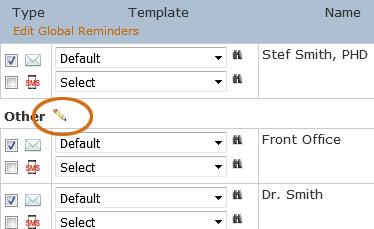Manual Index
-
Chapters
The Manual is divided into seven chapters. Click a chapter title to display that chapter's table of contents in the area below.
Chapter Six
Calendar
Left Nav
Hamburger Menu
PSYBooks Manual
Chapter Six
Intro to the Calendar
What this isCalendar is one of the sections of the global nav. The Calendar section of the app allows you to keep track of all of your appointments and other events. You can schedule appointments (including repeating appointments), set reminders and choose different colors for different appointments to help you stay organized.What it looks like |
Where this isYou can access the Calendar from the global nav at the top of every page or from the Sitemap links at the bottom. |
PSYBooks' Calendar is actually a collection of tools for therapists that goes beyond just scheduling appointments. For example, you can add both sessions and client payments right from the Calendar, making it an ideal way to keep track of daily tasks. Your Calendar is designed to allow you to see at a glance whether each appointment is for a client, a therapy group, a business meeting or some other kind of event. Additionally, appointments are coded so you can see which ones are to take place in your office and which are video or phone meetings. There are many ways you can customize the Calendar, i.e., by choosing how you want your clients' names to appear, by color-coding certain events, by deciding whether or not to set appointment reminders, etc. There are also tools that allow you to search and to print your calendar.
In short, the Calendar page in PSYBooks is so comprehensive that some days, it may be the only page in the app that you need to visit. 
Appointment Blocks
What this isAppointment Blocks are added to your Calendar automatically when you add an appointment. Depending on various choices made on the Add Appointment tool, the resulting Appointment Block on your Calendar will display a variety of tools to give you information about the appointment. Client Appointment Blocks also have tools that allow you to add sessions and client payments right from the calendar, helping to streamline your workflow.What it looks likeThe example below shows one day with six Appointment Blocks: 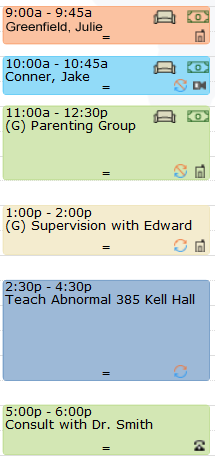 |
Where this isYou can access the Calendar from the global nav at the top of every page or from the Sitemap links at the bottom. |
Appointment Block Structure & Tools
Appointment Blocks are designed to give you maximum feedback and functionality for each appointment you enter. The specific icons present on any given appointment vary and depend on several things but all Appointment Blocks have the same basic structure. The example below is what a repeating client appointment that takes place in the therapist's office might look like:
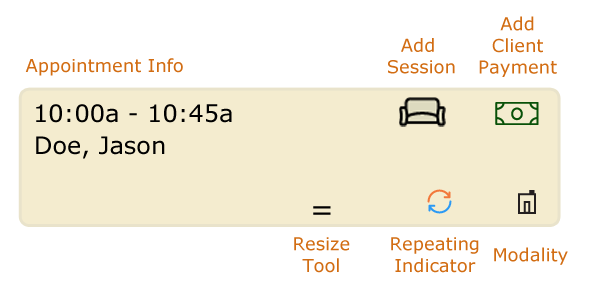
The Add Session and Add Client Payment tools are of particular interest. They do two things:
- They allow you to do most of your daily tasks right from your Calendar - no need to switch back and forth to other pages in the app.
- They serve as a quick visual checklist so you can see what tasks you've finished for the day and which ones still need to be completed.
Each of these tools will be discussed below.
Appointment Info
On the left of each Appointment Block is the information you see on any online calendar, i.e., the start and stop times of the appointment and the name of the encounter. In addition to client appointments, PSYBooks also allows you to enter appointments for groups (both therapy and non-therapy), events, and meetings with non-client individuals:
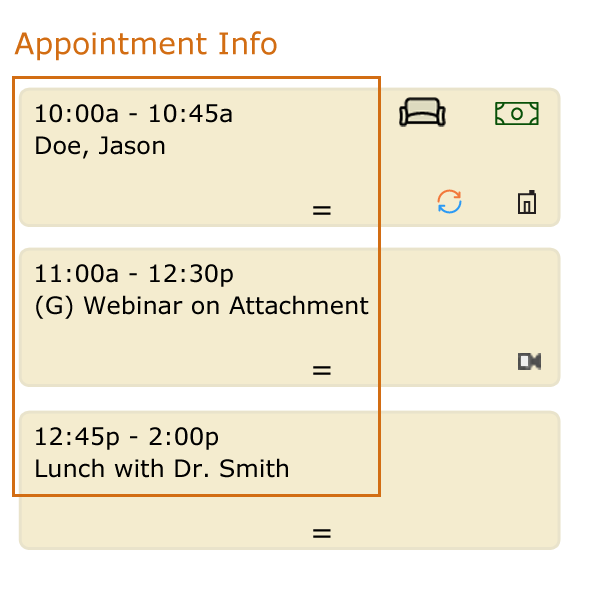
Add Session
The Add Session tool - the couch icon - only appears on Appointment Blocks of clients and groups that are marked as therapy groups - in other words, appointment types where you are likely to want to enter one or more sessions after the encounter. In the screenshot below, the top appointment is the only one that's a client appointment so it's the only Appointment Block with the couch. The second appointment is a group (as indicated by the (G) in front of the event name), but the therapist has not marked it as a therapy group so it doesn't have the Add Session tool:
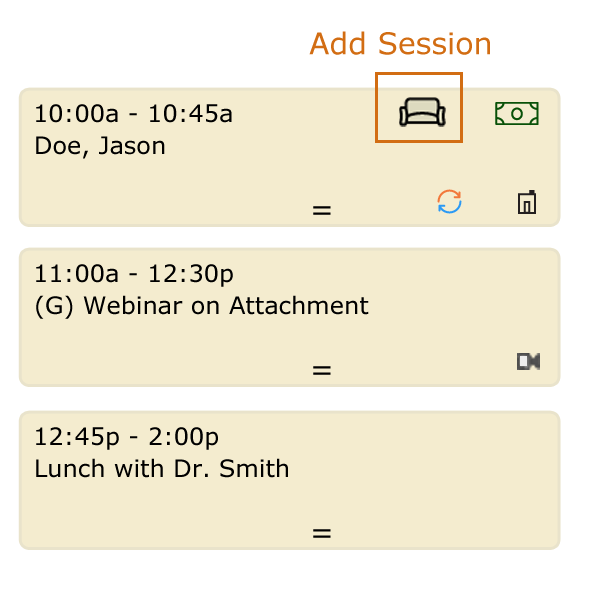
The Calendar form of Add Session is both a functional tool (i.e., you can add a session by clicking the couch icon) and a status tool, allowing you to see whether you've finished the session tasks for this appointment. As with the regular Add Session tool on the Charts page, you cannot add sessions for future times or dates. Sessions can only be added after the time of the encounter has passed. If you click the Add Session tool for a future appointment with an individual client, you get this alert:
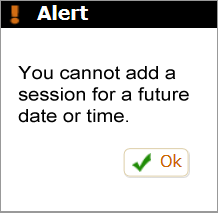
If you click the couch icon for a future therapy group appointment, although you're still not allowed to enter sessions, a form opens that allows you to notate any cancellations you may have received from members of the group. This will be discussed in more detail below.
On the Appointment Block, there are three possible states of the Add Session tool: Default, Pending and Finished. Each state will be discussed separately:
Add Session: Default
The Default state of the Add Session tool appears on the Appointment Block when you first enter the appointment on your Calendar. It looks like this:

For individual appointments, assuming the time of the session has passed, clicking the Default state of the Calendar's Add Session icon opens the regular Add Session tool - exactly the same as if you had opened it from the Charts page. You will be able to do all the things you can normally do with the Add Session tool - add a client payment, efile, create a client statement and/or receipt, add your session notes, etc. All of those tasks can be done right from the Add Session tool on your Calendar.
For group therapy appointments, as mentioned above, if you click the Add Session tool for a future group appointment, you're allowed to enter cancellations but nothing else. The window for a future group therapy appointment will look something like this:
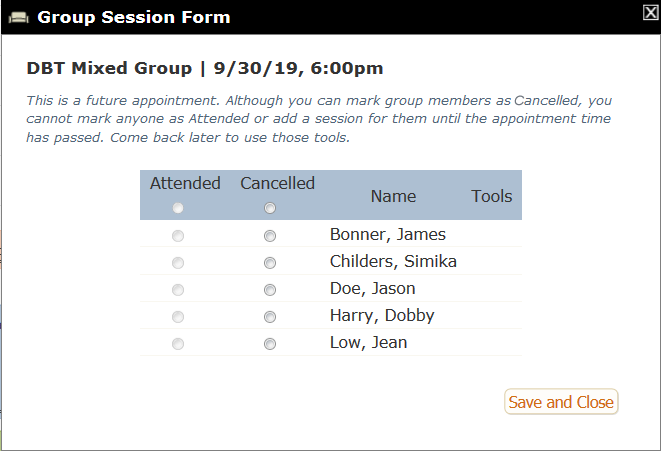
If the time for the group session has passed, you get the same window, but with the full set of tools, allowing you to complete the attendance roster and also to add sessions for those who attended.
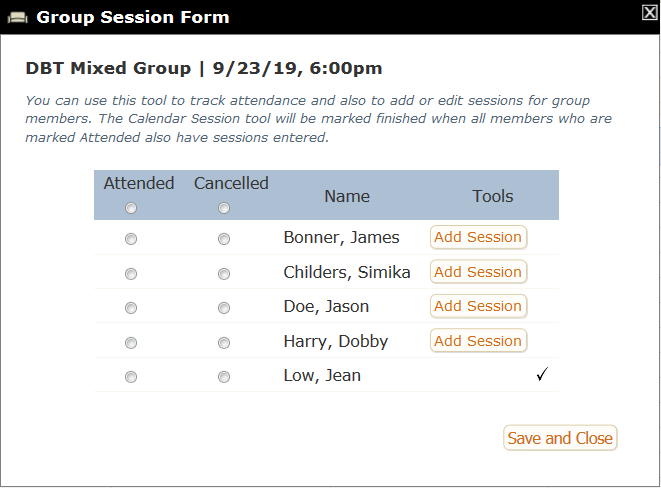
The last person on the list, Jean Low, has a checkmark in the column where the other group members have Add Session tools. The only situation that could produce this is if Jean is not a client. Perhaps she's an admin who's been added to the group roster for some reason. She might also be a co-therapist, a supervisee, a presenter in the group, or any other non-client individual who has been added as a member of the group. You cannot enter sessions for non-clients so Jean's session task is marked finished by default. Her session is finished regardless of her attendance status.
Add Session: Pending
The goal of the Pending state is to alert you to the fact that although you've done some work on the session(s) for this encounter, you have unfinished tasks. It's triggered a bit differently for individual vs group therapy appointments, but it looks the same on both:

-
Individual Appointments
When you click the Add Session tool on an individual client appointment, the regular Add Session tool opens. This is exactly the same tool as is on the Charts page. Having it here just allows you to stay on your Calendar instead of having to switch back and forth. For individual appointments, the Pending state gets triggered when you place a session in the Process Claims & Statements tool awaiting further processing. In other words, although the session has been entered, the Pending state is a reminder that you're not finished with it. It hasn't been fully processed. Notice that not all sessions will pass through the Pending state. If you process the session completely when you first create it and don't use the Process Claims & Statements tool, the status symbol on individual appointments will go straight from Default to Finished.
-
Therapy Group Appointments
Unlike the functionality for individual appointments, when you click the Add Session tool on a group therapy appointment, you get a window that looks something like this:

Notice that this form allows you to indicate each group member's attendance. Any cancellations which were previously entered would show up here. The Add Session tool is present for all clients in the group. The group session task will be considered to be finished when sessions have been completely processed for all clients who were actually present.
Clicking Cancelled from this tool does exactly the same thing it does if you cancel an appointment with the Manage Groups tool, i.e., it opens a new area beneath that person's row for you to indicate whether this cancellation is for a single appointment or a series of appointments. It looks like this:
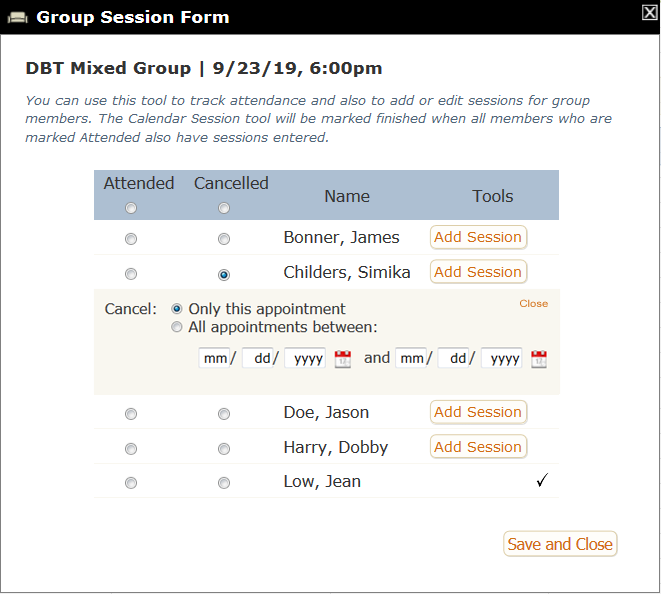
This allows you to mark just this one appointment as canceled or to cancel a block of appointments. Your choice is saved automatically. It's not necessary to use the "Save and Close" button at the bottom until you're totally finished with all tasks. When you close the gold cancellation section, the screen below now looks like this:
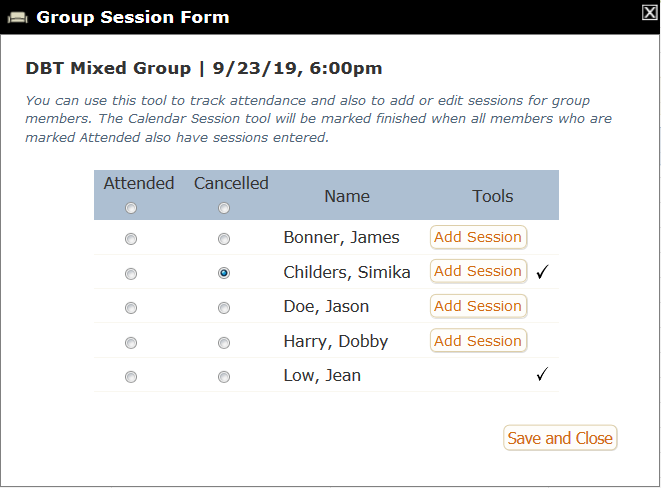
Notice that although the canceled appointment is now marked as Finished, it's still possible to enter a session. Although adding a session isn't necessary, users who like to enter sessions with custom procedure codes to designate no-shows and different kinds of cancellations may find it helpful. Being able to add a session also enables the therapist to charge for the missed appointment.
Let's assume that the therapist now wants to enter the session for the first person on the list. They click the Add Session button in James Bonner's row, fill out the Add Session form and submit it. Doing so would produce these changes on the Group Session Form:
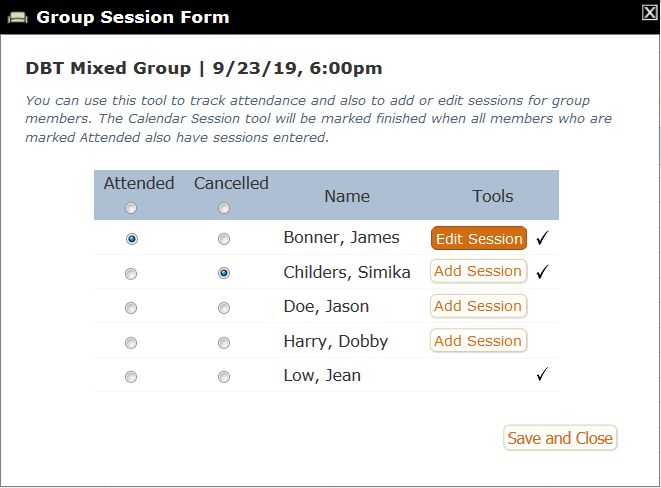
James Bonner's Add Session tool has become an Edit Session tool, indicating that the session has already been added. It can be viewed, or in some cases, edited by clicking the Edit Session button. There's also a checkmark on his row, indicating that the session has finished processing, i.e., the user did NOT put this session in the Process Claims & Statements tool. James is also now marked as having attended the group. The therapist may have done that manually when they entered the session, but also, by default PSYBooks marks all clients who have sessions entered as Attended. If this is not correct, the user can change the attendance to Cancelled and everything else will remain the same. The screenshot below shows that scenario, i.e., Jason Doe's row shows that he did NOT attend the group and yet a session has been entered:
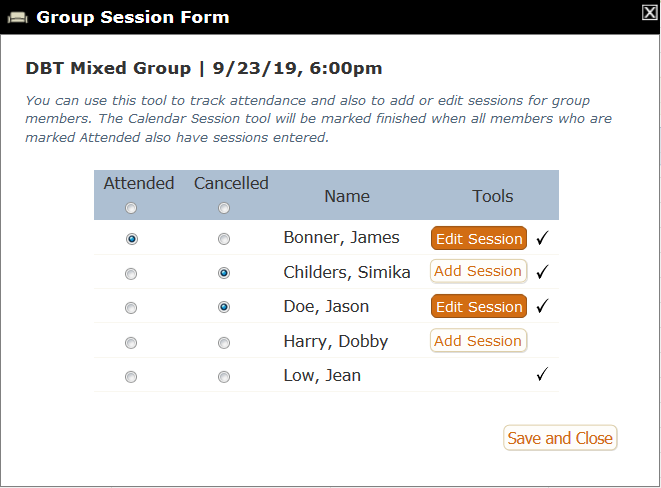
Remember that since canceled appointments are always considered finished, the user didn't have to enter this session. They must have had a personal reason for doing so - perhaps to enable them to collect a payment for the session.
The screenshot above has one remaining client, Dobby Harry, whose session hasn't been begun. Let's assume the therapist enters Dobby's session but needs to put it in the Process Claims & Statements tool while they check on something. The resulting screenshot for that situation would look like this:
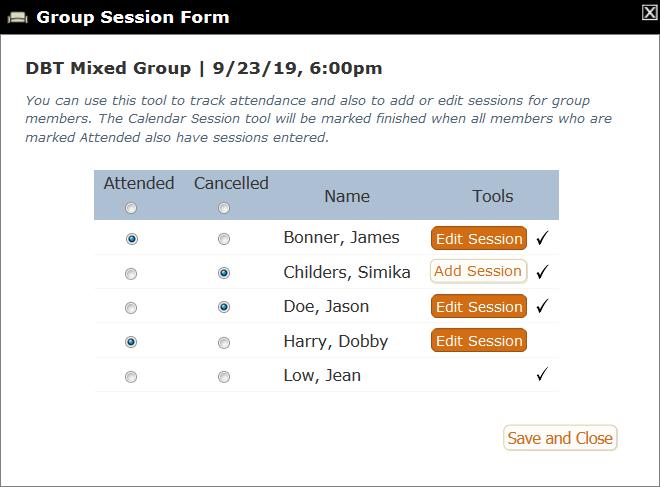
As you might have guessed, what's happened here is that although the session has been created (as can be seen by the presence of the Edit Session tool), there's no checkmark in the category where other sessions have been marked as Finished. This one session is still in the Pending state, which will keep the whole group in Pending (i.e., the couch icon on the Appointment Block will have the "!"). This alerts the user that there's at least one task they still need to complete before this group can be marked as Finished.
To summarize, for group therapy appointments, the couch icon on the Calendar stays in the Pending state until all available sessions for each member who attended the group have been completely processed. If there's at least one session that either hasn't been started or has been placed in the Process Claims & Statements tool, there are still tasks for you to do, so the session status remains in the Pending state on your Calendar.
-
Add Session: Finished
The session task is considered complete when it's been processed to a payer - usually either an insurance company or the client. The Finished state of the Add Session tool has a checkmark beside the couch, giving you a quick, visual confirmation that you've completed that task:

Notice that when you process a session directly to the client, it's not necessary to create a client statement. The session is considered "Finished" as soon as you process it. Creating a client statement is optional. However, to achieve a Finished status, no sessions can be in the Process Claims & Statements tool.
As discussed above, with therapy groups, all sessions for all clients who attended must be completely processed to achieve the Finished state.
Add Client Payment
The basic idea behind the Add Client Payment tool is the same as the session tool, i.e., to allow you to enter a client payment right from the Calendar and also to give you feedback to let you know when you've finished with those tasks. As with the session tool, the Add Client Payment tool only appears on appointments designated for clients and/or for therapy groups. They will not appear on non-clinical appointments such as those designated as Events, Other Person or non-therapy groups:
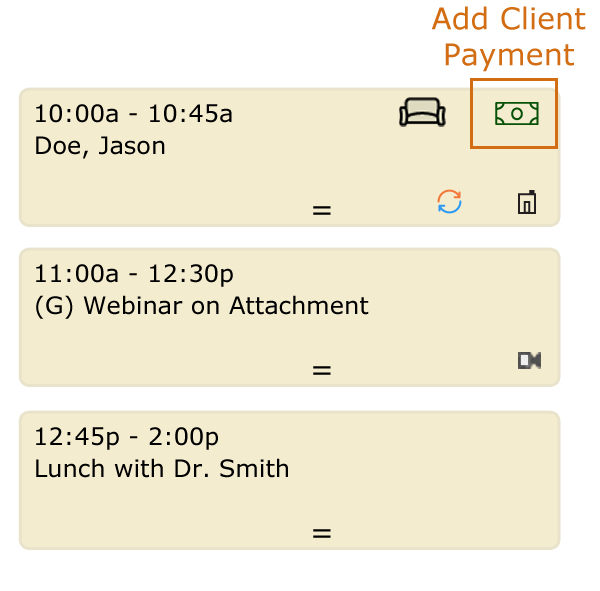
Insurance payments are not included with the Appointment Block tools since you would not receive the insurance payment for this appointment at the time of the actual encounter. Insurance payments come in later, so there's no need to track them here. You can add insurance payments with the Add Payments & Allocations tool on the Charts page.
As with the session tool, there are three states for the Add Client Payment tool: Default, Pending and Finished.
Also, since the Add Client Payment tool on the Calendar is meant to let you know the status for the payment on that particular appointment, if you try to add the payment before the session has been entered, you'll get this alert:

Add Client Payment: Default
The Default state of the Add Client Payment tool appears on individual client and group therapy Appointment Blocks when they are first created. The Default State looks like this:

Add Client Payment: Pending
Using the same symbol as was done with the Add Session tool, the Pending form of the Add Client Payment tool looks like this:

Also, as with the session tool, there are slightly different variations depending on whether you're entering client payments for an individual appointment or for a group.
-
Individual Appointments
There are many possibilities with client payments. For example, a client might pay for today's session plus add some for back payments. Some clients pay ahead. You may be billing the client for your standard rate but writing off some or all of it. In some cases, insurance covers the entire bill so there IS no client payment. Because of the number of variations, it would be hard for us to know when a client payment is finished unless you tell us. For that reason, the first screen you see when you click the Add Client Payment tool from the Appointment Block is a small screen asking if you want to mark this task finished:
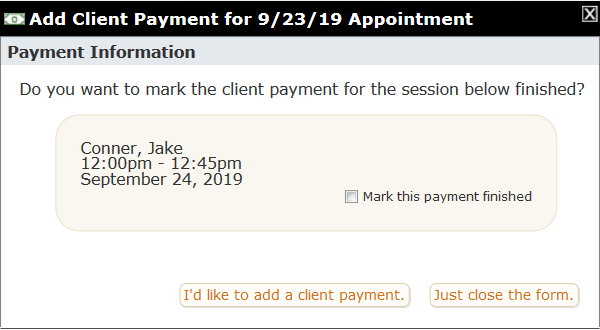
Notice that this screen also has buttons allowing you to add a client payment if you choose. Marking the payment as finished and actually entering a payment are completely independent processes. PSYBooks does not require you to do either. The "Finished" feature is provided as a user-aid, allowing you to keep track of the remaining tasks you need to do. In cases where you don't expect a client payment for that session, you might want to mark the payment finished even though you don't enter a payment. Similarly, if the client makes a partial payment, you might want to leave the Finished checkbox unchecked even though you enter a payment - just to remind yourself that there's more to collect from the client. The Payment Finish Tool is reversible, i.e., if you mark it as finished and then change your mind, you can always uncheck the box.
If you do choose to add a client payment, clicking the first button will open the regular Add Client Payment form that you're used to seeing.
-
Therapy Group Appointments
There are two things to remember about entering payments for groups from your Calendar:
- You can't enter a payment for a group member until after you've entered a session for them.
- If you have non-client members in your group, since you won't be able to add sessions for them, you also will not be able to add payments.
Unlike sessions, client payments do NOT correlate directly with attendance. This allows you to enter payments (or not) for group members who were present as well as for those who weren't. Again, you're in charge of deciding which payments are finished - we don't automatically enter this value. When you click on the Add Client Payment tool of a group appointment, the window that opens might look something like this (continuing with the group we discussed in the section above on adding sessions for groups):
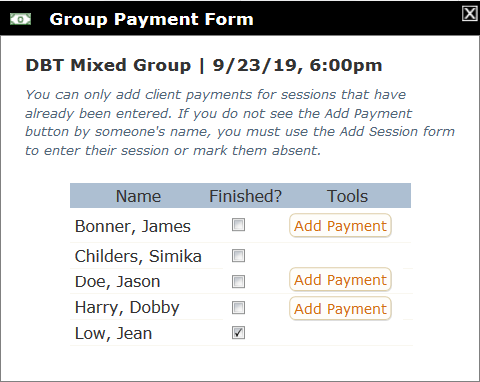
At first, this form is confusing because whereas some rows have one or more tools, others do not. It could be that sessions haven't been entered for everyone in the group yet. To understand the possible implications, we'll consider each row separately.
To begin, we need to learn a bit more about attendance. Even though client payments aren't directly correlated with attendance, there's an indirect way in which they are. The screenshot above was taken from the Group Session Form for the same date. The image below shows both forms:

Here's how the two work together:
Looking at the Group Session Form, we can see that the first person, James Bonner, is marked as having attended the group and his session for this group has been entered. (There's a checkmark and an Edit Session tool on his row instead of an Add Session tool.) Since a session has been entered, the user can add a client payment for that session, thus explaining why there's a checkbox to mark his payment finished and also an Add Payment tool on his row in the Group Payment Form.
The second person, Simika Childers, was marked as Cancelled on the Group Session Form. Although it's possible to add a session with a Cancelled attendance status, the user did not choose to do so. Since client payments entered from the Calendar depend on having the session entered first, the Add Payment tool will not appear on Simika's row on the Group Payment Form.
If the user needs to enter a client payment for Simika, they could go back to the Group Session tool and add a session for her. Since sessions can be entered with the Cancelled attendance type, entering a session would enable them to also enter a client payment. Another option is to add a client payment on the Charts page with the main Add Payments & Allocations tool. Since payments added from Charts aren't tied to a specific session, you have more leeway in what you can add.
Notice that even though you can't add a payment for Simika, you can mark the payment task as finished. Those are independent processes.
- The third member of the group, Jason Doe, was also marked as Cancelled, but unlike Simika, the user chose to add a session for Jason. For this reason, it's possible to add a client payment for Jason from the Calendar tool. Notice that his Finished box is not checked. Remember that it's up to you to tell us whether a client payment is finished. Unlike with sessions, the finished status on payments is not a value we enter automatically except in the case of non-clients.
- The fourth member is Dobby Harry. This is the client whose session is still in the Process Claims & Statements tool so they do not have a checkmark on the Group Session Form indicating that their session is finished. However, because the session has been started, the user can add payments to Dobby's account and/or mark his payment as finished. In this way, the session and payment tools work independently, i.e., it's possible for a payment to be finished before the session is.
- The final group member, Jean Low, is a non-client. Since it's not possible to enter sessions for non-clients and since payments can only be added after a session has been entered, that means it's also not possible to enter payments for non-clients. For this reason, Jean Low's Finished status has been automatically set and there's no Add Payment tool on her row.
Add Client Payment: Finished
Going back to the Add Payment tool on the Calendar, the Finished state of both individual and group appointments has a checkmark beside it like this:

To trigger the Finished state, all client payments for that appointment have to be marked as Finished.
-
Link to Chart
Client appointment blocks have links to take you to the client's chart in case you want to check your notes, the client's balance, or anything else in the chart while you're on the Calendar. The client's name will have an underline to indicate that it's a link:
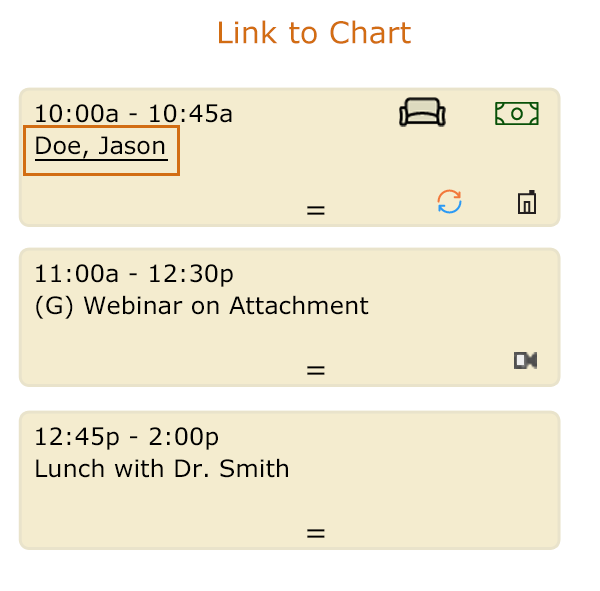
Resize
The Resize tool is a standard tool on online schedulers. It allows you to click and drag the bottom border of an Appointment Block to make the appointment shorter or longer. It appears on all appointment types in PSYBooks:
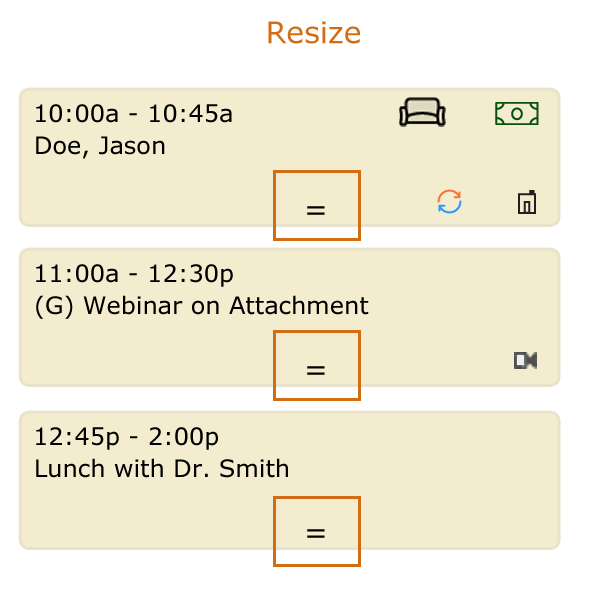
Repeating Status
The Repeating Indicator icons are status tools to tell you whether the appointment is a single event, a repeating event of some type, or part of a repeating event that's been changed for this particular appointment. They look like this:
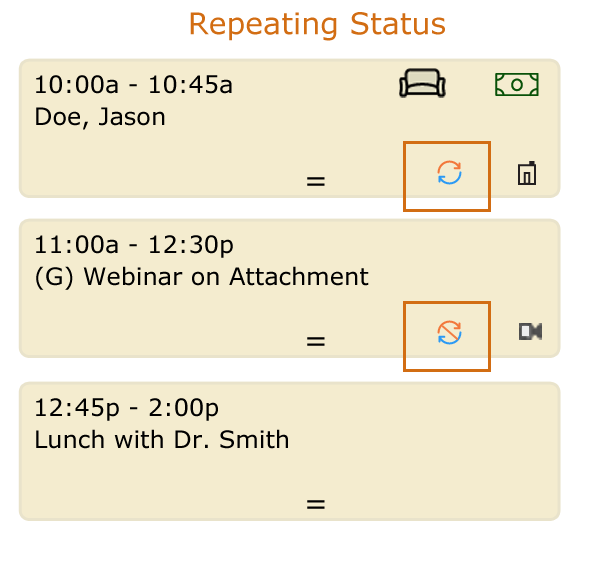
In the example above, the top appointment is a client and is part of some type of series of appointments. The client may come weekly, monthly, daily - whatever - we would have to actually open the appointment to see the exact nature of the series. However, the Repeating Indicator icon on the Appointment Block lets us know that the appointment does repeat.
The next Appointment Block down - the Webinar on Attachment - has an icon indicating that although this, too, is part of a series of Webinars, this particular appointment is different in some way. The "broken repeating" icon gives us that information. Maybe the webinars are normally on Tuesdays and this one is on Wednesday. Maybe they're normally two hours and this one is only 1 1/2 hours. We'd have to investigate further to find out exactly how this one appointment is different from the others, but the broken repeating icon lets us know that it is.
Notice that Repeating Indicators can appear on any appointment type that repeats: client appointments, therapy and non-therapy groups, events, and appointments with non-clients. For example, in the screenshot above, if the "Lunch with Dr. Smith" is part of a series, it would also have the Repeating Indicator.
Modality
There are four different appointment modalities supported by PSYBooks: you can have an appointment in your office, via video, by phone, or "other." This icon is the last one on the bottom row:
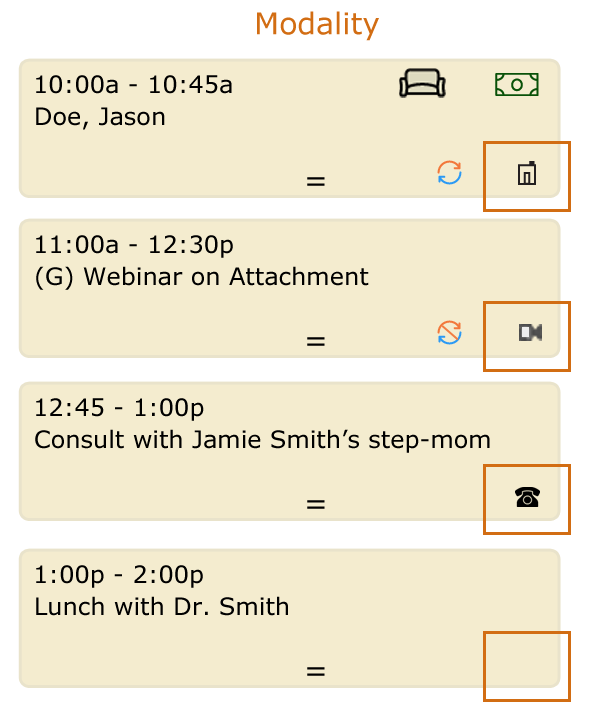
In the screenshot above, the top appointment is indicated as taking place in the therapist's office, the second one is a video session, third is a phone consult, and the last one is an "Other" (which has no icon).
There are actually three possible video icons - one for each of the two PSYBooks video products (Connect and SecureVideo), and a 3rd that will appear if you indicate that you're not using a PSYBooks video product. They look like this:
- PSYBooks Connect icon:

- SecureVideo icon:

- Non-PSYBooks video icon:

PSYBooks video icons are clickable, allowing you to start your video session right from your calendar. It is not necessary to go to a different page in the app to begin your session. In contrast, a solid video icon means that you indicated that you're using some other type of video (i.e., not PSYBooks) for this particular appointment. Solid video icons are not clickable. You'll need to open whatever program you intend to use to start your video session and afterwards, come back to PSYBooks to enter any other data pertaining to the session.
The Show/Hide Top Icons Toggle
The complete set of icons on each Appointment Block is visible in both the Daily and Weekly Calendar views. Depending on your screen size, there may be times when you want to hide the top row of icons (Add Session and Add Client Payment) if they are overlapping other parts of the Appointment Block. For that reason, there's a Show/Hide Top Icons link at the top of the Calendar that you can toggle on or off. It allows you to hide all Add Session and Add Client Payment icons if they are in your way.
The top screenshot below shows a portion of a PSYBooks Calendar with the Add Session and Add Client Payment icons visible. Notice that the link says "Hide Top Icons." The bottom screenshot shows the same Calendar with the top icons turned off. The link now says, "Show Top Icons," allowing you to make the icons visible again at any time:
![]()
Hiding the Add Session and Add Client Payment icons doesn't affect their functionality in any way. For example, if you've already completed some tasks with those tools but need to hide them momentarily, when you click "Show Top Icons" to make them visible again, all of the previously entered tasks will still be there.
Putting it all Together
For those of you wanting a quick overview of all of the possible tools in an Appointment Block, we'll consider the screenshot below. This was taken from a factitious PSYBooks subscriber we'll call Dr. Jones, who has a small private practice and also teaches at a university.
 When Dr. Jones opens PSYBooks for the day, she can see her entire schedule at a glance. This particular day starts at 9am and ends at 6pm. Her 9am appointment is with someone named Julie Greenfield. We know right away that this is some type of clinical appointment because it has the Add Session (couch) and Add Client Payment (dollar) tools on it. Since there's no (G) by the appointment name, we know that this is an appointment with an individual client. We can also see that the appointment is to take place in Dr. Jones' office (because of the Modality icon) and that it's not part of a series. This is a stand-alone appointment Dr. Jones has with a client named Julie Greenfield.
When Dr. Jones opens PSYBooks for the day, she can see her entire schedule at a glance. This particular day starts at 9am and ends at 6pm. Her 9am appointment is with someone named Julie Greenfield. We know right away that this is some type of clinical appointment because it has the Add Session (couch) and Add Client Payment (dollar) tools on it. Since there's no (G) by the appointment name, we know that this is an appointment with an individual client. We can also see that the appointment is to take place in Dr. Jones' office (because of the Modality icon) and that it's not part of a series. This is a stand-alone appointment Dr. Jones has with a client named Julie Greenfield.
The second appointment of the day is with Jake Conner. This is also a client appointment but this one has the video icon in the Modality area so we know that this must be a telehealth appointment. We can see that Dr. Jones is using PSYBooks video for this appointment (since there's a transparent area in the camera icon), so she'll be able to access her telehealth platform right from her PSYBooks app. We can also see that this is a broken repeating appointment. That means that although Jake seems to be a regular client - or at least has a series of appointments set up - this particular encounter has been altered in some way.
Dr. Jones' 11am appointment is listed as a Parenting Group. Since there's a "(G)" by the title, we know that this is indeed a group of some sort. Since the couch and dollar icons are present, we also know that this is a therapy group as opposed to some type of non-therapy group. Dr. Jones will be able to enter the sessions and also the client payments for each member of the group right from this Calendar page. The Parenting Group meets in Dr. Jones' office and is also a broken repeating appointment.
The 1pm appointment is also listed as a group but since the Add Session and Add Client Payment tools aren't present, we know that it is NOT a therapy group. The title of the encounter is Supervision with Edward so we can assume that perhaps Dr. Jones wanted to make this encounter into a group for some other reason. This is another appointment in Dr. Jones' office and is a repeating appointment.
The next appointment is the first non-clinical appointment of Dr. Jones' day. Since the title is "Teach Abnormal 365 Kell Hall" we can guess that this is a class that Dr. Jones is scheduled to teach. Notice that there's no Modality icon. This means that Dr. Jones has marked this as an "Other" modality. She has given herself a reminder of where the class meets in the way she wrote the appointment title (365 Kell Hall). As might be expected with classes, this appointment repeats.
Dr. Jones' final appointment of the day is a telephone consult with someone named Dr. Smith at 5:00pm. Dr. Jones could have followed her earlier precedent and used the appointment name to include Dr. Smith's telephone number, but perhaps she doesn't need that.
We also notice that Dr. Jones has color-coded each of her appointments differently. We're not sure why she chose the colors she did and in fact, this looks a bit random. Some users might have wanted to make all clinical appointments one color and everything else something different - or perhaps make all classes a specific color - or any other system that might help them differentiate their appointments. It almost looks like Dr. Jones just chose colors she liked - which is certainly another way to do it.
No matter how you use the PSYBooks Calendar, it's designed to be a "delighter" - something that not only makes your office tasks easier, but that also adds a little fun. 
As you can see, there's a wealth of information in PSYBooks' Appointment Blocks. In addition to providing information, Appointment Blocks for clinical appointments have tools that allow you to enter both sessions and client payments right from the Calendar, helping to streamline your workflow.
Search Calendar
What this isThe Search Calendar tool allows you to easily find client appointments and/or other events you've scheduled with your PSYBooks calendar.What it looks likeThe Search Calendar tool appears on all pages in the Calendar (Daily, Weekly and Monthly) and looks like this:  |
Where this isYou can access the Calendar from the global nav at the top of every page or from the Sitemap links at the bottom. The Search Calendar tool is at the top right of each page. |
The Search Calendar tool has two sections:
- A textbox for your search string with a tool to click to begin the search
- A link for more options
Both are illustrated below:
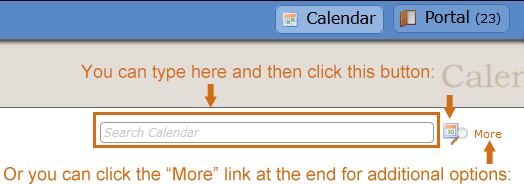
If you click the "More" link, the window that opens looks like this:

The options here allow you to:
- Use a client select box to look for a specific client
- Use the "or type here" textbox to write whatever you want
- Select a date range for the search
- Choose the calendar to search (only GOI accounts have the possibility of having more than one calendar)
- Choose whether you want to search all events on the calendar, only client appointments or only non-client events
The "or type here" textbox on the top line will search both client appointments and events unless you've specifically limited your search to only clients or only non-client events. For example, if you type "Sally" in the textbox, it will bring up all client appointments for a client named "Sally Brown" just as if you had used the client select box to enter Sally Brown's name. However, by typing "Sally" in the "or type here" textbox, your search will not be limited to Sally Brown's appointments. It will also find appointments for ALL clients who have Sally in their name as well as an entry for an event you titled "Lunch with Sally".
Performing the search above, limited to the month of Oct, 2013, might produce results similar to this:
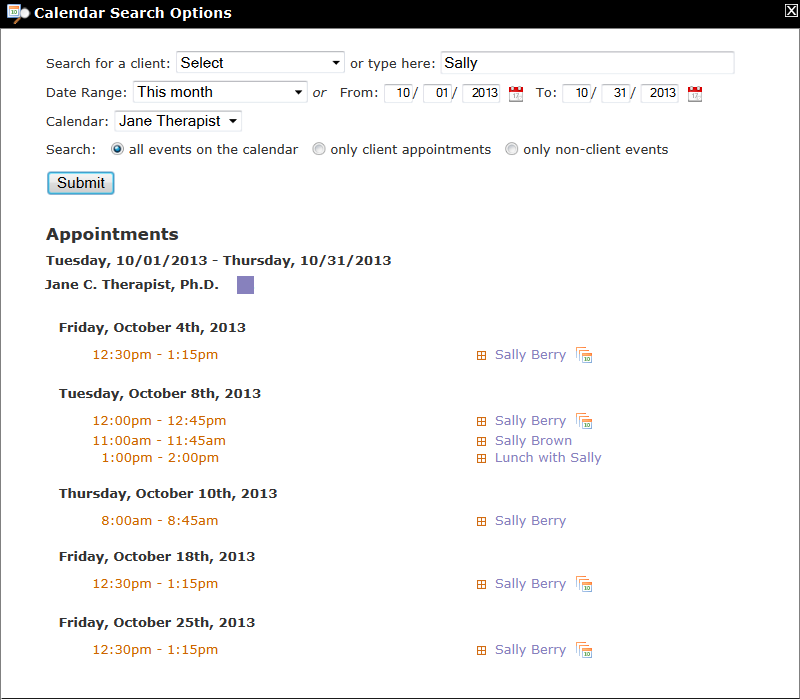
Clicking a time link on any appointment will take you to that page of the calendar. Also, clicking the little red box with a plus in the middle (![]() ) will give you some edit tools so you can make changes in the appointment right from the search results page such as shown below for Sally Berry's appointment on October 10, 2013:
) will give you some edit tools so you can make changes in the appointment right from the search results page such as shown below for Sally Berry's appointment on October 10, 2013:

You can change the appointment color simply by clicking a different swatch. The Edit and Delete buttons are also available should you need additional functions.
Calendar Settings
What this isThe Calendar Settings tool allows you to change global settings to your calendar such as the name of your calendar, how your client names appear on the calendar, the default color of appointments, calendar sharing, etc.What it looks likeThe Edit Calendar Settings tool is the top tool of the left nav of the Calendar section: 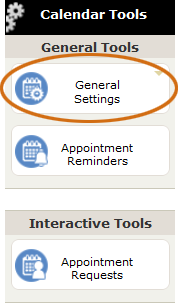 |
Where this isYou can access the Calendar from the global nav at the top of every page or from the Sitemap links at the bottom. The Calendar Settings tool is on the left nav in the Calendar Settings section. |
Clicking on the tool above opens this form:
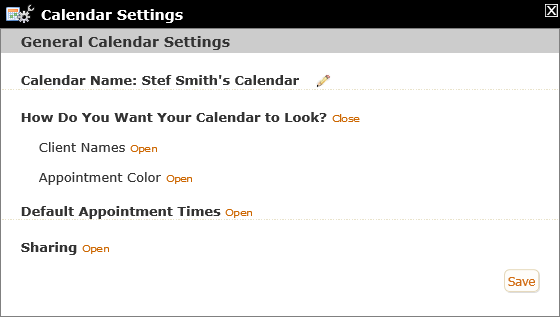
The Calendar Settings tool has four main sections: Calendar Name, How Do You Want Your Calendar to Look?, Default Appointment Times and Sharing. Each will be discussed below.
- Calendar Name
By default, your calendar is given the name listed in your Therapist Profile. However, you can change it to whatever you want by clicking the Edit Calendar Name tool. Clicking the tool will open a small textbox that's pre-populated with the current calendar name, making it easy to change it to whatever you wish:
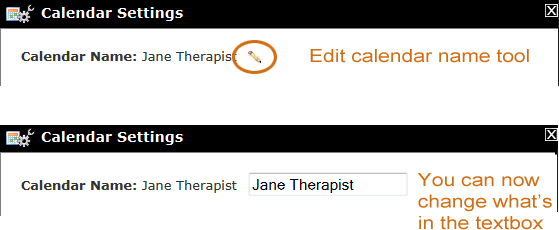
- How Do You Want Your Calendar to Look?
This category is divided into two sub-categories: Client Names and Appointment Color.
- Client Names
PSYBooks gives you a lot of control over how your client names are displayed on the calendar with the following section of the Client Settings tool:
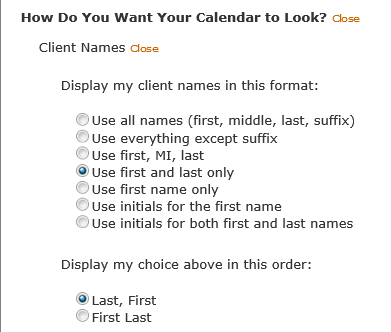
For example, if you have Jim Carl Brown, Jr listed as one of your clients, by changing the top group of settings above, you can have his name displayed as any of the following:
- Jim Carl Brown, Jr
- Jim Carl Brown
- Jim C. Brown
- Jim Brown
- Jim
- J. Brown
- J. B.
If you also change the order the names appear from the default (First Last) to Last, First, you have these additional possibilities:
- Brown, Jim Carl Jr
- Brown, Jim Carl
- Brown, Jim C.
- Brown, Jim
- Jim
- Brown, J.
- B., J.
The default setting is to use the first and last name only in the First Last order. If you don't change this setting, Jim Carl Brown, Jr's appointments would be displayed as Jim Brown.
- Appointment Color
Your calendar has a base (default) color for your appointments. You may change the color of any specific appointment as you're adding or editing it, but there will always be a base color to fall back on. Calendar base colors are actually set on your office(s), not your name. That means that if you have more than one office location where you schedule appointments, each will have its own default color to make it easier for you to identify appointments.
You can always change any default color to a color of your choice. The sample below shows a therapist with two office locations. She could change the color on either or both location by clicking a different swatch for that location:
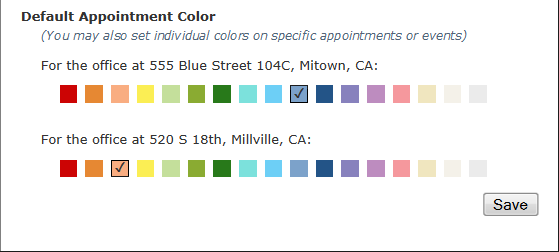
- Appointment Times
When you add an appointment, either by clicking the calendar or by using the Add Appointment tool, PSYBooks tries to make it easier for you by computing the Stop Time of the appointment from the Start Time. By default, client appointments are assumed to last 45 minutes and Other Events are an hour. This means that if you entered a session for Jane Smith with a start time of 9:00am, PSYBooks would automatically list the Stop Time as 9:45am.
Although you can't change the Other Event default setting, if your most common client appointment is not 45 minutes, you can change the client appointment default time to whatever you want with this textbox in the Appointment Times section of the Calendar Settings tool:

- Calendar Sharing
When two or more therapists share an office, there may be times when they want their office partners to be able to have access to their calendars. In the example below, two therapists are listed: Stef Smith and Gustav Smirnov:
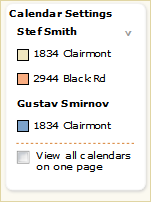
Stef is listed first because this is her account. She has shared her calendar with her office partner, Gustav. In this case, Stef has two office locations - one on Clairmont and the other on Black Rd. When Stef comes to her calendar, the appointments in both of her offices are visible, but she can not see any of Gustav's appointments. She can click either of her office addresses (Clairmont or Black) to toggle that address on or off. If she clicks Gustav's address on Clairmont, her own calendar(s) will disappear and Gustav's calendar will appear. If, however, she checks the View all Calendars on one page checkbox, she will be able to view her own calendars and Gustav's on one page. You can read more about sharing calendars in the section on setting up GOI accounts: Sharing Calendars in GOI Accounts
Appointment Reminders
What this isThe Appointment Reminders tool allows you to create and send email and/or text reminders for clients and any other person or event on your calendar.What it looks likeThe Appointment Reminders tool looks like this: 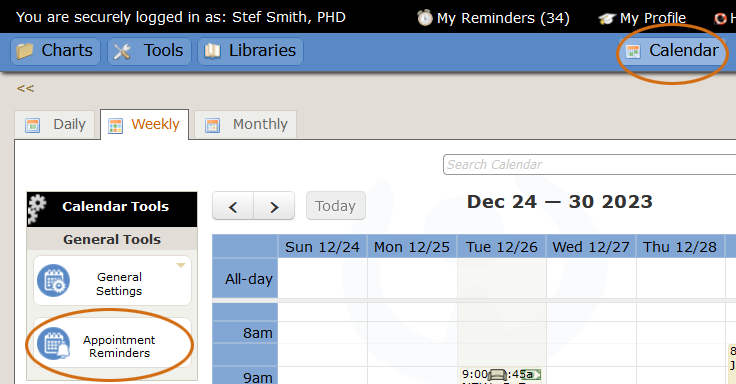 |
Where this isThe Appointment Reminders tool is on the left nav of the Calendar section of the app. |
Differences Between Text and Email Appointment Reminders
Aside from the fact that many people have personal preferences about whether they'd rather receive a text or an email appointment reminder, there is another factor to consider: length. Most text reminders are limited to a total of 160 characters. What makes this a bit challenging is that it may be difficult to accurately determine the number of characters in your text ahead of time. For example, you may decide you want to include your client's name in the reminder - maybe something like "This is to remind John Doe of an appointment with Robert C. Brown, Ph.D. on 10/03/17 at 2pm. Please call 111-222-3333 with any changes within 24 hours."
The reminder above is 151 characters, which is well within the limits of what can be sent. However, in a situation like this, "John Doe" is most likely a variable, meaning that the name of the person receiving the reminder would be inserted there. If the person receiving the reminder happens to have a name that is significantly longer than John Doe, the reminder could end up being truncated. We do warn you when we THINK you might be at risk of having a truncated reminder, but since we don't know how long the names on your appointment reminders lists may be, we're only guessing. However, as long as you are aware of the issue, you will more than likely be able to find ways around it, e.g., by shortening the whole text a bit, or possibly by only using a client's first name instead of their whole name.
Email reminders, on the other hand, can be as long (or short) as you want them to be. They will be sent exactly the way you set them up and you'll never have to worry about anything being truncated.
Getting Started with Appointment Reminders
Appointment Reminders are turned off by default. However, if you want to turn them on, all you have to do is click the Appointment Reminders tool on the left nav of the Calendar page and then click the box beside "Turn on appointment reminders:"
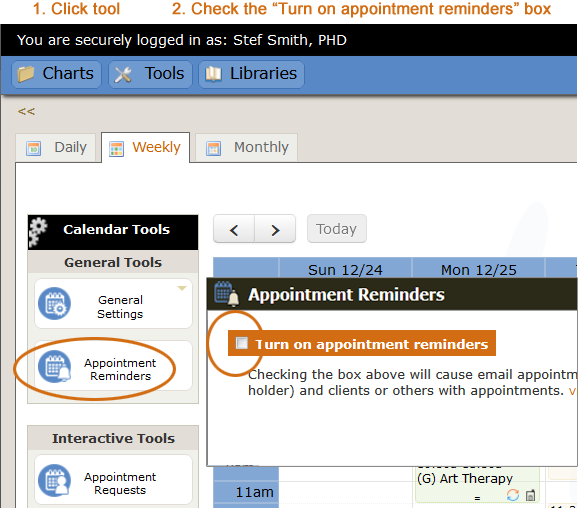
If you don't want to do anything further, email appointment reminders will be sent to both therapist (account holder) and clients or others with appointments, at these times:
- When a new appointment is made
- When an appointment time is changed
- When an appointment is canceled
- 26 hours before the appointment
- 2 hours before the appointment
In addition, the therapist will receive the following email each morning:
- Daily schedule
Edit/View Global Reminders
If you want to view or make global changes to the default reminders, you can use the "Edit Global Reminders" tool, which is a link in the blue header area of the Appointment Reminders table:
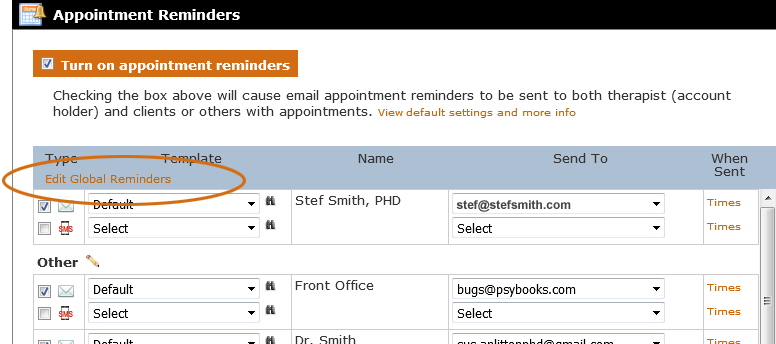
Clicking that link opens a window that looks like this - the top portion of the form is for email reminders and the bottom portion below the orange double line is for text reminders:
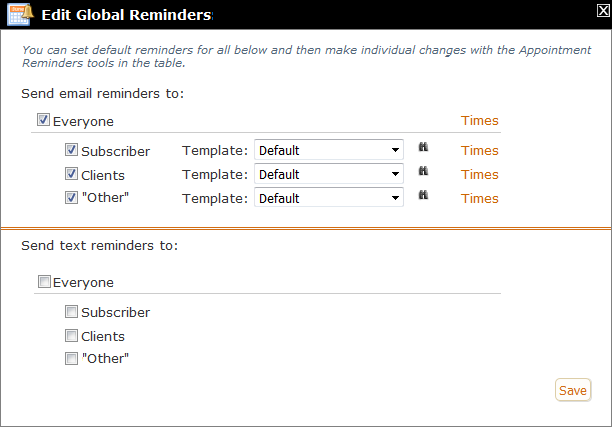
The screenshot above is what this tool looks like with the default settings. In other words, email appointment reminders are being sent to everyone and they all use the default templates. The Template and Times columns only appear when the checkbox on that row is checked. Since no one is receiving text reminders, none of those checkboxes is checked, therefore you cannot see the Templates or Times columns on those rows.
In addition to the the two large mail vs. text horizontal "rows", this form also has three columns: the category or type of appointment (i.e., Everyone, Subscriber, Clients and "Other"), the template you want to use with that category, and the times you want their reminders to be sent. In other words, if this page had PSYBooks' typical blue table headers, it would look something like this:

An Overall Strategy for Working with Appointment Reminders
If you don't want to use the default appointment reminders, a good strategy is to use the "Edit Global Reminders" form to change the global settings, then make changes to any individual's appointment reminder settings using the table. To edit the global reminders, start by choosing the category of appointment type you want to change (e.g., Everyone, Subscriber, Clients and/or Others):
Editing Global Reminders: Category
The first column on this form shows the category of appointment reminder. You can choose to send email and/or text reminders to any category. For example, you might want to change your default settings to send text reminders to yourself, but continue to use email reminders for everyone else. Since the top part of this form is for email reminders and the bottom half is for texts, the changes just described would cause the form to look like this:
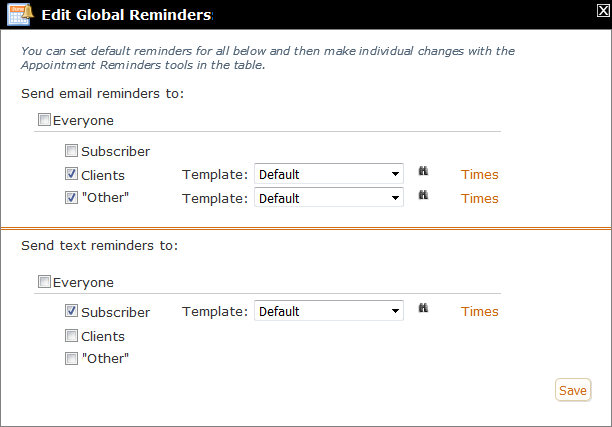
Once you've chosen the global category you want to work with, you can then change the template and/or the times on that category's row.
Editing Global Reminders: Templates
Clicking a template select box gives you options similar to these:
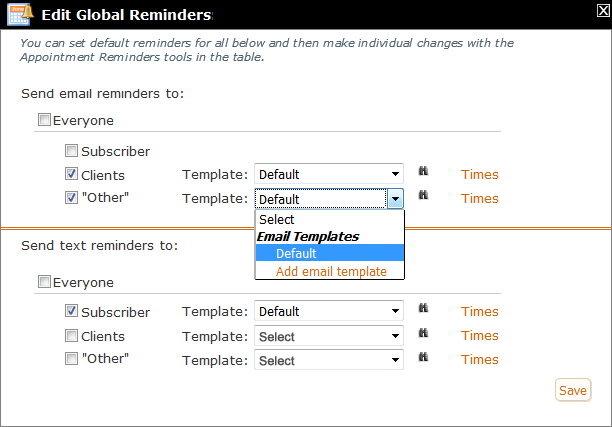
Notice that in addition to the Default template, you have the option of creating new custom reminder templates with the "Add email template" or "Add text template" links. Although adding a template is not difficult, many of the same principles are covered in viewing and/or editing existing templates, so we'll cover that first.
Viewing and Editing Global Templates
The binoculars beside the template select boxes allow you to view or edit any of your existing templates. When you first begin, the only option you'll have is the Default template, so we'll start there. If you click the binoculars beside the Default template in the Email section of the Clients row:

the window that opens would look something like this:
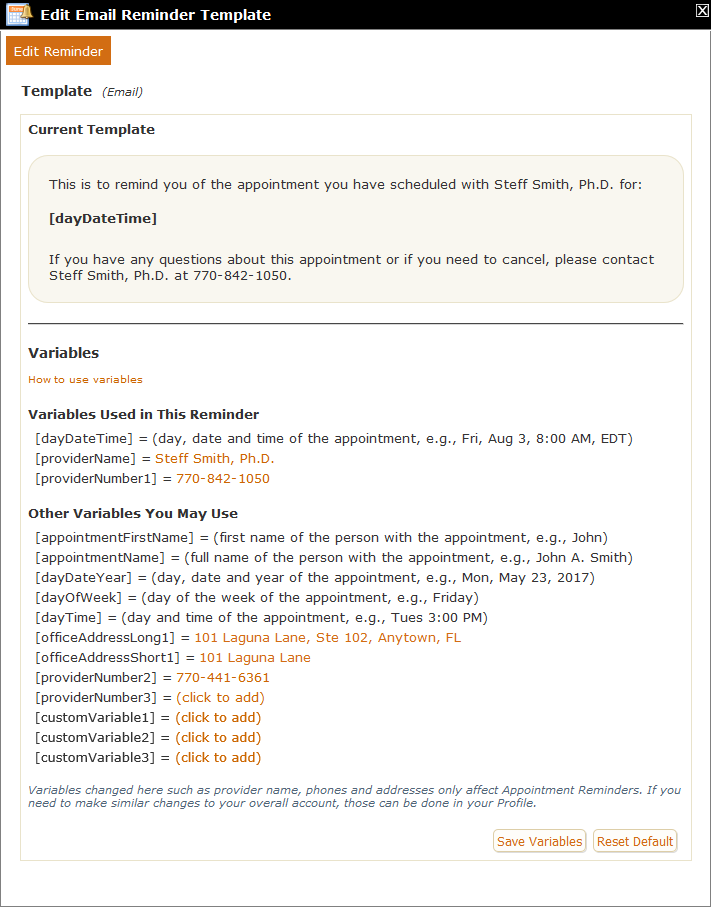
This form divides into two main sections: the Template section at the top and the Variables section at the bottom:
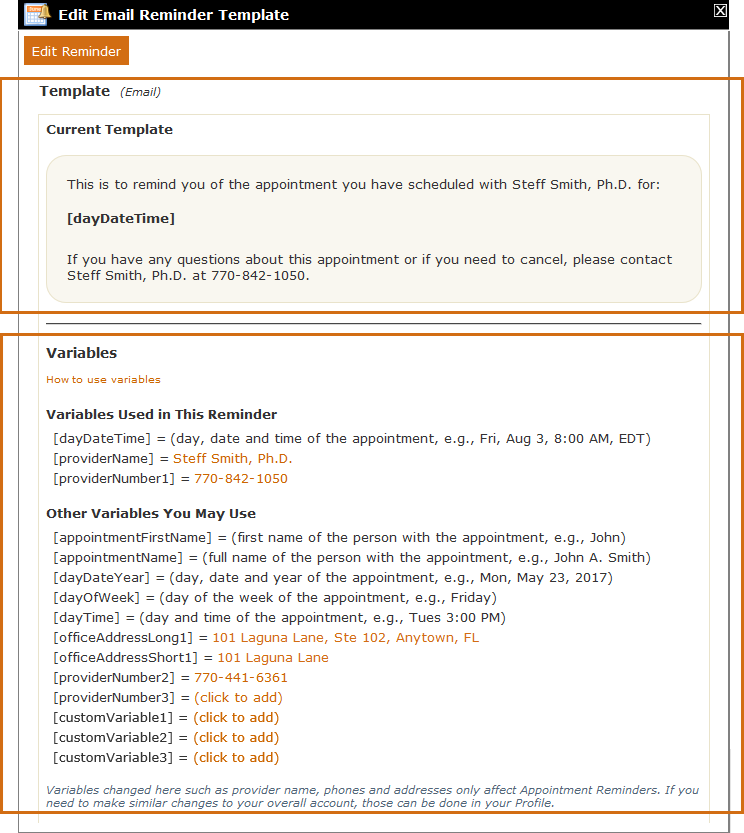
The shaded area in the Template section (i.e., the "Current Template") shows you the text of the reminder your clients would receive, for example:
Current Template:
This is to remind you of the appointment you have scheduled with Steff Smith, Ph.D. for:
[dayDateTime]
If you have any questions about this appointment or if you need to cancel, please contact Steff Smith, Ph.D. at 770-842-1050.
Your name and credentials (as they appear in your profile) would appear in place of "Steff Smith, Ph.D." and the first phone number listed in your profile would appear instead of 770-842-1050. The [dayDateTime] is a variable and would show the day, date and time of the appointment. If you have any questions about the variables used in the reminder - or if you want to make changes, you can use the "Variables" section, which appears below the "Current Template" section of the larger Edit Template form shown above:
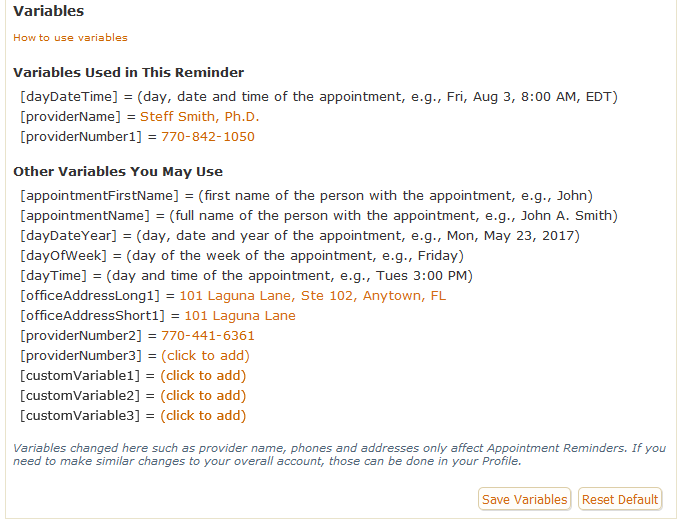
Working with Variables
The Variables section is comprised of two sub-sections: "Variables Used in This Reminder" and "Other Variables You May Use." Each will be discussed below.
Variables Used in This Reminder
Looking first at the Variables Used in This Reminder, we see an explanation of the [dayDateTime] variable and also a sample so you can see the formatting (Fri, Aug 3, 8:00 AM, EDT):

We can also see that there are two more variables used in this reminder: [providerName] and [providerNumber1]. The values for both of these variables have been obtained from the subscriber's Profile, so they have already been filled in. Putting all of this information together, we now know that the complete default email reminder that would be sent to this therapist's client would read something like this:
This is to remind you of the appointment you have scheduled with Steff Smith, Ph.D. for:
Fri, Aug 3, 8:00 AM, EDT
If you have any questions about this appointment or if you need to cancel, please contact Steff Smith, Ph.D. at 770-842-1050.
When you open this form on your own account, [providerName] and [providerNumber1] would be filled in with the information in your PSYBooks Profile.
If you are satisfied with the variables in this reminder, you don't need to do anything else. However, if you'd like to make changes to any of the variables, there are two ways to do it. You can: 1) make global changes so they populate throughout PSYBooks or 2) make changes that only affect Appointment Reminders.
- Change the Variable Throughout PSYBooks. To understand the first possibility, let's say our fictitious therapist in the example, Steff Smith, has decided she wants to include her middle initial "A" in her appointment reminders. Or maybe that's not the phone number she wants to use on reminders. If Steff wants the variable changes to affect everything in her PSYBooks account, that should be done from clicking the "My Profile" link at the top of any page. Once the profile opens, she can click her name in the table and make any changes she wants on the Edit Therapist Profile form:
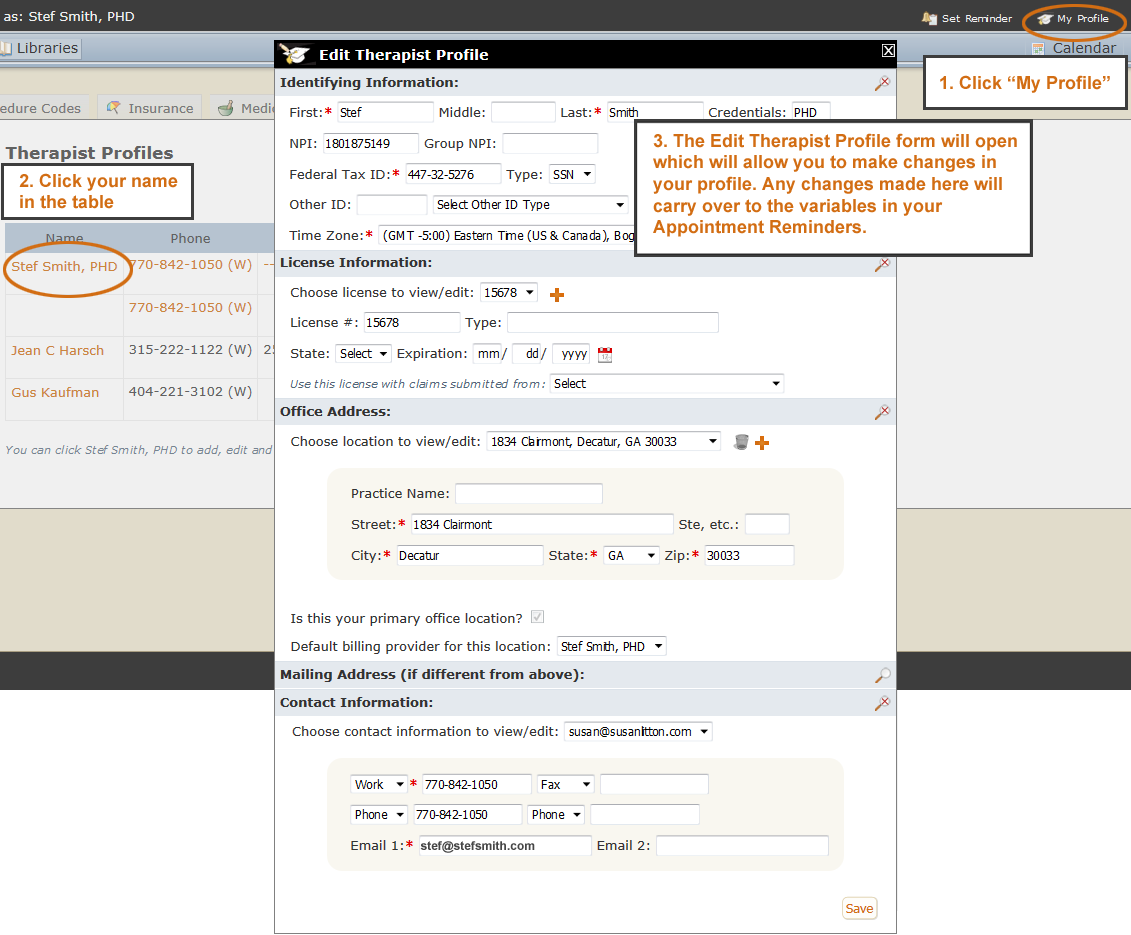
Changing the Profile will affect everything in PSYBooks, e.g., the information Steff sends to insurance companies, statements she prepare for clients, etc. Also, since the change was made globally, the next time she views a template in the Appointment Reminders section, she'll see that the variables have been changed to reflect the edits she made in her Profile.
- Make Variable Changes That Only Affect Appointment Reminders. On the other hand, if Steff wants to keep her Profile the way it is and only wants the changes to appear in her Appointment Reminders, she can make the changes in the "Variables Used in This Reminder" section of the "Edit Email (or Text) Reminder Template" by clicking the link of the variable she wants to change. The series of images below show how this works:
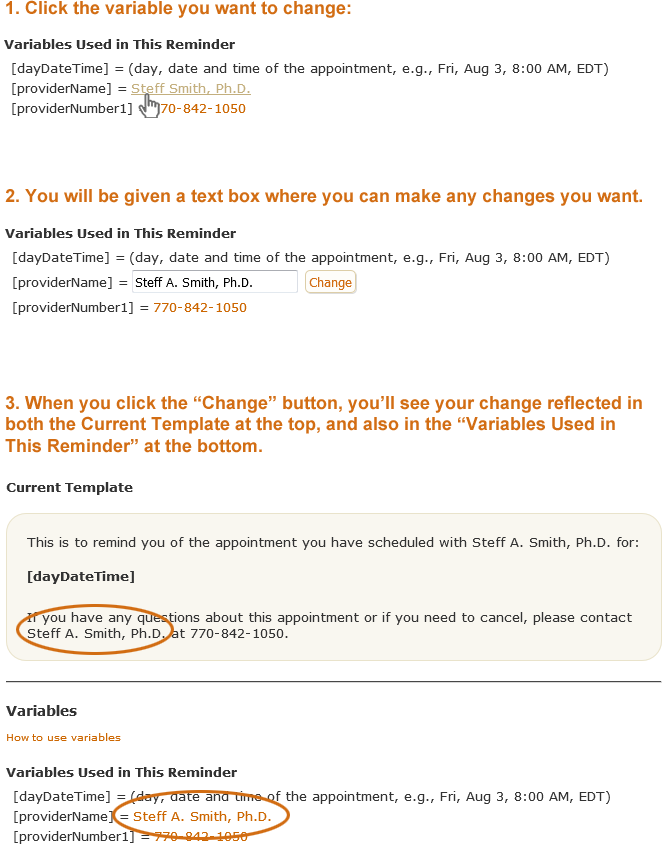
When you click "Save Variables" at the bottom of the form, you will have changed the Default email reminder template by changing one (or more) of the variables used in the template:
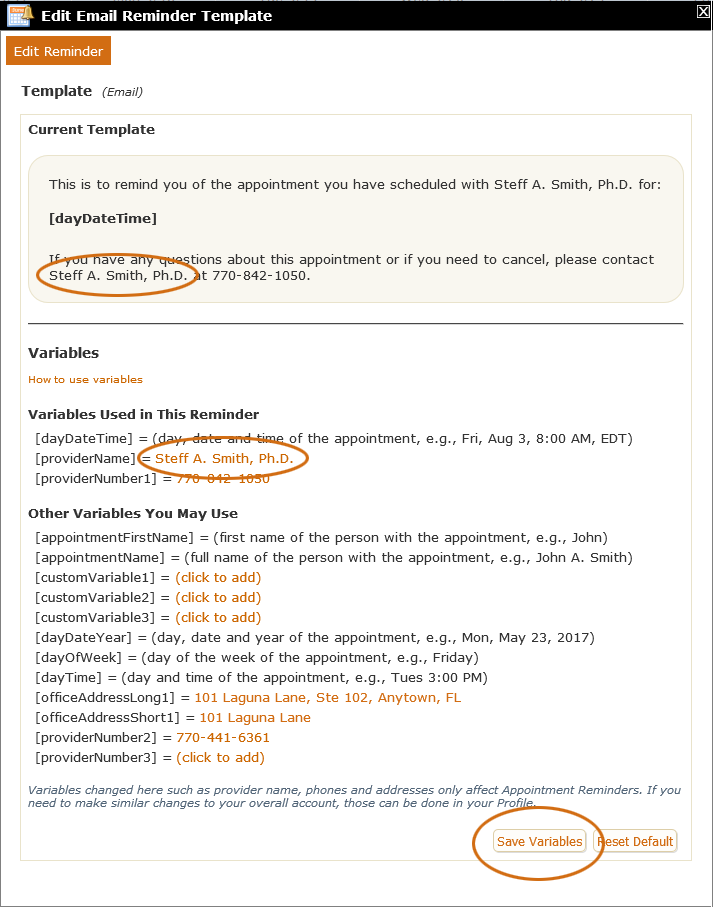
Other Variables You May Use
Below the "Variables Used in This Reminder" section, is a section of variables called "Other Variables You May Use." These will be different on each template but a sample of what you might see is below:
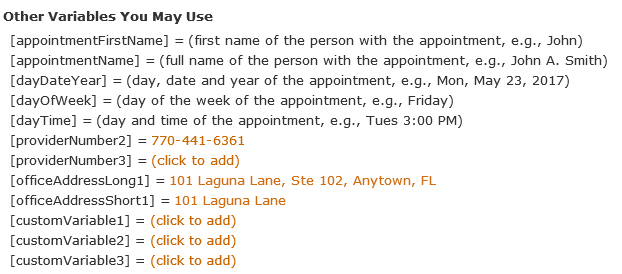
Notice that some variables in both sections are followed by an explanation of the variable and an example, whereas others are orange links that you can click and change:
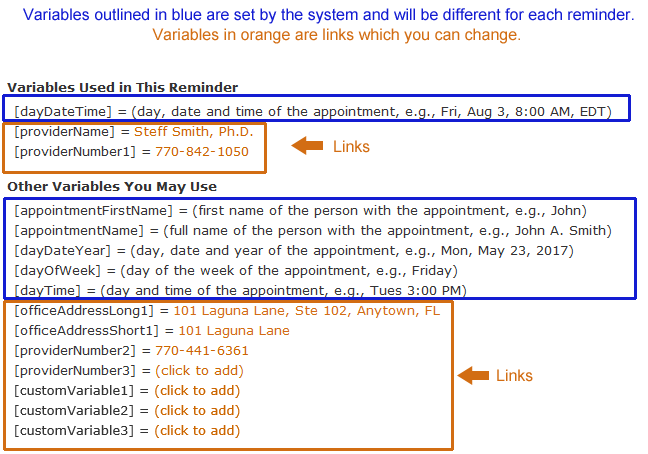
As indicated in the above graphic, variables outlined in blue are set by the system and will be different in each reminder. This means that you can't see exactly what they will say on your template page. For example, the [dayDateTime] variable will give the day, date and time of the actual appointment. Similarly, [appointmentFirstName] will insert the first name of the person receiving the reminder. You cannot directly change these variables on the template form. However, if you change the day, date and/or time of the appointment in your calendar - or if you change the recipient's name in their profile or demographics page, the system will automatically insert the updated values in your reminders.
Conversely, the variables outlined in orange are ones you can change. Some of these, such as the various forms of your name, office address and/or phones, are taken from your profile. However, as indicated above, you can change them - either here or in your profile - to send out different values of these variables in your appointment reminders. Others, most notably the custom variables, which will be discussed later, can be used for anything you like.
Editing Templates
To make changes in your reminders, you begin by clicking the orange "Edit Reminder" button at the top of the form:
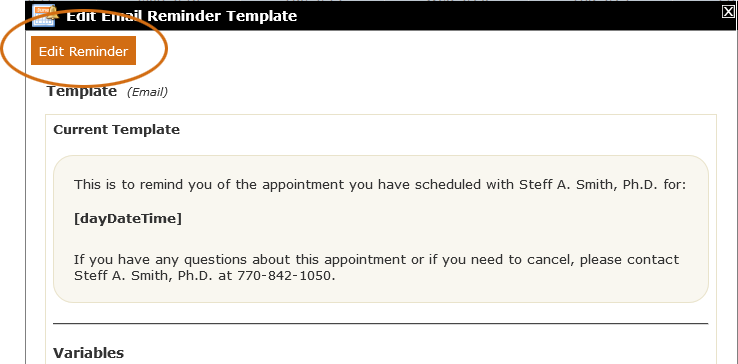
Clicking "Edit Reminder" opens a form that looks like this (the form below is an email template, but the principles are the same with text templates):
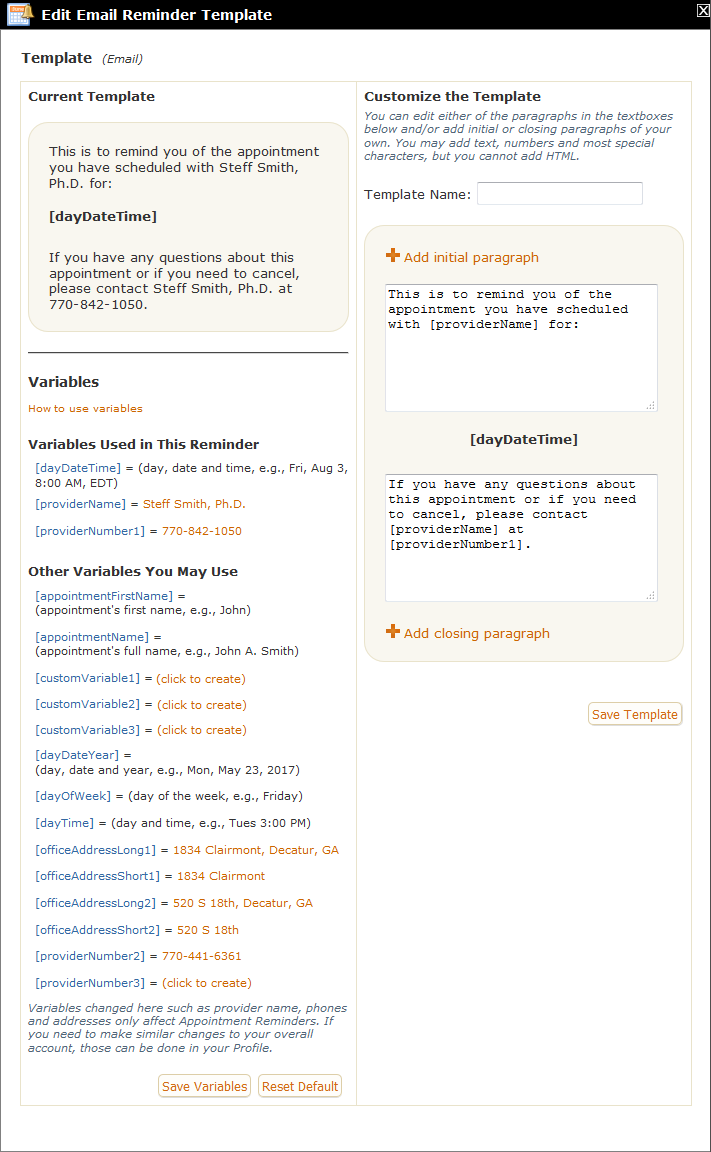
This form may look confusing at first, but if you look closely, you'll see that the original form has been collapsed to 50% of its width and appears on the left half of the window. The right half of the window is where you make your changes. This allows you to see both the current reminder plus all the variables you can use while you're modifying it.
To understand the form, it helps to compare the shaded area on the left with the shaded area on the right. The one on the left is the reminder with all variables already parsed. (The exception is the dayDateTime variable, since that can only be determined once the reminder is attached to an actual appointment.) The shaded area on the right has the unparsed version of the reminder in textarea fields, which will allow you to make changes. Notice also that the shaded area on the right has a way to add an initial paragraph and also a closing paragraph:
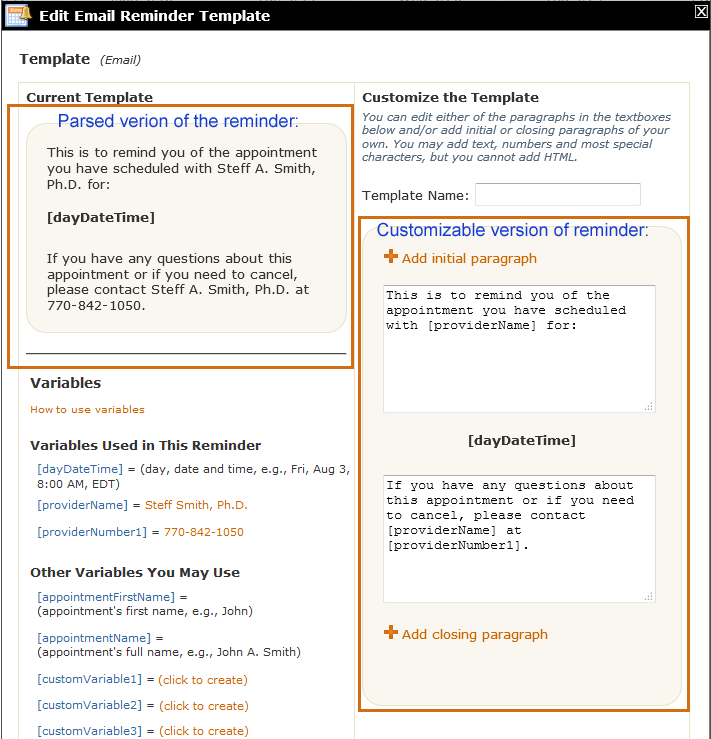
Before getting into the finer points of making template changes, the first thing you may want to do is give your new template a name. Even though we started this process by editing the Default email reminder, once you make changes to this form, you will be creating a brand new template - not overwriting the Default reminder. We will give it a name for you if you don't put anything in the Template Name box, but it will probably help you to identify your template if you name it yourself:
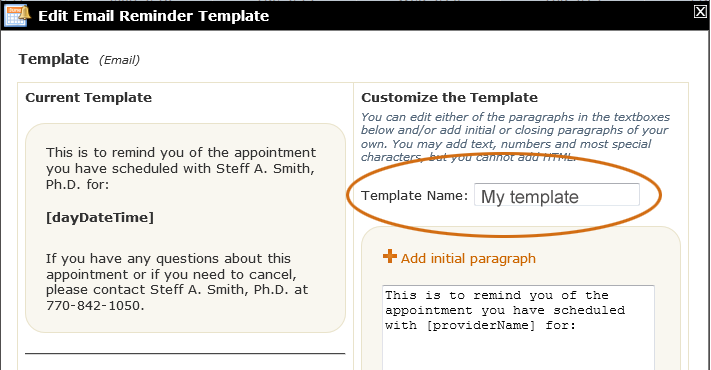
After that, you're free to make any modifications you might need. Notice that the variables on the left side of the page are blue in this edit version of the form. That's because they are now links that you can drag and drop to a textarea on the right side of the page where you want them to appear:
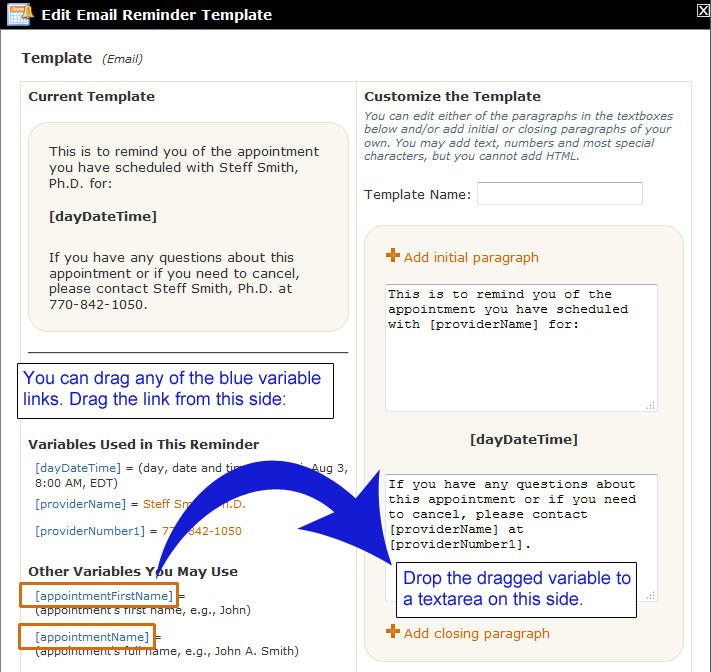
Changes you make on the right - including typing and/or dragging and dropping variables - will automatically show up in the "Current Template" section on the left.
In the sample below, the user has created both an opening and a closing paragraph and added some text (using the [officeAddressShort1] variable) to the 3rd paragraph:
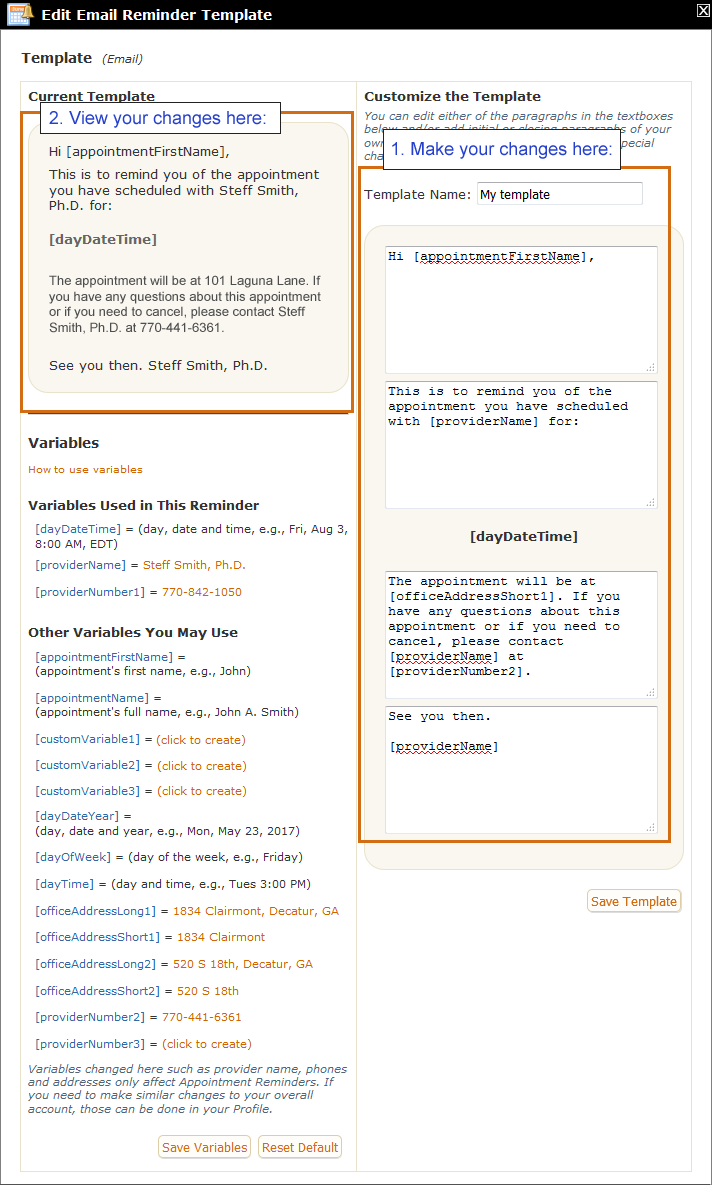
Notice that the user has chosen to use some of the "Other Variables You May Use" in their template. Specifically, they used [appointmentFirstName] in the paragraph they added at the top; they added a sentence to the 3rd paragraph that included [officeAddressShort1], and instead of [providerNumber1], which is used in the Default template, they decided to use [providerNumber2] if people need to call about the appointment.
In the Preview section on the left, we can see a sample of the custom reminder that the user just created. Notice that there are two variables that have not been parsed: [appointmentFirstName] and [dayDateTime]. This is because these variables will change depending on the specific reminder being sent. For example, for a client named John Smith, instead of "Hi [appointmentFirstName]," it would say "Hi John," - for LaKeesha Jones, it would say "Hi LaKeesha," and so on. The [dayDateTime] variable would be replaced with the day, date and time of their particular appointment.
Clicking "Save Template" will create a new template in your dropdown box that you can then use with any clients and/or other appointment types.
Creating New Global Templates
So far, we created a new template by modifying an existing one. You can always use that method to create new templates if you want. However, you can also start from scratch by opening the Template select box in the Edit Global Reminders tool and clicking "Add template." We'll illustrate a text template this time (i.e., in the bottom half of the form), so the wording is "Add text template:"
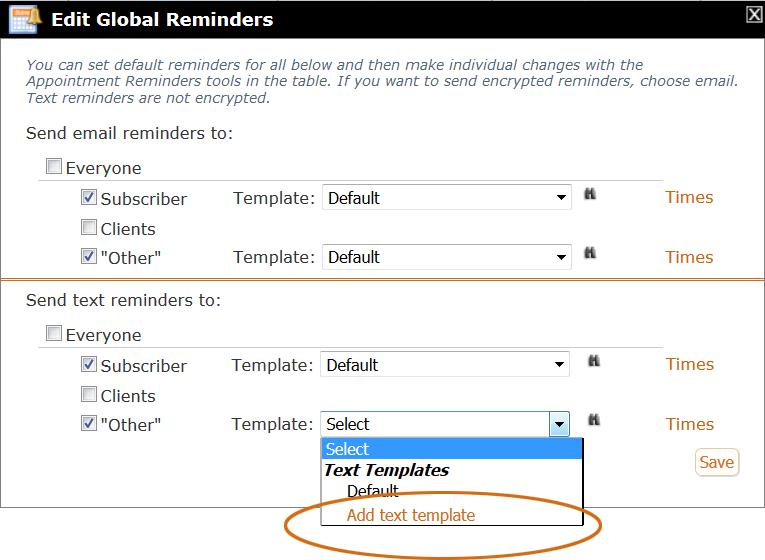
Clicking that link will open a form like this:
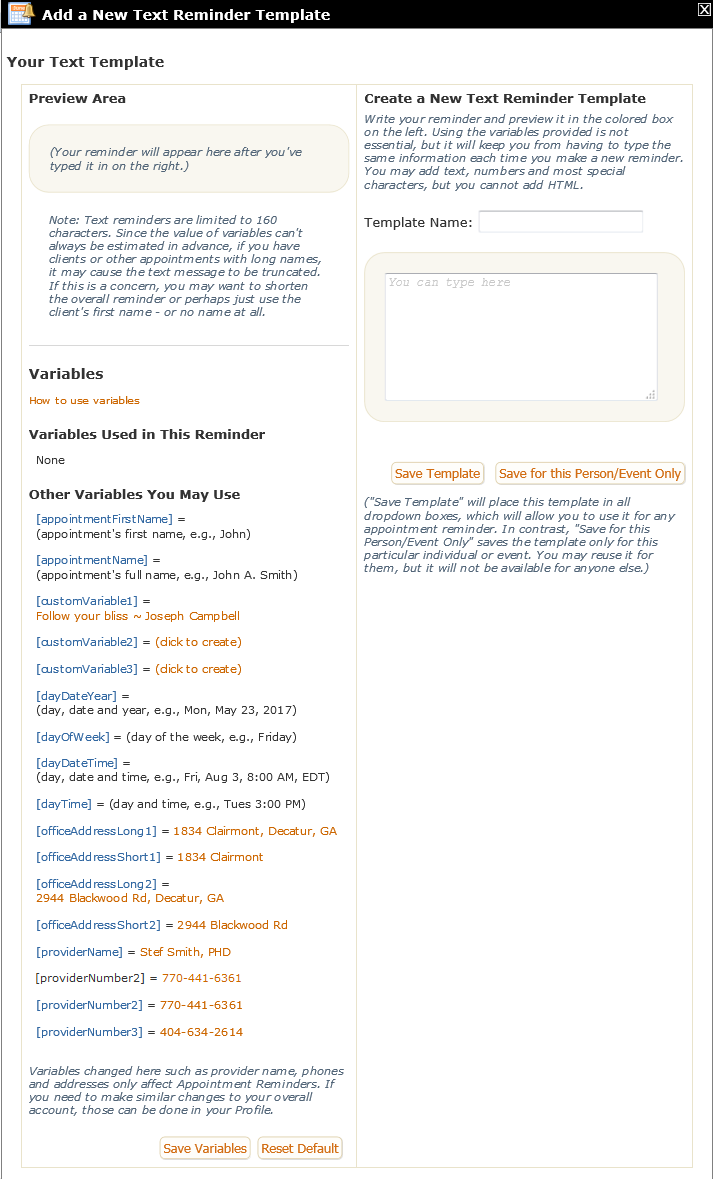
Notice that this form is very similar to the Edit Email Template form we covered above. The main difference is that since it's a new template, both the preview area and the textarea on the right are blank. Also, because this is a text template instead of an email one, you can't add extra paragraphs and the number of characters you can send is limited to 160. The screenshot below shows one possibility of a custom text reminder our fictitious therapist might have created with this form:
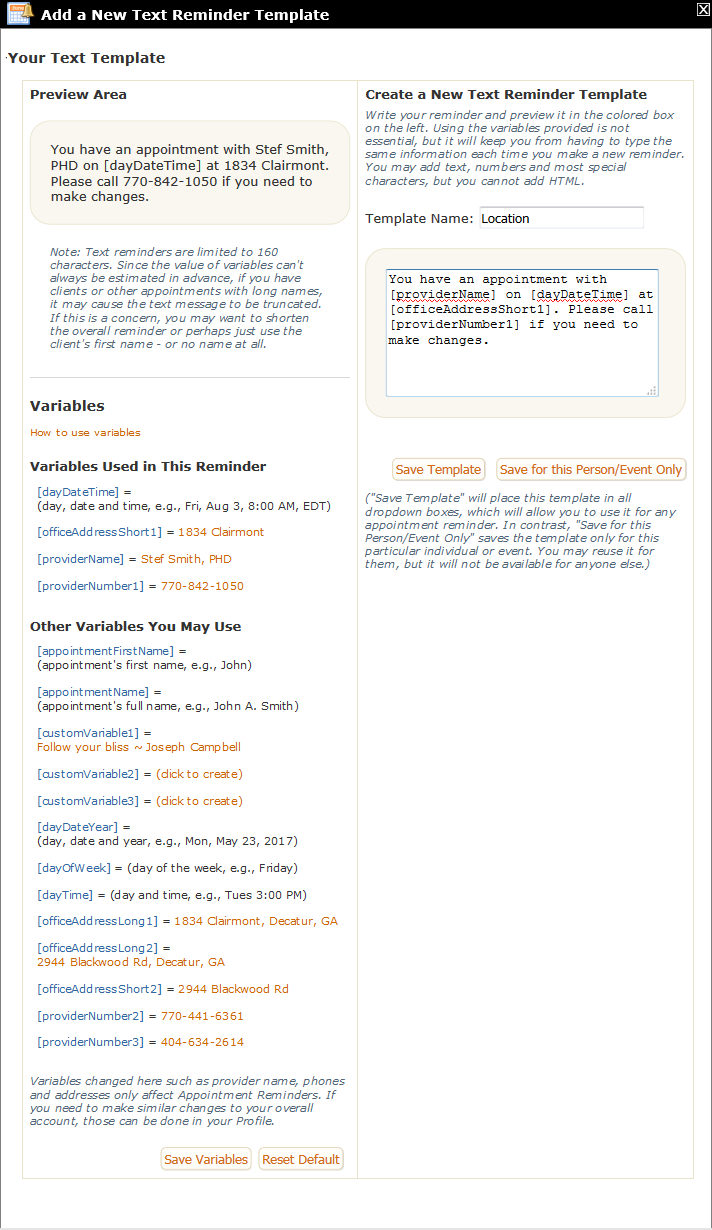
Since we clicked the "Add text template" from the Edit Global Reminders tool, if the therapist clicks "Save Template", she will now have a new text template called "Location" that will appear in both the Clients and the Other template dropdowns.
Editing Global Reminders: Times Sent
Above, we've covered setting both the type (email and/or text) and the template for your appointment reminders. The final thing you might want to change is to tell us when you want them to be sent. These settings are in the "Times" links at the end of any row. If we open the "Times" link at the end of either the "Everyone" or the "Subscriber" rows, we'll get a window that looks like this:
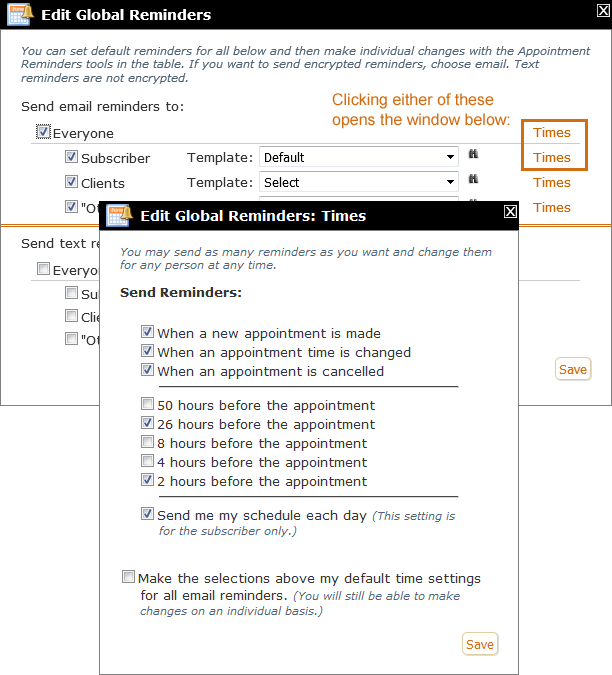
Again, these are the times used for PSYBooks default appointment reminders. The "Times" link at the end of either the "Clients" or the "Other" rows opens a very similar window. The only difference is that the last two lines aren't present:
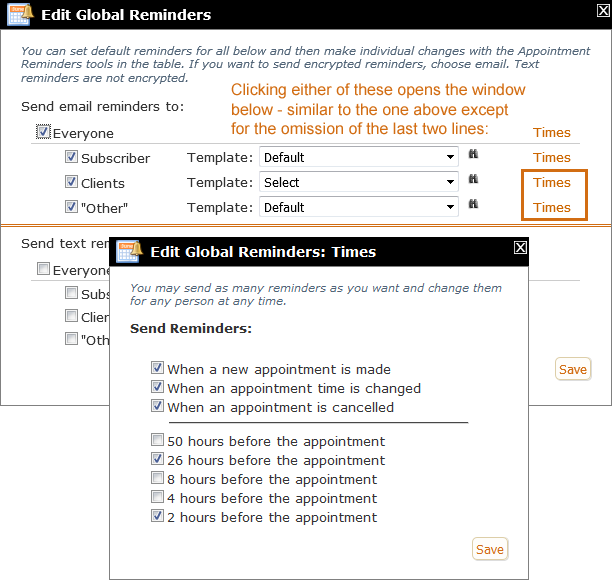
Since we're looking at forms with the default setting, the times on both forms are the same. Appointment reminders will be sent when a new appointment is made, when an appointment time is changed or canceled, 26 hours before the appointment and 2 hours before the appointment. The main difference between the two forms is that the first window is of categories that include the subscriber (i.e., Everyone and Subscriber). For that reason, they include some features that only apply to the subscriber, i.e., receiving a daily schedule, and making the selections chosen the default for all. For example, if you preferred your reminders to be sent 50 hours and 4 hours before appointments, you could open the "Times" window on either the Everyone or the Subscriber rows, make those changes, and check the "Make the selections above my default time settings" box. The subscriber, plus all clients and others would then receive appointment reminders at the new times. Conversely, you can choose one set of times for the subscriber, another for clients and another for your "Other" appointment types.
Custom Variables
You may have noticed that the "Other Variables You May Use" section of the template form has three "custom variables:"

Clicking one of these variables will open a textbox where you can enter any information you'd like:

Clicking "Change" will create your variable:

You can then use that custom variable - in this case, [customVariable1], in the edit template form:
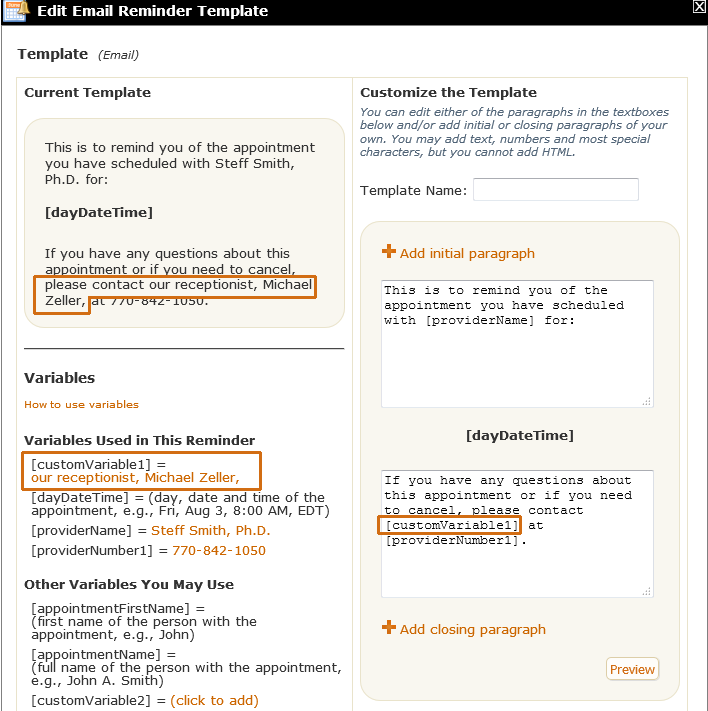
Feel free to be creative with how you use your custom variables. For example, you might want to send out a quote each week. By making it into a custom variable, you can use it in any template you might create. Here's one example of how that might look:
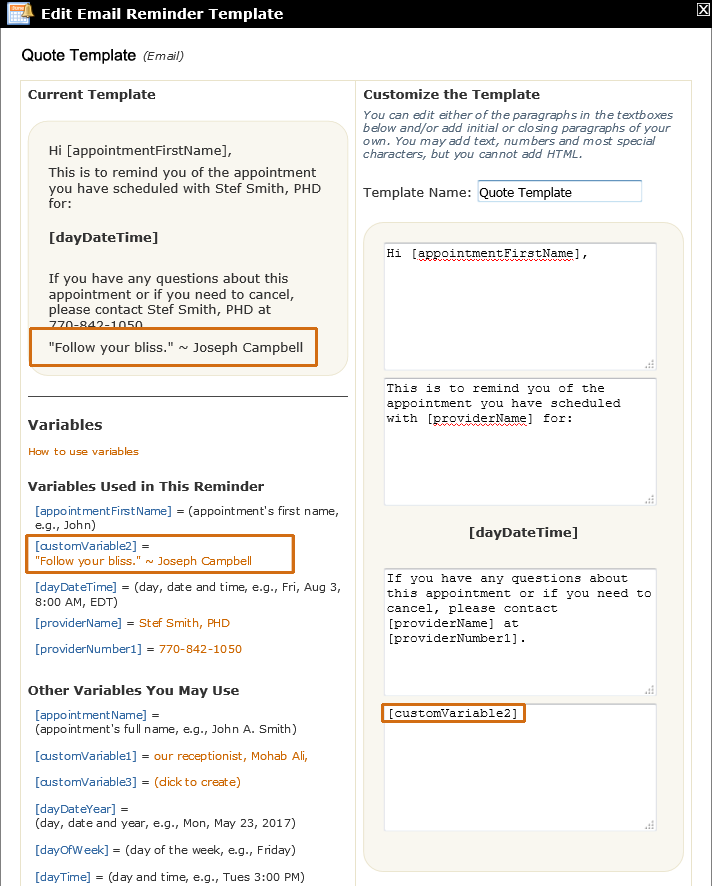
One thing to be aware of is that when you change a variable, it overwrites the previous value of that variable. For example, in the screenshot above, both [customVariable1] and [customVariable2] have values (1 is "our receptionist, Mohab Ali, " and 2 is ""Follow your bliss." ~ Joseph Campbell). If, instead of using [customVariable2] for our quote, we had changed [customVariable1] into our quote, any templates we had created that were supposed to use "our receptionist, Mohab Ali," would now display the quote there instead.
This completes the discussion of adding, viewing and editing global appointment reminders. Next we'll look at how to fine tune your appointment reminders by making changes that are specific to a single individual.
Individual Appointment Reminders
So far, we've covered making changes to your global reminders. You can also make changes to any individual's appointment reminder settings. For example, maybe you want the majority of your clients to receive text reminders. However, if you have a couple of clients that don't have cell phones, you might want to specify email reminders for them. Another use for individual reminders might be with new clients. Their reminders could, for example, remind them to come early to fill out your intake forms. Perhaps you have two office locations and you need to remind a client to come to a different location for their next appointment. Or perhaps you want to include a note reminding a certain client to bring their homework assignment with them. You could even use the reminders to send out affirmations or individual notes or congratulations for special occasions. The possibilities of what you might want to include in a custom appointment reminder are almost endless. These kinds of individual changes are made in the Appointment Reminder table which takes up the majority of the Appointment Reminders form:
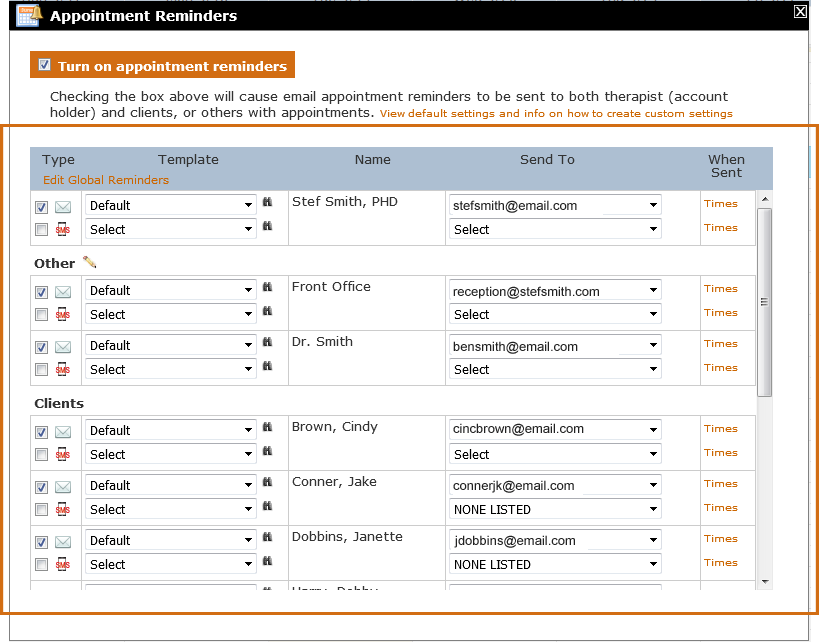
Looking at the blue table header area, there are 5 columns in this table: Type, Template, Name, Send To, and When Sent. Three of these - Type, Template and When Sent (Times) - work almost exactly like they did in the global reminders. The Name and Send To columns are present because we're now working with individuals. Each of the columns will be discussed separately.
- Type. The Type column is where you specify whether you want this individual to receive email or text appointment reminders. The top checkbox in each row is for email reminders - the bottom checkbox is for text reminders. The email and text icons are there just to let you know which row is which; clicking either the icon or the checkbox will select the checkbox on that row. You cannot directly email or text a client from this screen.
The screenshot below shows what the default Type setting looks like before any changes are made, i.e., each row in the table has a check in the email checkbox and no text (SMS) checkboxes are checked:

However, if you wanted a particular individual to receive text reminders either in addition to or instead of an email reminder, you could select or deselect the box or boxes you want on that individual's row.
- Template. The Template column is where you specify which template will be used for your reminders. Since we're currently looking at PSYBooks' default settings, all of the templates in the email rows are set to "Default." Since no text reminders are being sent, templates in the text rows are still on the "Select" option:
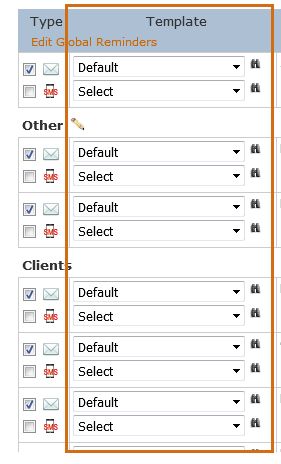
As was possible with global reminders, you can add new templates with the Template select box, edit old ones, and/or select a different one. In general, all the things about adding, editing and viewing global templates apply to individual templates as well. However, there is one difference and that is that there are two ways to save individual reminders. When we looked at global reminders, they only had a standard "Save Template" button at the bottom. But when you add or edit a template on an individual's row, you have two buttons:

The difference between these two types of save is that the first one, "Save Template", will allow you to use this reminder again with other clients or appointment types. In contrast, "Save for this Person/Event Only" allows you to create a reminder for a specific individual or other appointment type. For example, you might create a reminder that says, "Hi John, Our next appointment is: [dayDateTime]. I'll be thinking about you on Thursday for your interview." That's obviously not a reminder you'd want to use for everyone; it's personalized just for John. In this case, you'd want to save it with the "Save for this Person/Event Only" button. Also, since this reminder applies to one specific week, you'd need to change John's reminder for the following week. Another example might be if you've created an "other" appointment type called "Staff Meeting." You might want to include the agenda for the upcoming meeting. Again, that information would be a customized reminder just for the Staff Meeting entry.
- Name. The Name column lists the name of the person to whom you'll be sending appointment reminders. Names in this table are sub-divided into three categories: the subscriber is listed in the first row (Steff Smith, PHD, in our example), followed by row(s) for "Other" appointments, if any, and finally clients are listed in the bottom rows of the table:
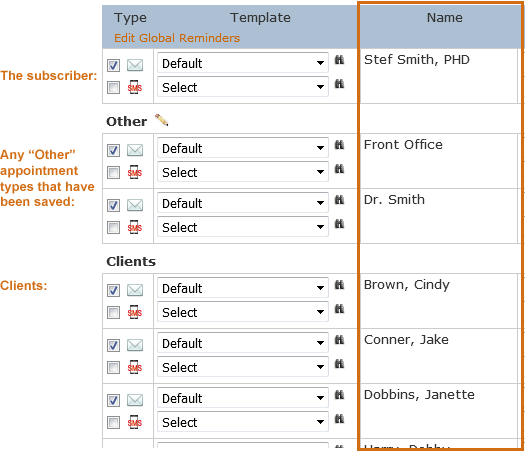
As a reminder, "Other" appointment types are those that have been added as an "Other" - instead of a client - on the Add Appointment form:

Notice that all appointments you make in PSYBooks will either be a client or an "Other" appointment type.
- Send To. The Send To column contains PSYBooks' best guess about the email address and/or phone number you might want to use for your reminders. You can change any of the email addresses and/or phone numbers with the Send To dropdown if they are not the best choices:
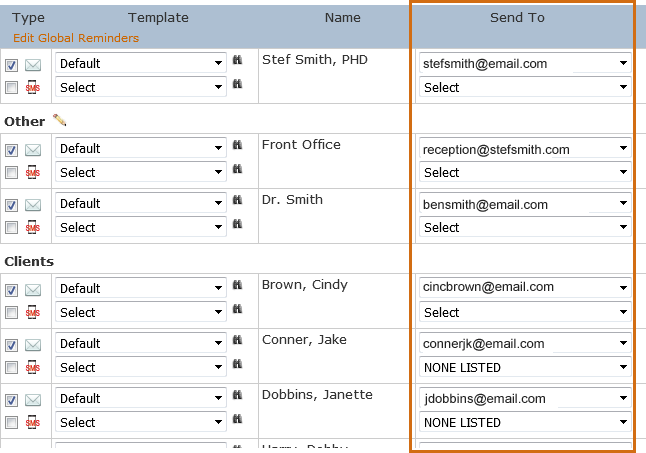
Again, since we're looking at the Default setting, only email reminders are being sent, which is why no phone numbers are shown in the Send To column. However, if we selected text reminders, the other fields in that row would automatically change, changing the Template select box to Default and revealing the phone numbers we have on file in the Send To column:
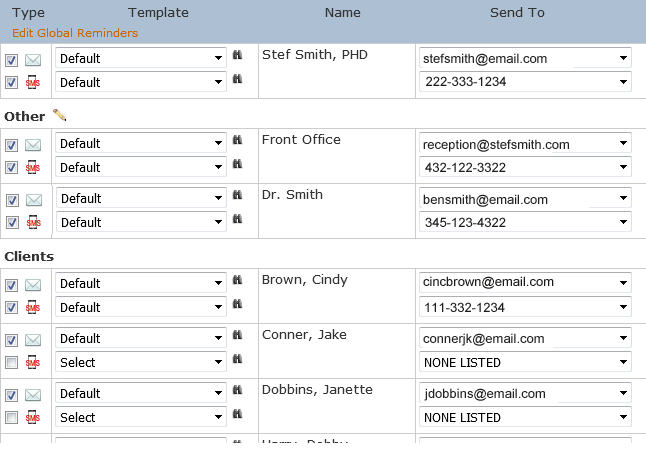
Note that neither Jake Conner nor Janette Dobbins has phone numbers listed in their charts, so they have a "NONE LISTED" designation in the Send To select. Similarly, their text checkboxes aren't checked - because until we have a cell phone number on file for them, we can't send them text reminders. If you want, you can add additional emails or phones right from the Send To select box by clicking the "Add new" link:
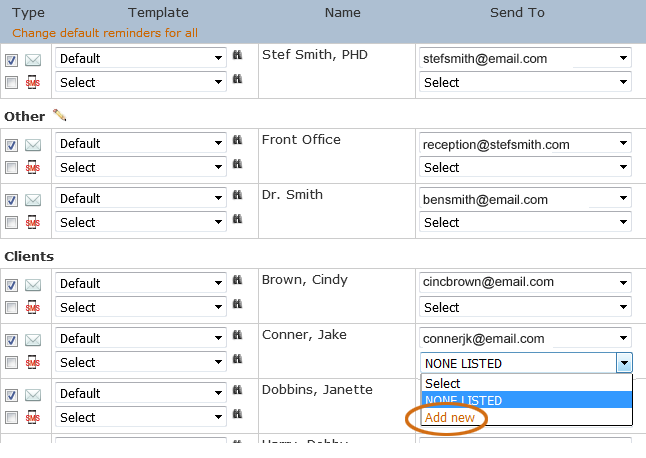
However, it's important to note that adding email addresses and/or phone numbers to the Appointment Reminder table does NOT add them anywhere else in the program. If you want to be able to use a client's email addresses and/or phone numbers throughout the application, add them to the Demographics page of the client's chart. If you want to add new emails or phones for the subscriber, do that on their Profile page.
PSYBooks programming rules for determining default email and phones
- When Sent. "When Sent" is the final column in the table:
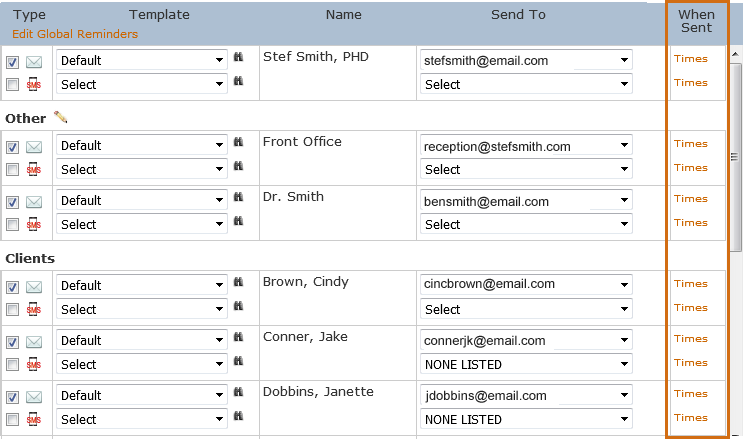
Notice that there's a "Times" link in the top of each row for setting the times email reminders will be sent, and another "Times" link in the bottom for text reminders.

Both will open some version of this form:
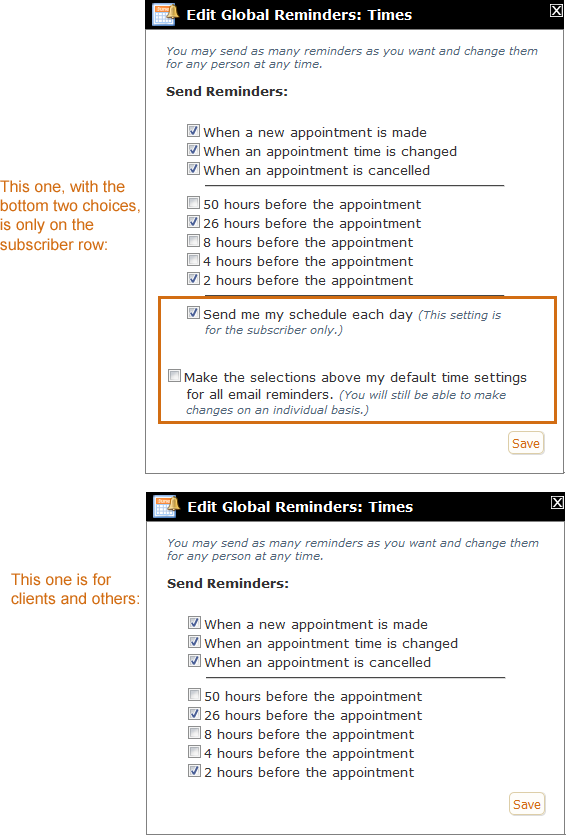
These windows allow you to choose when you want your reminders sent. In the top one, the options "Send me my schedule each day" and also the option to make your selections the default only apply to the subscriber. For that reason, those last two items only appear on the subscriber's row. The window at the bottom is what opens when you click the "Times" links for Client and Other appointment types.
When you hover over any of the Times links, you'll be able to see a summary of when appointment reminders will be sent for that type of reminder for that person. In the screenshot below, the cursor in the top window is hovering over an email reminder; the one on the bottom shows a text reminder:
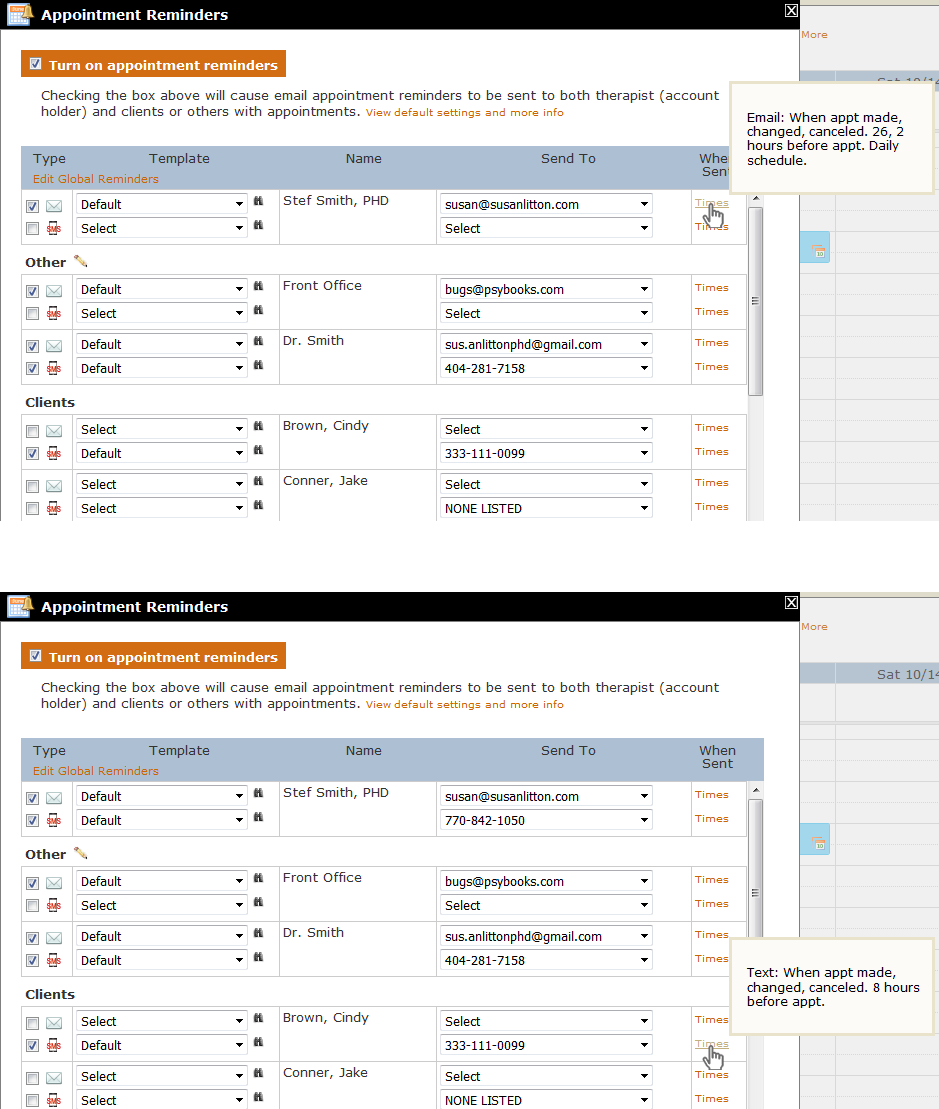
These hover windows just enable you to see at a glance when any of your reminders will be sent. If you want to make changes, you would click the Times link you need, make the changes you want, and click Save.
The Set Appointment Reminder Tool
Some forms in PSYBooks have a special tool called, "Set Appointment Reminder." For example, there's one on the Add Appointment form:
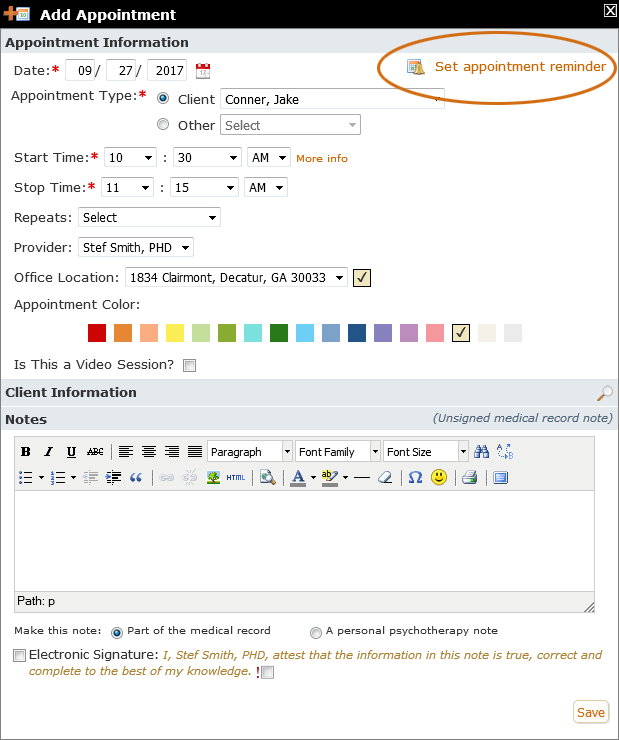
Clicking this tool opens the Appointment Reminder tool we've been discussing, and highlights the person for whom the appointment was set - in this case, a fictitious client named Jake Conner:
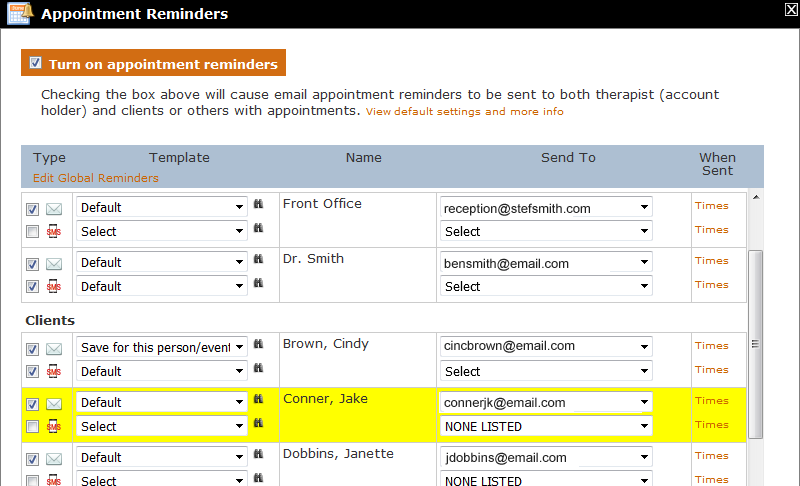
The Set Appointment Reminder tool is most helpful for new clients, for whom you do not already have an appointment reminder set. In fact, if you're using the default reminders, you will not even need it for new clients. When you have not made any changes to PSYBooks' default reminders, all new clients you enter will automatically be signed up for the default appointment reminders.
However, with new clients when you HAVE made changes to the default reminders, and/or for existing clients when you want to make changes to their appointment reminders, the Set Appointment Reminder tool can be helpful. When you click it, you'll be able to change and/or set any of the individual's appointment reminder settings as has been discussed above.
The Send Reminder Now Tool
Occasionally you might want to manually send an appointment reminder. The tool for doing that is on the Edit Appointment form directly under the Set Appointment Reminder Tool discussed above:
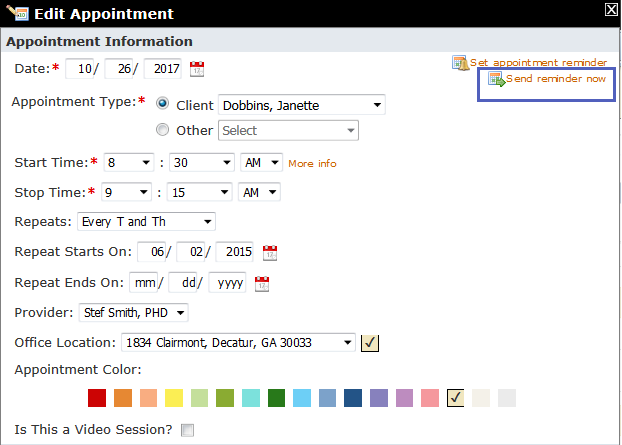
Clicking the link will use the type and template you already have set for that person to send them an appointment reminder for this particular session.
If you're not sure how to access the Edit Appointment form, you can read about it here: Edit Appointment.
Appointment Requests
What this isThe Appointment Requests tool allows you to offer appointment times to individuals in a dynamic way, i.e., if a time slot is filled before the recipient selects a time, that slot will no longer appear as a possible time.What it looks likeThe Appointment Requests tool looks like this: 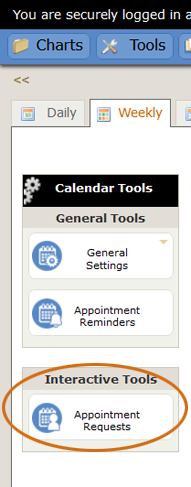 |
Where this isThe Appointment Requests tool is on the left nav of the Calendar section of the app. |
The Appointment Requests tool is primarily for therapists who may not want to put their entire schedule online, but would like to be able to use the interactive portion of the calendar to send available appointment times to specific clients or other Portal Users. It might be used, for example, with new clients, or when a current client needs to reschedule or requests an additional appointment. When you fill out and submit an Appointment Request, the recipient will receive a link to the calendar page of their portal, which will display the times you designated. They can then select the time(s) they want and their choice will automatically be added to your calendar as well as theirs. If you have filled one or more of the times since sending the link, those times will not appear on the recipient's calendar so you don't have to worry about double-booking. Recipients must be Portal Users to view their calendar. However, if they're not, you can send them a Portal User Invite at the same time you submit the Appointment Requests form.
When you click the Appointment Requests tool, the window that opens looks like this:
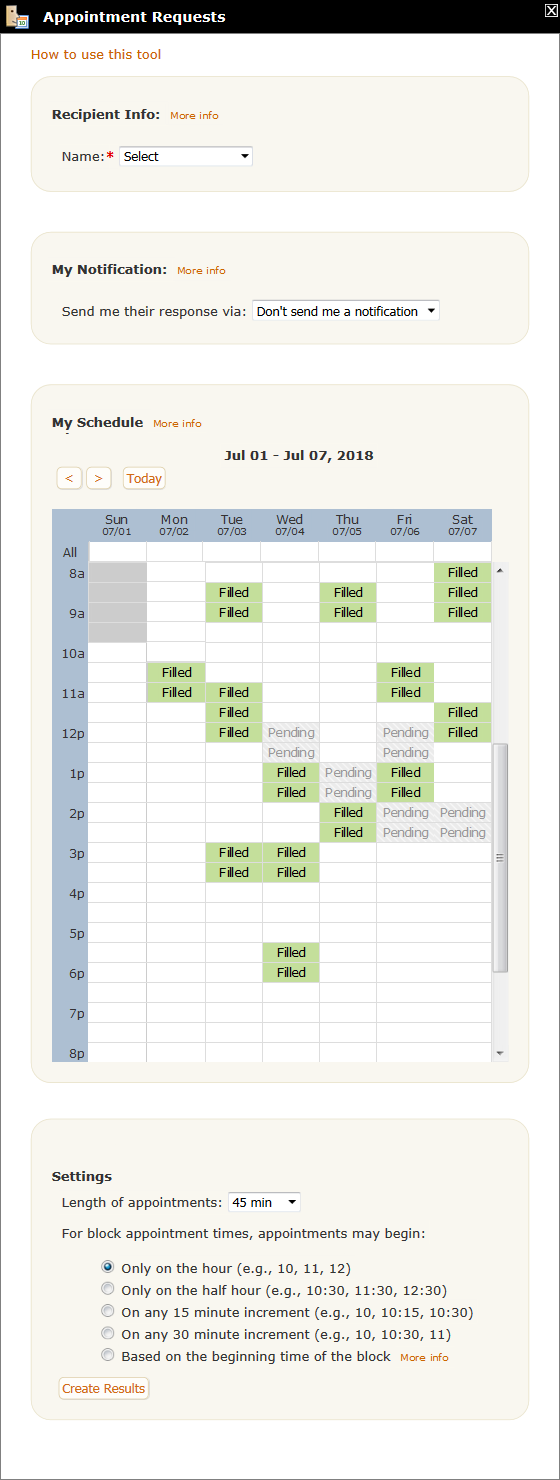
Although this tool is long, it's divided into sections - Recipient Info, My Notification, My Schedule, and Settings - to make it easier to use and understand. We'll discuss each section separately below:
- Recipient Info
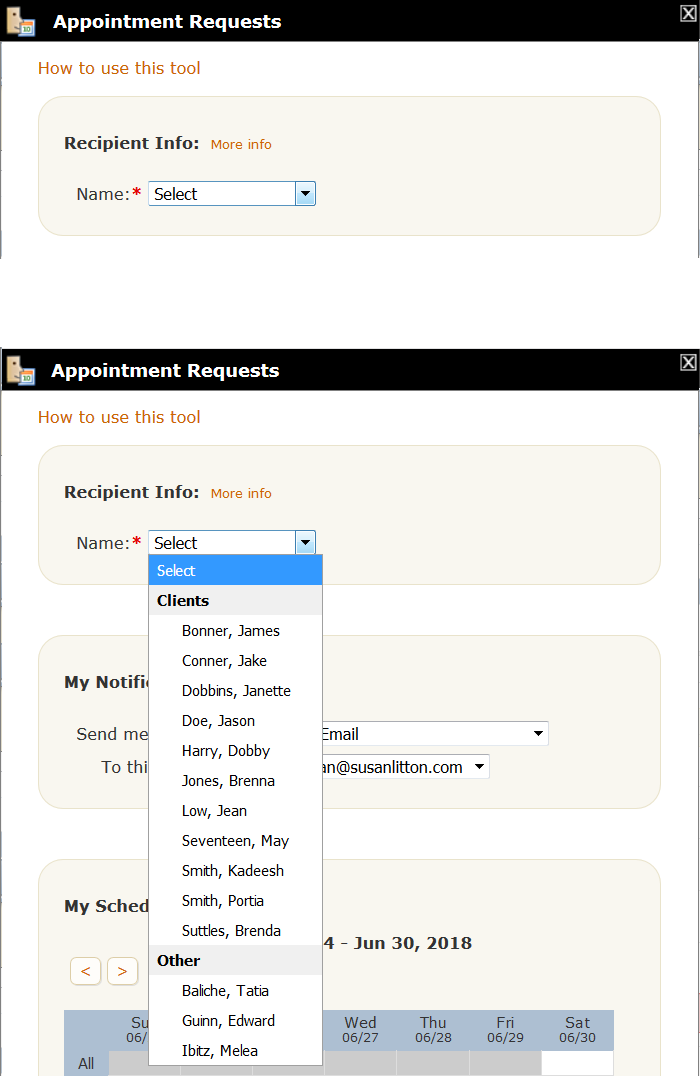
When you first open the Appointment Requests tool, the select box in the Recipient Info section is closed - as in the top portion of the image above. When you open the select box, the dropdown list includes all your clients at the top followed by any "Other > Person" appointment type entries you've made.
As soon as the user makes a choice in the "Name" dropdown of the Recipient Info section, an additional row appears. It also has a default state (top portion of the image below) and a final state that's dependant on the choice you make in the select box:
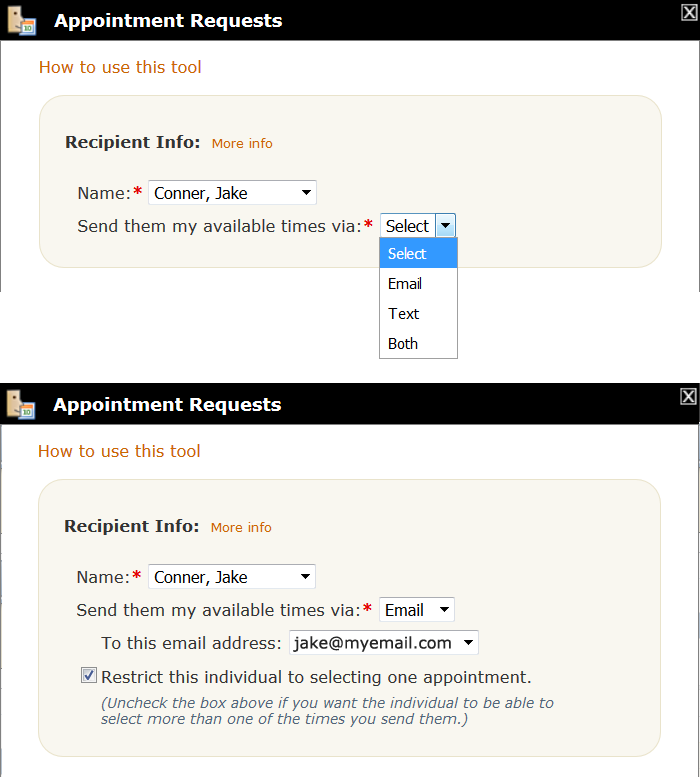
The "Send them my available times via" select box allows you to choose whether you want the recipient to be notified via text or email or both. Once you make a choice, the field(s) become populated with the phone numbers and/or email addresses that are associated with that individual. If the individual is signed up for PSYBooks Appointment Reminders, the email and/or phone number used to send appointment reminders will be selected by default, but can be changed. As with other places in PSYBooks, your choice here is remembered for the next time you send this individual an Appointment Request. However, changes made here do NOT affect the recipient's Appointment Reminder delivery. In other words, an individual may be signed up to receive texts for their PSYBooks Appointment Reminders but you might prefer to send their Appointment Requests via email. PSYBooks will remember each choice separately.
The "Restrict this individual to selecting one appointment" checkbox is checked by default. However, if you'd like the recipient to be able to select more than one of the times you send them, you can uncheck the box.
- My Notification
The next part of the Appointment Requests form is the "My Notification" section. When the client or other individual reserves one (or more) of the times they were sent, your calendar will automatically be updated. However, the My Notification section gives you the option of also being notified via text and/or email. The default state of this form depends on whether or you are already signed up to receive PSYBooks Appointment Reminders. If you have NOT signed up for Appointment Reminders, the "My Notification" part of the Appointment Requests form will look like the top portion of the image below. However, you can open the select box and choose how you want to be notified about this particular Appointment Request, as illustrated in the bottom screenshot:
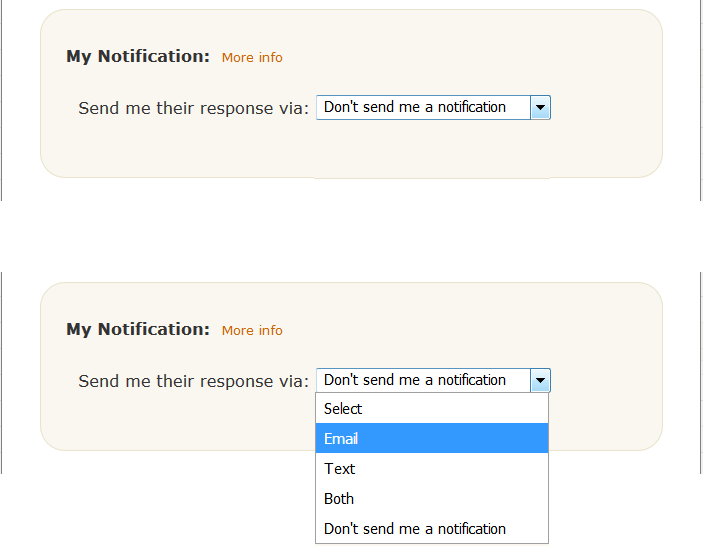
Once you make a choice (Email, Text or Both), additional rows will open which will allow you to choose which email and/or phone number you want PSYBooks to use.
- My Schedule
The My Schedule portion of the Appointment Requests form shows your existing calendar and also allows you to select times you'd like to send the recipient.
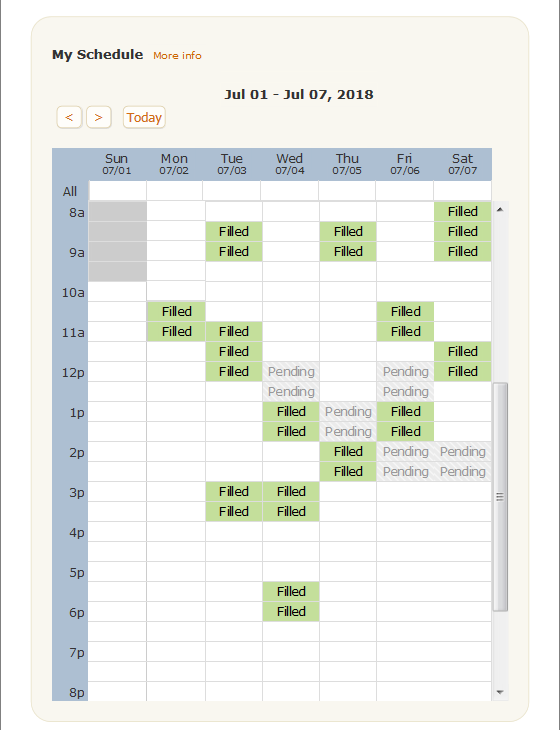
There are several things to notice about the screenshot above:
- Appointment Color
There are 4 colors of interest in this calendar: 1) the darker gray (on the screenshot above it appears only on Sunday until 9:30am) (
 ), 2) the green appointment slots that typically have the word "Filled" written in them (
), 2) the green appointment slots that typically have the word "Filled" written in them ( ), 3) the lighter gray with diagonal lines and the word "Pending" (
), 3) the lighter gray with diagonal lines and the word "Pending" ( ) and 4) the default white background (
) and 4) the default white background ( ). Each of these is important because they give you information about times you can send the person with the Appointment Request. We'll discuss each separately:
). Each of these is important because they give you information about times you can send the person with the Appointment Request. We'll discuss each separately: The screenshot for this photo was obtained at around 9:30am on Sunday morning, July 1, 2018. That explains the dark gray color on Sunday morning until 9:30. (If we were to scroll up, everything from 12:00am - 9:30am on Sunday would be the dark gray.) In other words, dark gray represents times that have already passed - which, of course, also means that you would not be able to send your client those times for possible appointments. Also, if you were to move your cursor over the dark gray portion, it would change into a circle with a line through it like in the screenshot below, indicating that you cannot select any times in that area for your Appointment Request:
The screenshot for this photo was obtained at around 9:30am on Sunday morning, July 1, 2018. That explains the dark gray color on Sunday morning until 9:30. (If we were to scroll up, everything from 12:00am - 9:30am on Sunday would be the dark gray.) In other words, dark gray represents times that have already passed - which, of course, also means that you would not be able to send your client those times for possible appointments. Also, if you were to move your cursor over the dark gray portion, it would change into a circle with a line through it like in the screenshot below, indicating that you cannot select any times in that area for your Appointment Request: 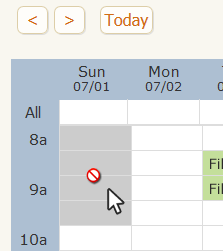
 The green color with the word "Filled" represents appointments that are already on your calendar. Displaying them here allows you to see your whole calendar at a glance which can be useful when deciding which appointment slots you have free for the person needing the new appointment. If you mouseover a "Filled" cell, you will not only see the "no" icon - indicating that this is not a time slot you can use - but there's also a gold tooltip that will display the name of the person, group or event that's currently filling that time slot:
The green color with the word "Filled" represents appointments that are already on your calendar. Displaying them here allows you to see your whole calendar at a glance which can be useful when deciding which appointment slots you have free for the person needing the new appointment. If you mouseover a "Filled" cell, you will not only see the "no" icon - indicating that this is not a time slot you can use - but there's also a gold tooltip that will display the name of the person, group or event that's currently filling that time slot:
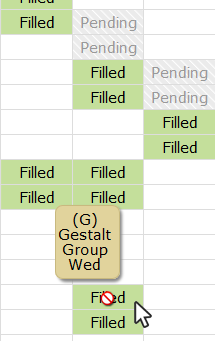
 The "Pending" appointment slots indicate times you've sent to other recipients through the Appointment Requests tool. Like with "Filled" appointments, when you mouseover a Pending slot, you'll get a tooltip that shows the names of the people to whom that time has been sent. In the screenshot below, the time has been sent to two clients - neither of whom has yet claimed it:
The "Pending" appointment slots indicate times you've sent to other recipients through the Appointment Requests tool. Like with "Filled" appointments, when you mouseover a Pending slot, you'll get a tooltip that shows the names of the people to whom that time has been sent. In the screenshot below, the time has been sent to two clients - neither of whom has yet claimed it:
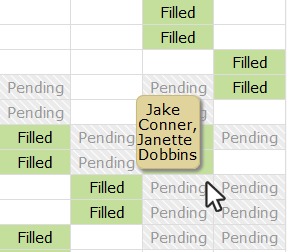
Notice that you CAN use Pending time slots for a new Appointment Request, i.e., there's not a "no" icon when you hover over the cell. For example, say Client A, Client B and Client C all contact you and want an appointment in the next couple of weeks. You see that you have four times available, so you send all four times to each of the three clients. The client who checks first will be able to choose among all 4 times. The time slot that person chooses will no longer say "Pending" on your calendar. Instead, it would appear as a regular appointment time with that person's name on it. Also, that time slot will no longer be available on the remaining two clients' Portal Calendars. When the next client checks their Portal Calendar, they will only have three possible times and so forth.
 Finally, any white space on the calendar can also be filled with possible appointment times on the Appointment Request form.
Finally, any white space on the calendar can also be filled with possible appointment times on the Appointment Request form.
- Appointment Color
- How to Use the Calendar
To recap, you can send any of the white appointment slots and/or any of the Pending appointment slots to the person needing the appointment. The times you select in the My Schedule section of the Appointment Requests form will be sent to the recipient as the times you have available.
To select times, you can either click the table cell you want or you can also click and drag your cursor to select several slots at one time. Chosen times turn a dark orange. The image below shows a calendar on the Appointment Requests tool where the therapist has already made their selections. If you make mistakes or need to remove some slots, right click the orange cell(s) you want to remove. Notice that any "Pending" slots that are selected turn the same dark orange as other selected slots but maintain the diagonal lines and the word "Pending":
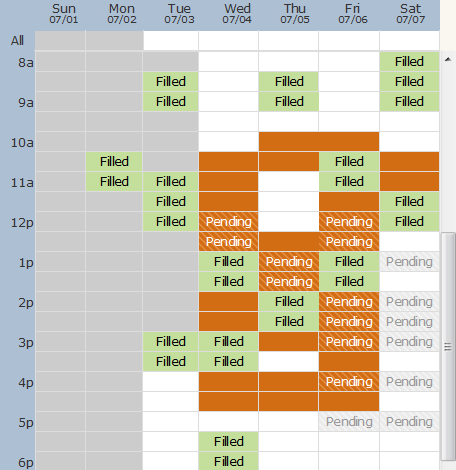
The last section of the Manage Appointment tool is the Settings section. It looks like this:
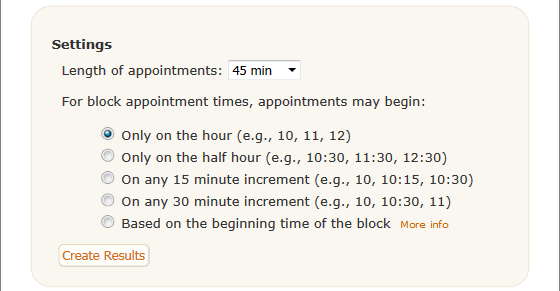
The Settings section is important because the choices you make here determine the exact times that are sent to the client or other recipient. There are only two variables - appointment length and appointment start time - but the ultimate results can vary widely depending on their values:
- Length of Appointment
The default appointment length is 45 minutes but you can change it. However, although straightforward by itself, this variable interacts with the next variable - "appointments may begin" - in important ways.
- "Appointments may begin"
The options here are not as easy to understand so we'll discuss each separately:
- Only on the hour
This choice will only produce appointment times that begin on the hour, regardless of the actual time slots you might choose. For example, if you chose a timeblock between 12:30 and 2:00, the only appointment time that could be created would be one starting at 1:00. Also, had you chosen a length of appointment that was greater than 60 minutes, no appointments would be able to be created because the timeblock ends at 2:00.
Once you've selected your times, clicking "Create Results" displays the possible appointment times that can be created with the variables you selected. For example, the screenshot below is for a time block of 12:30pm - 2pm, an appointment length of 45 minutes and an indication that any appointments created should start on the hour:
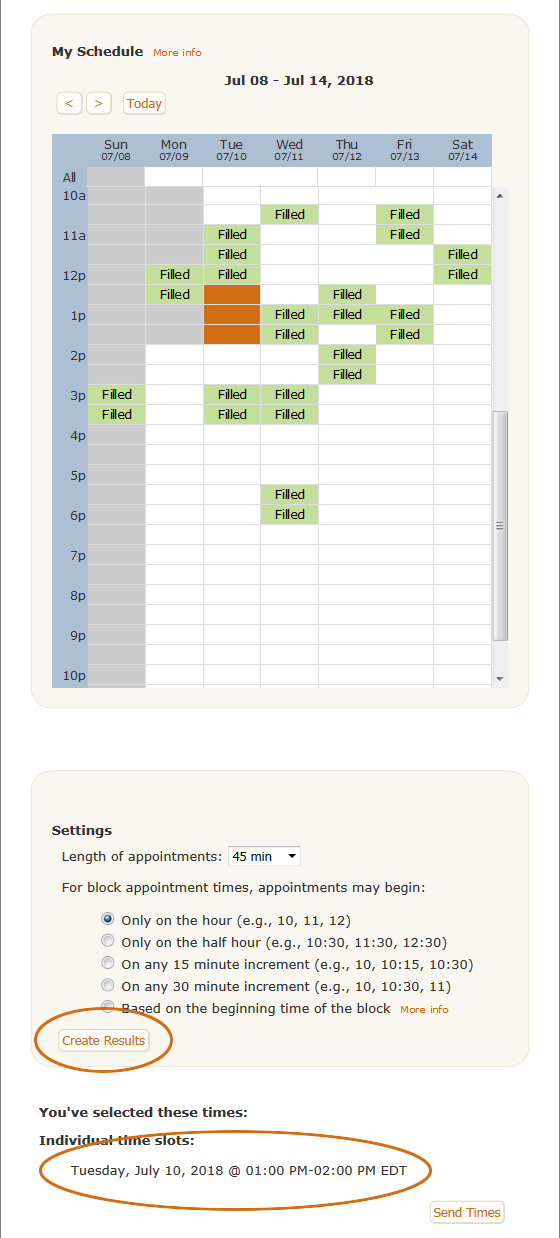
- Only on the half hour
This is like the one above except that appointments can only start on the half hour. Again, though, length of appointment plays a big role in the appointments that are created. For example, sticking with the example above with a time block of 12:30 - 2:00, if the appointment length is 30 minutes or less, two appointments could be created - one beginning at 12:30 and the other beginning at 1:30. However, if the appointment length is greater than 30 minutes and less than 90 minutes, only one appointment could be created - beginning at 12:30.
The screenshot below uses the variables 45 min and starts on the half hour, producing one result:
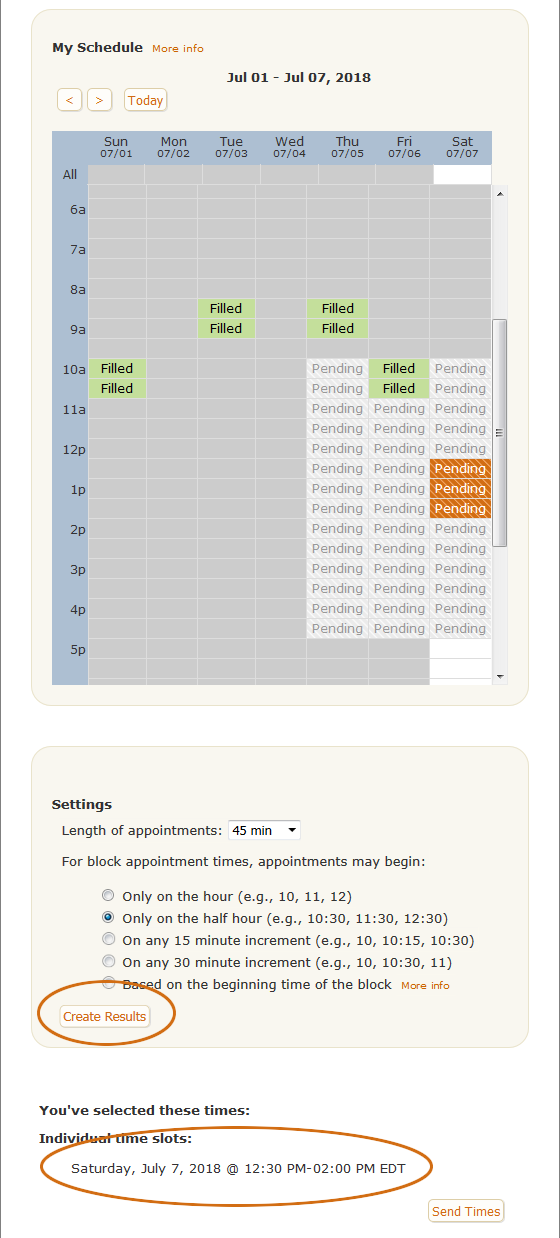
- On any 15 minute increment (e.g., 10, 10:15, 10:30)
Using the same time block as above, this setting would allow appointments to begin at 12:30, 12:45, 1:00, 1:15 and so on - again, depending on the length of the appointment.
- On any 30 minute increment (e.g., 10, 10:30, 11)
This would allow appointments to begin at 12:30, 1:00 and 1:30 - again, depending on the length of the appointment.
- Based on the beginning time of the block
This one is a little more difficult to understand but very handy. Let's say that you routinely see clients for 45 minute appointments and on Monday, Wednesday and Friday, you generally start on the hour, whereas on Tuesdays and Thursdays appointments begin on the half hour. When filling out an Appointment Request form, you could drag across all times from 8am - 5pm on M, W, F and from 8:30 - 5:30 on T and Th. Since times that are already filled would never be sent as available times, this would effectively send all available 45 minute slots for your whole week. In other words, times on Monday, Wednesday and Friday would only begin on the hour and times on Tuesday and Thursday would only begin on the half hour.
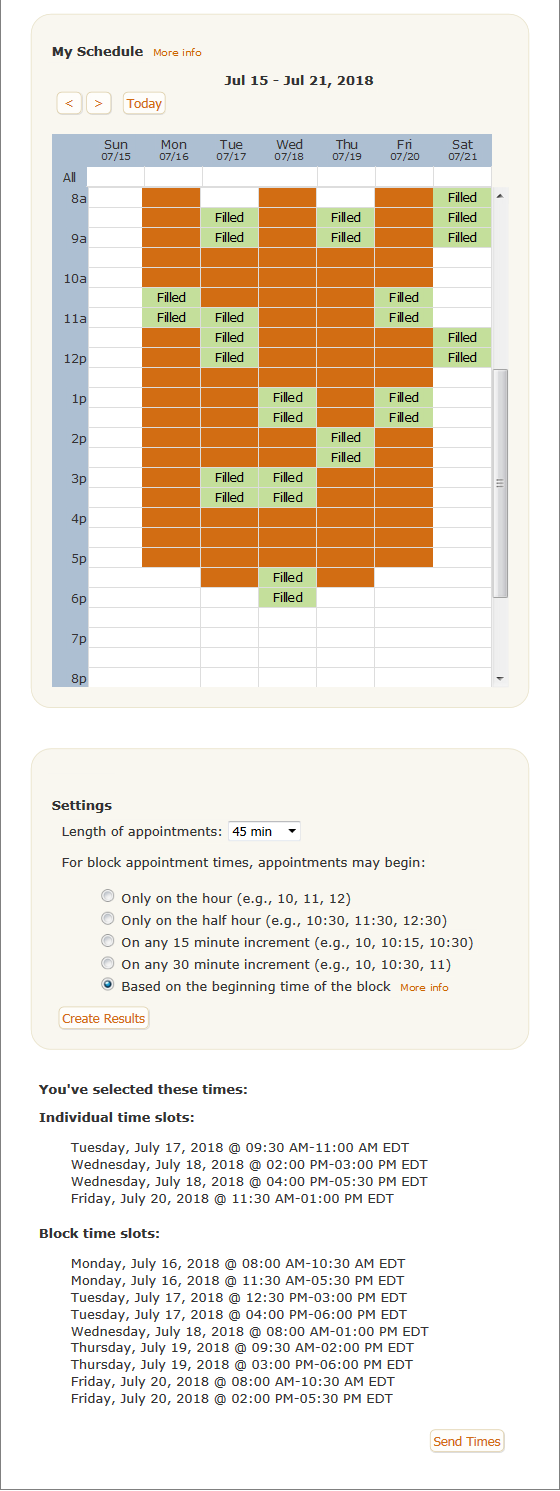
- Only on the hour
Overlapping Appointment Times
Notice that when a client is NOT restricted to choosing only one time, depending on the other variables the therapist chooses, it might be possible for the Portal User to select two or more times that overlap. For example, consider the situation where the therapist does these things:
- Unchecked the "Restrict this individual to selecting one appointment" checkbox in the Recipient Info section of the Appointment Request form.
- Selected a time block from 9am - 3pm in the My Schedule section.
- Selected an appointment length of 45 minutes and a begin time of "On any 30 minute increment" in the Settings Section.
When the user clicks Create Results, they are given a red warning, alerting them that the user will be able to check overlapping times. For example, you can see in the screenshot below that this Portal User could schedule times for 9:00 - 9:45 and also 9:30 - 10:15. That would essentially mean that they'd have one long session from 9:00 to 10:15. Or alternately, they could check ALL the boxes and end up with a super long appointment from 9:00am - 3pm. These possibilities may or may not be what the user intended. If they are NOT what the therapist intended to do, they can change one or more of the variables they previously set and click "Create Results" again until they get the times they want to send:

If this result is NOT what the therapist intended, there are a lot of things they can do, depending on the desired result. In addition to changing the "Restrict" checkbox, the possible appointment times, the appointment length and the starting time option, the therapist can also send more than one Appointment Request to the same Portal User. When a recipient receives more than one Appointment Request, they can choose one or more times from each Appointment Request they receive, depending on whether the "Restrict" checkbox is checked.
The next section will discuss what happens when you send your Appointment Request, i.e., what your client or other Portal User sees. To do this, we have to understand what Portal Calendars are and how they work.
Portal Calendars
What this isPortal Calendars allow clients and other Portal Users to see all appointments they have with the therapist and also to view and respond to any Appointment Requests the therapist might send.What it looks likePortal Calendars are very similar to the therapist's calendar except since Portal Users don't need the same tools the therapist does, there's no left nav and no hamburger menu: 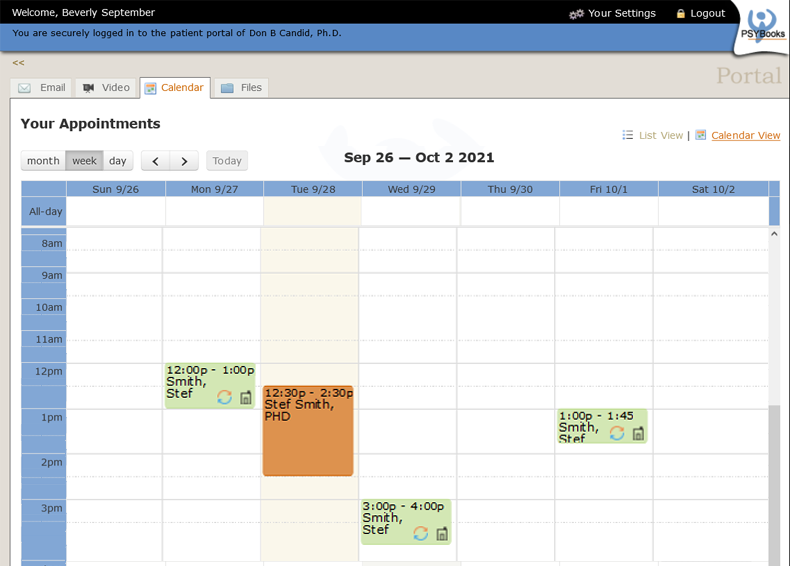 |
Where this isPortal Calendars are a tab in a client's Portal. Therapists do not have Portal Calendars. 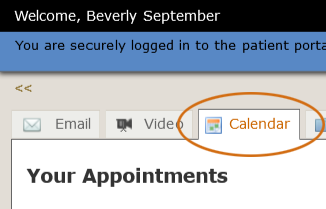 |
Therapists don't need Portal Calendars. All tools for working with their appointments are on their regular Calendar page. In contrast, since a client's version of PSYBooks IS their Portal, their calendar appears there. Additionally, all other non-client Portal Users will also have Portal Calendars. A Portal Calendar displays all of the Portal User's appointments with the PSYBooks account holder. For clients, this would likely mean their therapy or testing appointments whereas for other Portal Users, this could include professional and/or social meetings the subscriber has with them. Unlike the therapist's calendar, however, Portal Users cannot use their PSYBooks calendar as their regular calendar. Their Portal Calendar is only for keeping track of appointments or other scheduled meetings with the PSYBooks subscriber.
Portal Calendars have both Calendar and List views that can be toggled. Links to the two views appear at the top of each page. PSYBooks remembers the user's last choice and will open to that view the next time the client accesses their Portal Calendar. The List View of a Portal Calendar looks similar to this:
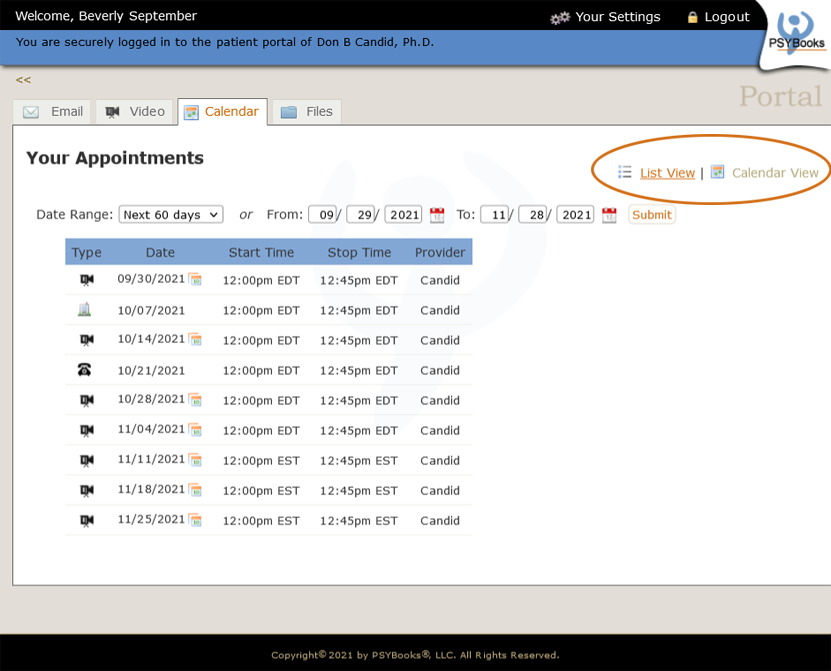
In contrast, the Calendar View looks like a regular calendar:
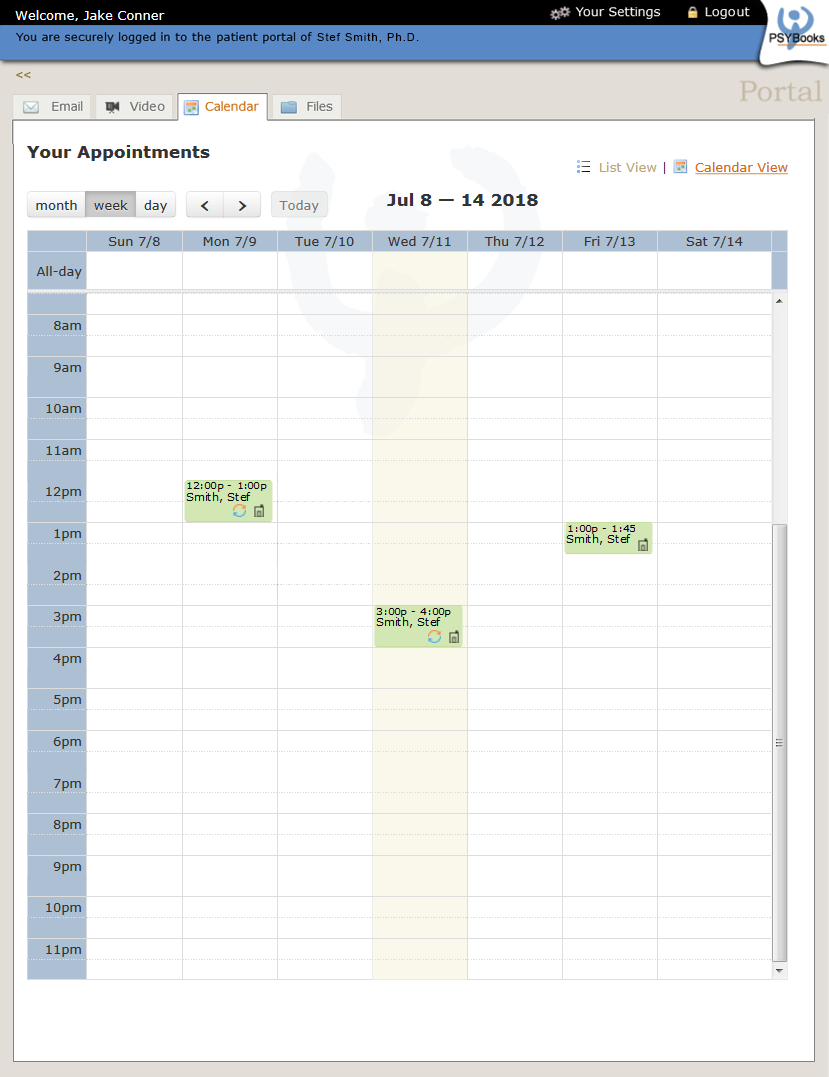
Portal Calendars play a huge role in the Appointment Requests tool. When a therapist sends a client (or other Portal User) a notification from the Appointment Request tool, that person receives either an email or a text - whichever was specified - telling them that the therapist has sent them some possible appointment times. The email or text has a link that takes them to their PSYBooks Portal, where they can log in and view the times that were sent on their Portal Calendar.
To demonstrate, let's say the therapist selects a time block of 12:30 - 3:30 on a Monday for a client named Brenna Jones:
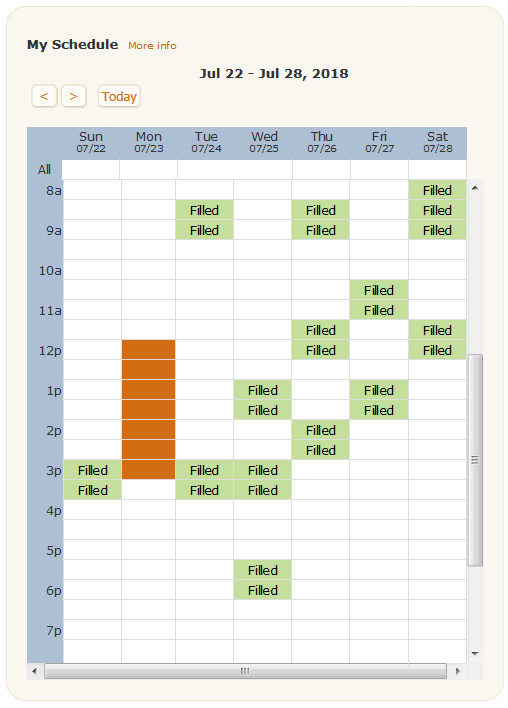
The length of appointment is 45 minutes and it's to start on the hour. When the results are created, notice in the "You've Selected These Times" section at the bottom that only three actual appointments can be created because of the variables chosen in "Settings", i.e., a 45 minute length and only able to start on the hour:
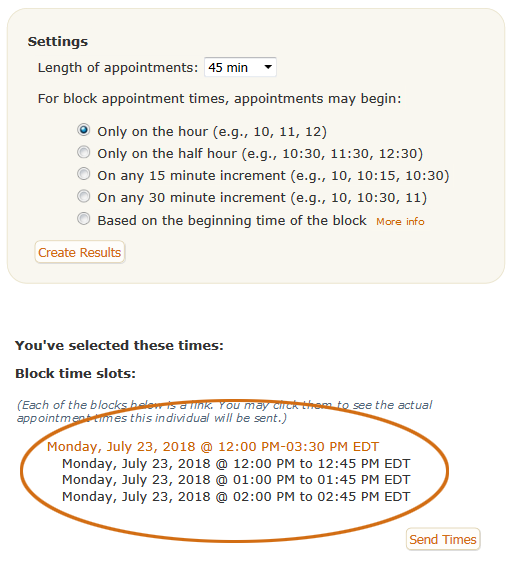
After the therapist sends those times to the client, their own calendar displays that entire time block as "Pending" with the client's name in it. Pending time blocks have a distinctive gray background with diagonal stripes, enabling both therapist and Portal Calendar users to easily see which appointments are set and which are only pending:
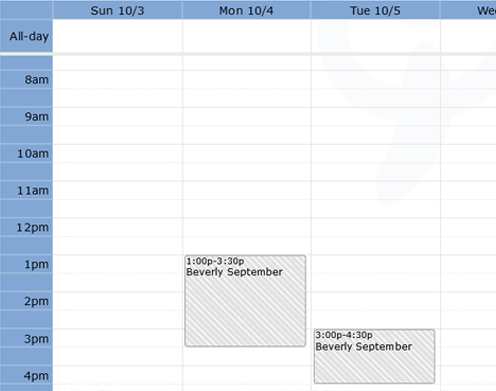
On the recipient's end, if they are already a Portal User, they'll simply receive an email or text, telling them to sign in to their Portal and check their calendars for possible appointment times. Non-portal users first receive a Portal User invitation, allowing them to create a Portal User account and then sign in to their calendar. In either case, once they log in, the List View of their Portal Calendar would look something like the screenshot below. Notice that the new possible appointment times the therapist sent are displayed at the top of the form in the colored block, whereas their existing appointments or meetings are listed in the table at the bottom:
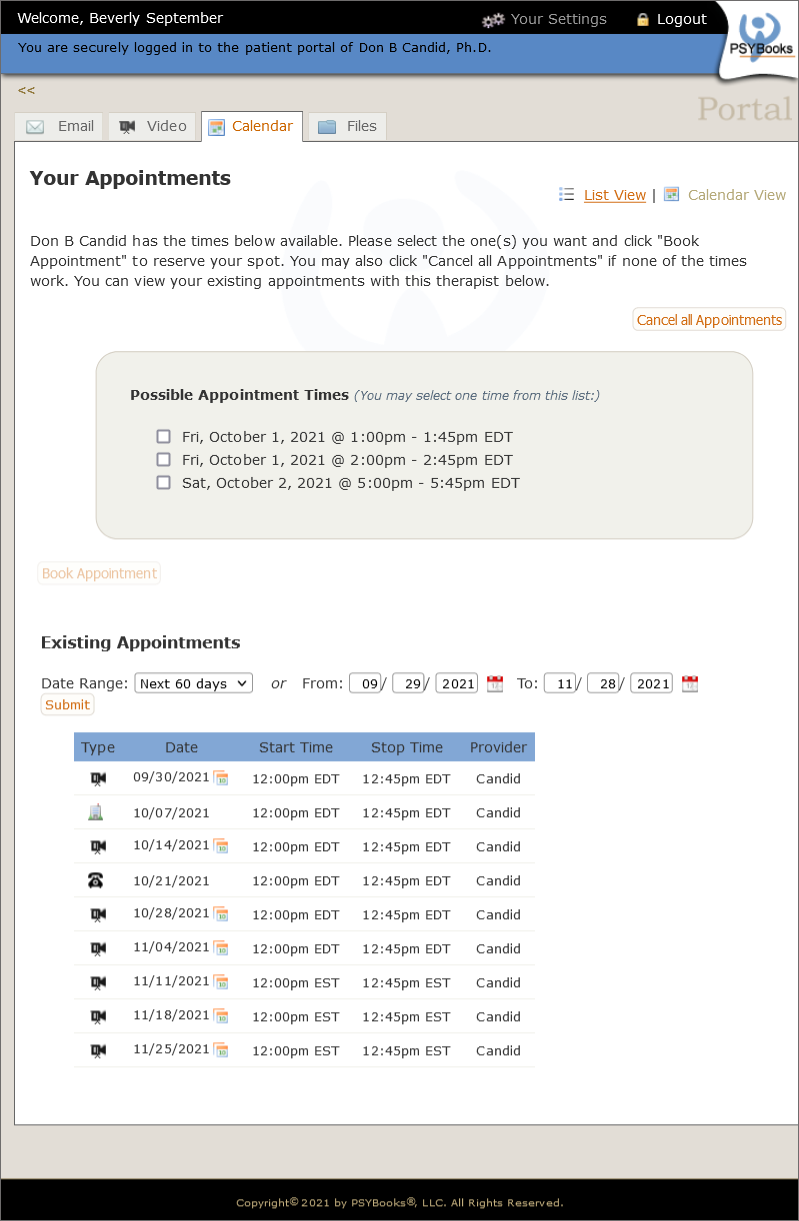
Assuming at least one of the appointment times works for the recipient, when they select the checkbox they want, the "Book Appointment" button becomes enabled, allowing them to actually book the time. When they click "Book Appointment", the therapist's calendar updates accordingly, i.e., the pending block is removed and the time the client selected will be listed as a regular appointment. If the therapist requested to be notified of the client's choices, they will also receive an email and/or text telling them what the client chose.
If none of the appointment times work for the client, they can click the "Cancel all Appointments" button at the top. If they do, a small confirmation window with a note field opens:
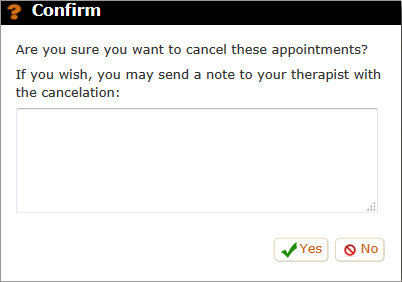
If the client chooses to include a note with the cancellation, it will be sent via PSYBooks Email to protect any PHI the client might include in the note. However, if the client cancels without sending a note, the therapist will be notified by regular email and/or text, depending on what they chose in the "My Notification" section of the original Appointment Request. Whether or not the therapist asked to be notified, when the client cancels all appointments, the entire pending block on the therapist's calendar is removed. In other words, the therapist's calendar will stay up to date whether or not they chose to be notified by text or email.
One more thing to discuss in the List View of the Portal Calendar is the Type column in the Existing Appointment section. In the screenshot of Brenna Jones' Portal Calendar above, the Type column looked like this:
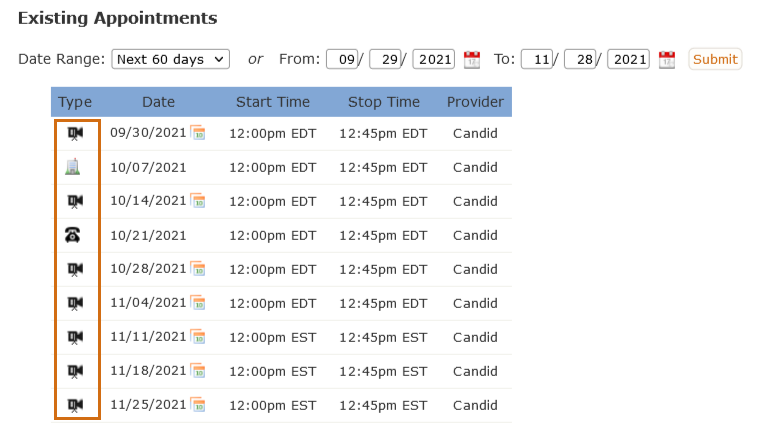
Notice that both of Brenna's appointments have an office building icon in the Type column, indicating that those appointments are in the therapist's office. However, there are other options.
The Type designation comes from the Add Appointment form, which has a place on the form to indicate whether the appointment is in the Office, a Video session, or over the phone. The default is "Office" but it can be changed:
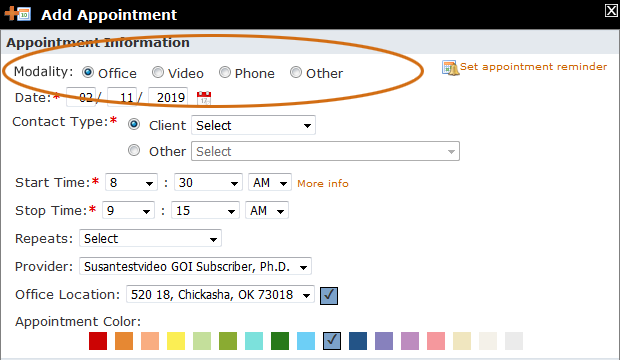
When appointments are displayed in the List View of the Portal Calendar, the Type column is used to designate which radio button was selected on the Add Appointment form. To illustrate a little more variety, the Type column on a client's existing appointment table with appointments of all three types might look like this:
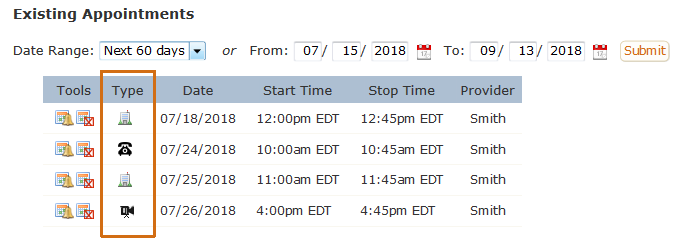
The Calendar View of the Portal Calendar
Toggling from the List View to the Calendar View for that same client shows this page:
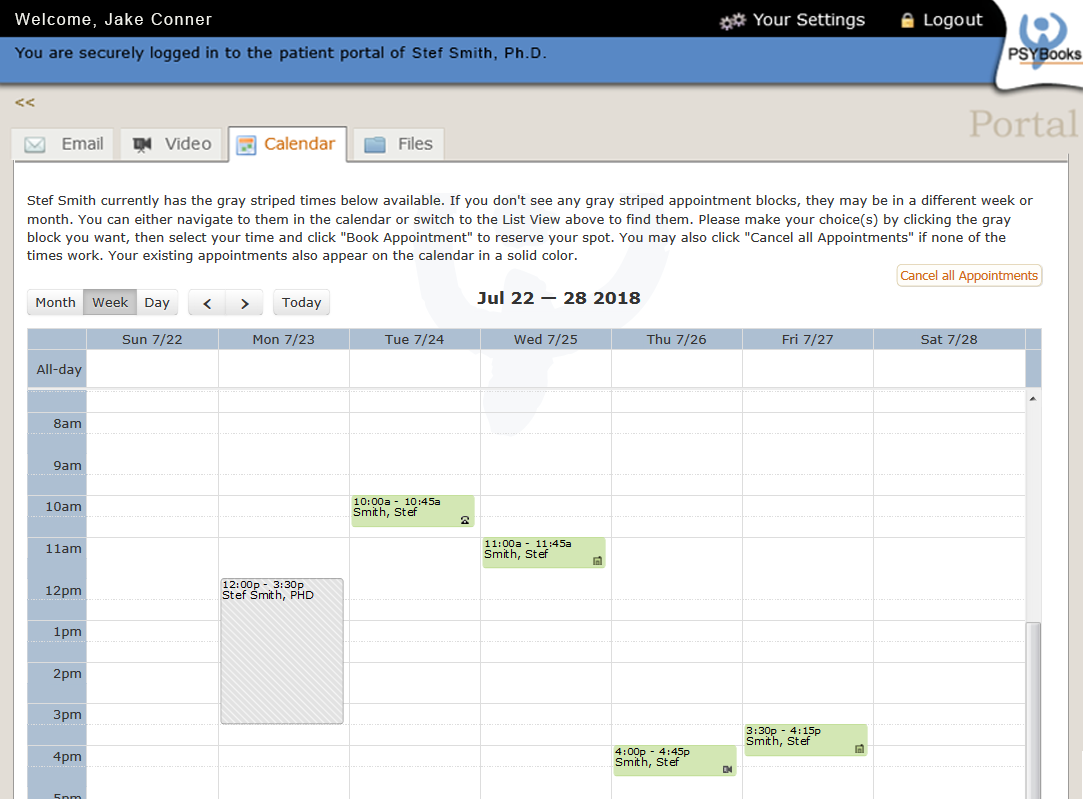
Again, both the existing and the possible (pending) times are displayed although this time, they're appointment blocks like on a regular online calendar. The client's existing appointments are marked with the type icons discussed above, allowing them to easily see what kind of appointment each is:
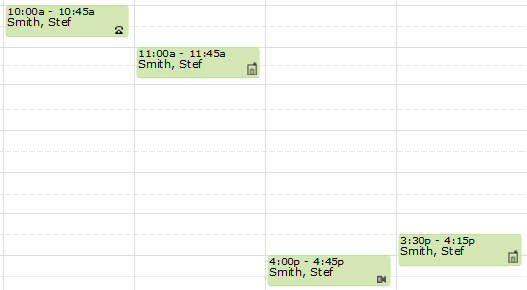
If the user clicks a striped "pending" block, a separate window will open allowing them to specify which time within the block they'd like:
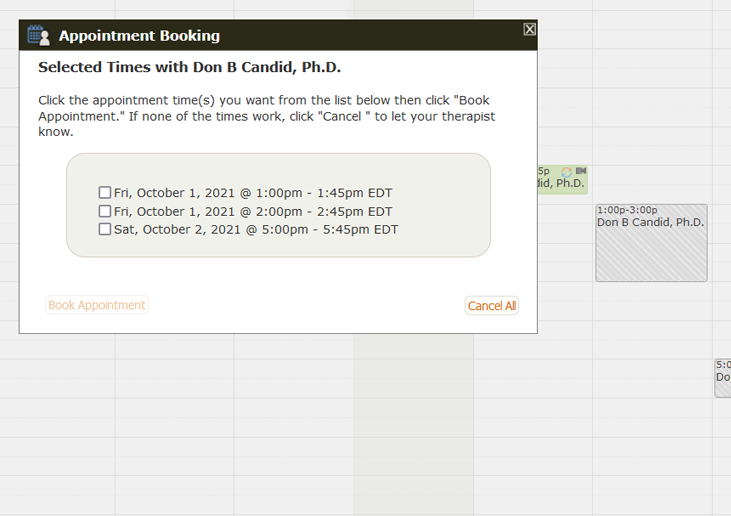
As with the List View, the recipient can either Book an Appointment from this window or cancel all appointments in this time block. The therapist's calendar will be updated accordingly and, if requested, the therapist will also be notified of the action.
Add Appointment
What this isThe Add Appointment tool is used to add both client appointments and other events to the calendar.What it looks likeThe best way to access the Add Appointment tool is by clicking the calendar. However, there's also an Add Appointment tool under the hamburger menu on the right that looks like this: 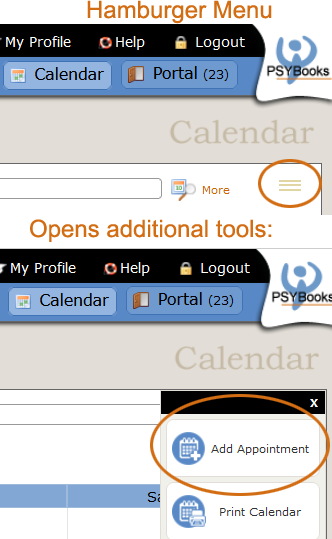 |
Where this isYou can access the Calendar from the global nav at the top of every page or from the Sitemap links at the bottom. The Add Appointment tool is on the left nav or can also be accessed by clicking the calendar. |
There are two ways to access the Add Appointment tool: 1) by clicking the correct time slot on the calendar or 2) by using the Add Appointment tool, which is one of the hamburger menu tools. The form that opens is identical, but accessing it via the calendar can save you some clicks because the date and time will already be filled in. For example, the Add Appointment form below was accessed by clicking on the 10:30am time slot on December 29, 2018. The items with orange arrows were pre-populated:
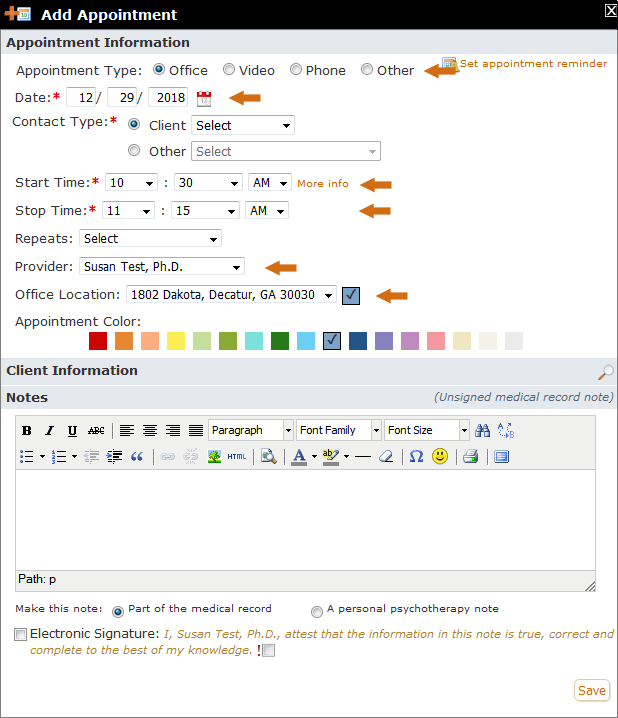
Notice that since the default Contact Type is "Client" (i.e., a client appointment), the Stop Time is automatically set for 45 minutes later than the start time. However, the Stop Time (and/or the Start Time) can be changed on this form. The defaults are just PSYBooks' best guess about what you might want. If you change the Contact Type to Other Event, the Stop Time would change to 12:00pm, i.e., one hour after the Start Time.
If you had opened this tool from the hamburger menu, you'd have to fill in the Date, Start Time and Stop Time fields manually. However, by clicking on the calendar, in many cases, all you'll have to do is select the client's name from the Client Select box and click Save since the most commonly used items will already be filled in.
Types of Appointments
PSYBooks allows you to enter different types of appointments. The two broad categories of appointment types are "Client" and "Other." The Other category subdivides further into Person, Event and Group Appointments. The Client appointment type is for individual client appointments. The Other appointment type - with the possible exception of Group Appointments - is for people and/or events who are NOT clients. Each appointment type has features that are specific to that type, giving you a variety of tools and maximum flexibility in working with appointments.
Client Appointments
The default appointment type is for adding clients. All of your existing clients will be listed in the dropdown box, allowing you to easily select the one you want.
In addition, you can also add new clients from the Add Appointment tool. If you open the Client select box on Add Appointment, you'll see an orange link for Add Client:
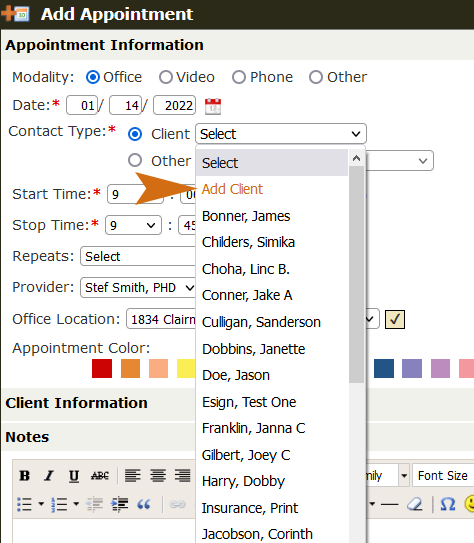
Clicking the Add Client link opens an abbreviated version of the regular Add Client form. This abbreviated version is specifically designed to allow you to quickly add a minimal amount of client information you might need to schedule an initial appointment. This abbreviated Add Client form looks like this:
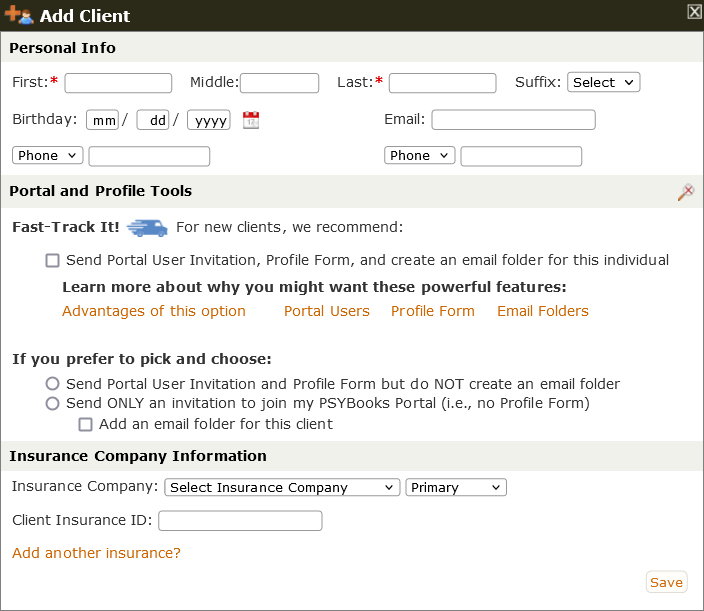
If you click Complete Setup in the Portal and Profile tools section, it will allow you to get this new client completely set up, including being able to send any Custom Forms and/or files you typically send to new clients.
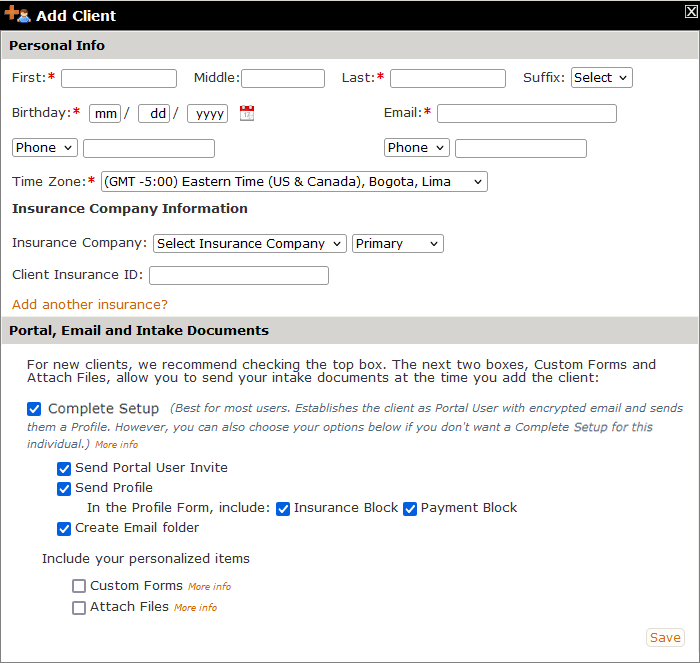
For more information on the Portal and Profile part of the form, check the Add Client section of this Manual.
Once you click Save on the Add Client form, you're taken back to the Add Appointment form which is now populated with the information you just entered:
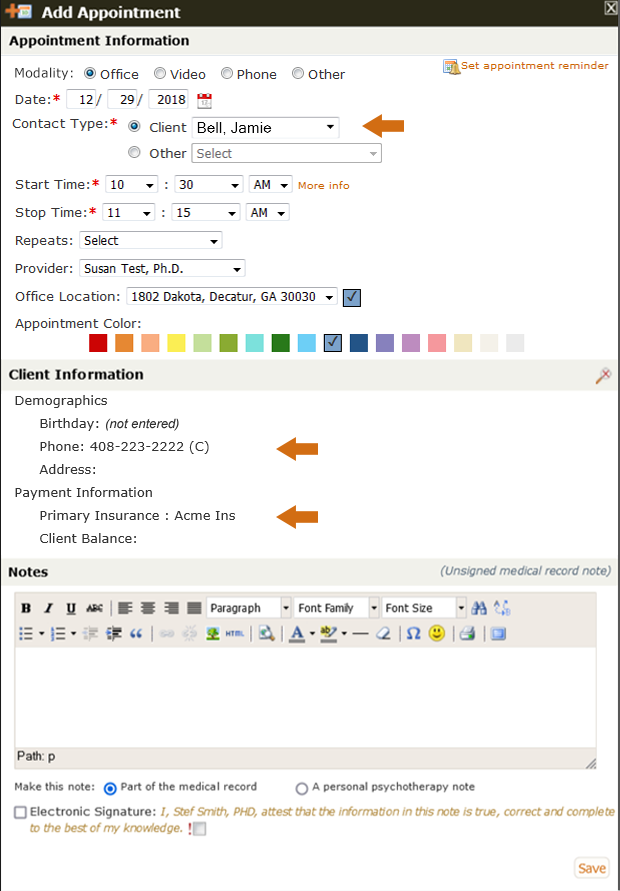
You can now click Save and the appointment will be added to your calendar or you can make additional changes to the Add Appointment form.
Other Appointments
In contrast, Other appointment types are often NOT clients. When you select the "Other" appointment type and then click the dropdown box, you'll see something that looks like this:
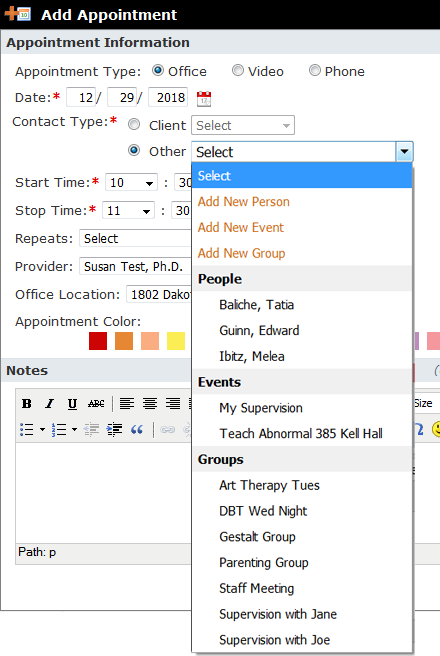
Notice at the top are three links where you can add any of the three "other" appointment types: Person, Event and/or Group. Below the links, you see lists of those other appointments that you've previously saved, arranged by category.
Each of the Other appointment types - Person, Event and Group - will be discussed below:
Add New Person
The Person appointment type is for other individuals who are NOT clients with whom you somewhat regularly schedule appointments or meetings. By saving them to your other appointment contact list, you'll be able to enter them from a dropdown list instead of having to type their name each time. The other advantage of saving an Other > Person appointment is that you can send them appointment reminders. Even for one-time appointments, you might choose to save the contact if you want to send them an appointment reminder. You can always delete them later with the Manage Other Person/Events tool, if you choose. Your Person contacts could be personal and/or professional contacts. For group practices and/or practices with admin staff, it may be helpful to add other subscribers and staff as Person contacts.
The "Add New Person" form looks like this:
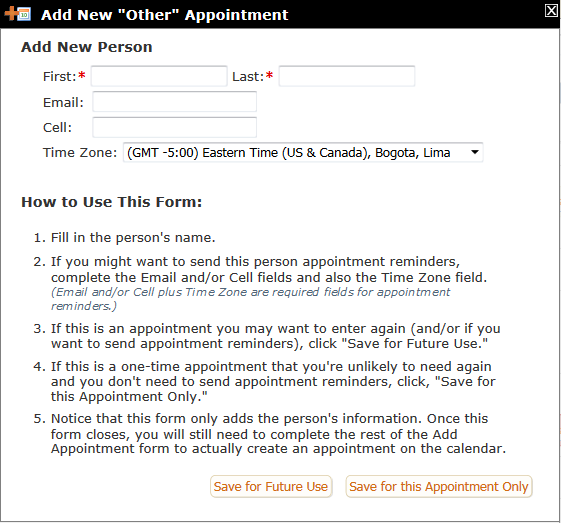
Notice that the only two required fields are first and last name. However, if you might want to send appointment reminders to this person, you'll need to fill in the Email and/or Cell fields. The Time Zone select has been pre-selected with your time zone, but you can change it if that's not correct.
If you look at the buttons at the bottom of this form, you'll see that there are two ways to save a Person contact: "Save for Future Use" and "Save for this Appointment Only." Both buttons will allow you to schedule the appointment. If you choose "Save for Future Use," the contact will be added to your dropdown list for Other appointment types so you can easily schedule appointments for them in the future. Also, by saving the contact, you'll be able to send this new person an appointment reminder if you so choose. The other button - Save for this Appointment Only - does neither of those things but does allow you to enter a one-time appointment.
Add New Event
As the name implies, the Event appointment type is for an event as opposed to an individual person. It could be an event with another person (e.g., Dinner with Josie), but what you're listing in the calendar is the event itself. For example, if Josie is someone with whom you do a lot of things, you might want to be able to distinguish between whether you're getting together with her for dinner, a meeting, or something else. The Event appointment type lets you do this. A distinguishing feature of events, is that, although they will be listed on your Daily Schedule appointment reminder, no one else will receive appointment reminders for events. So in the example just given, if you want to be able to send Josie an appointment reminder, you'd want to list her as an Other > Person contact instead.
The "Add New Event" form looks like this:
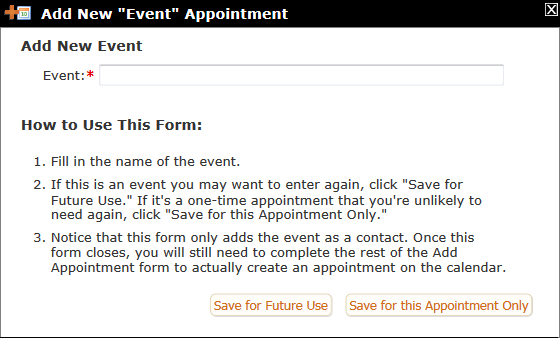
The only field on this form is the name of the event. You can make event names fairly long. For example, if you wanted, you could list the name of the venue plus its address and phone number. That way, you'll have all the info in one place.
As with Person contacts, you can save Events for future use or just for this single appointment.
Add New Group
The Group appointment type allows you to schedule appointments for two or more people at one time. You might want to create a Group contact for therapy-related groups such as couple's therapy, family or group therapy sessions or even for non-therapy appointments such as staff meetings, supervision, webinars, courses you're teaching or even some social occasions. When you create a group appointment type, you have access to a set of tools in the "Manage Groups" supertool (discussed below) that are not available with any other appointment type. Learning more about the features of this tool will help you decide whether to designate an appointment as a Group as opposed to a Person, Event or possibly just a single client appointment.
The "Add New Group" tool looks like this:
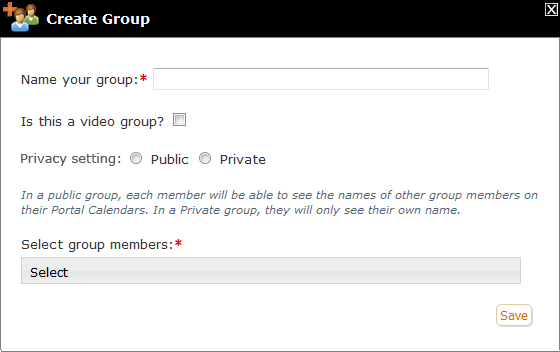
Each of the fields on this tool will be discussed below:
- Name your group
Give your group a name you'll recognize. This is the name that will appear on your calendar when you schedule appointments for the group.
- Is this a video group?
Clicking this box will give you a confirm which asks if you'll be using PSYBooks video. If you are, any appointments you enter for the group will sync with SecureVideo. You'll be able to work with tools on either your PSYBooks video tab and/or your SecureVideo dashboard.
- Privacy setting
For participants who have a Portal calendar, such as clients and "Other" appointment types, this setting determines whether they see only their own name in this group (Private) or whether they see the names of all group members (Public).
- Select
When you click the Select dropdown, a list will open that's been pre-populated with the names of your PSYBooks contacts you might want to add to your groups. This includes your clients, other subscribers in your practice who use PSYBooks, any users you've added, plus your "Other People" individuals. You can use the search or just check the boxes beside the names you want to add to your group. Clicking Save will create the group with your group members in it:
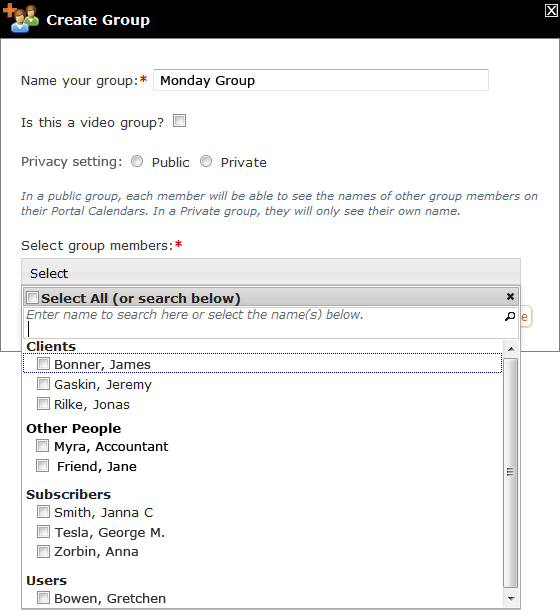
- Therapy or Non-Therapy
If you add at least one client to your group, you'll get an option on the form that will allow you to mark it as a therapy group or a non-therapy group:
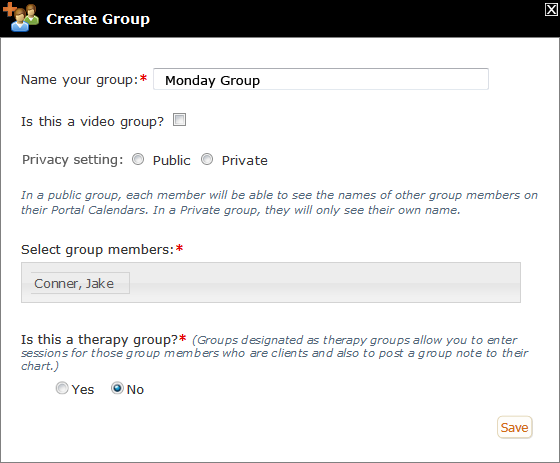
If you mark a group as a therapy group, you'll be able to write group notes which can automatically be entered in each client's chart, and also to add sessions for all group members from the Manage Groups tool, which is discussed below. Both therapy and non-therapy groups also allow you to track attendance and to add group notes for yourself on your "Tools > My Notes & Reminders" page
Appointment Features
The Add Appointment form has some additional tools you can use if needed. Each will be discussed below:
- Appointment Modality
The Modality tool allows you to select whether the appointment will be in your office (the default) or whether it's to be a video or a telephone appointment:
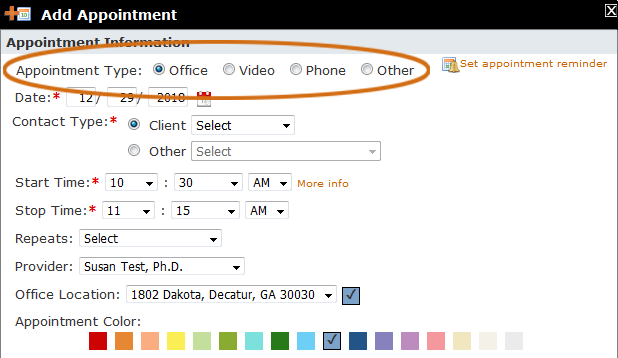
Depending on your choice, the appointment will be marked with the corresponding identifying Modality icon on your calendar (the "Other" Modality does not have an icon):
Office:

Video:

Phone:

The screenshot below shows three appointments, each with a different appointment modality, as can be identified by looking at the icons on the top right of each appointment block:
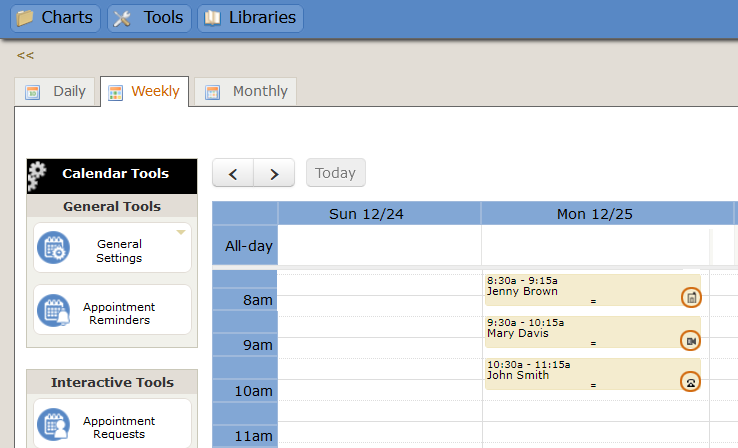
— Video Sync
The Office and Phone appointment types on the Add Appointment tool are just informational. Designating an appointment as an Office or Phone appointment type does nothing except add the corresponding icon to your calendar. However, marking the appointment type as Video has some important implications. When you select Video as the appointment type, you'll get a confirm box asking you if you plan to use PSYBooks video for this appointment:
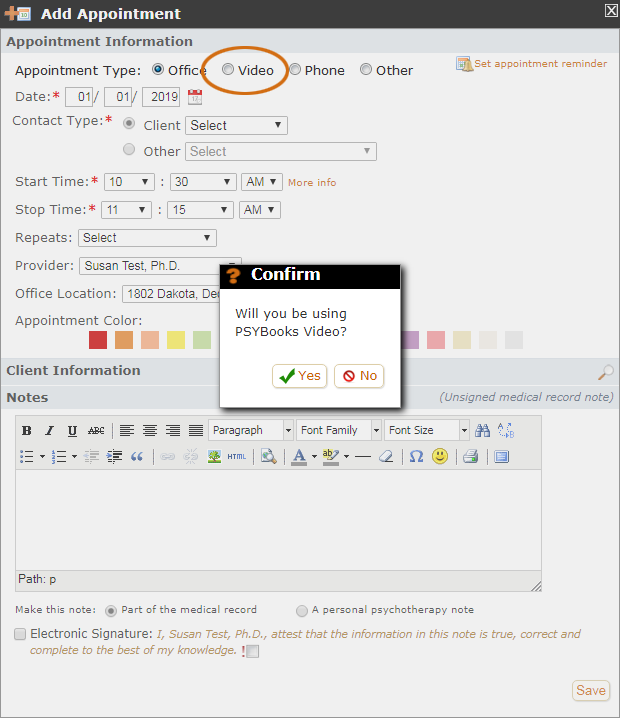
If you are not using PSYBooks video and select "No", the Video appointment type is treated like Office and Phone appointment types, i.e., the only thing that happens is the addition of the appointment type icon on the calendar. However, if you ARE using PSYBooks video and select "Yes," it triggers the video sync feature of the program. That means that anything you enter here will also appear on your Secure Video dashboard. You will not have to enter appointments in both places. Just entering them on your PSYBooks calendar will automatically tell SecureVideo to schedule the appointment with the person or persons you indicated. SecureVideo will then send their normal invitations and reminders so the recipients will get links to join the session, just as if you had entered it on SecureVideo.
If you answer "Yes" to the confirm box above, your Add Appointment form will change slightly, to allow you to enter the additional information that's necessary to schedule a video appointment:
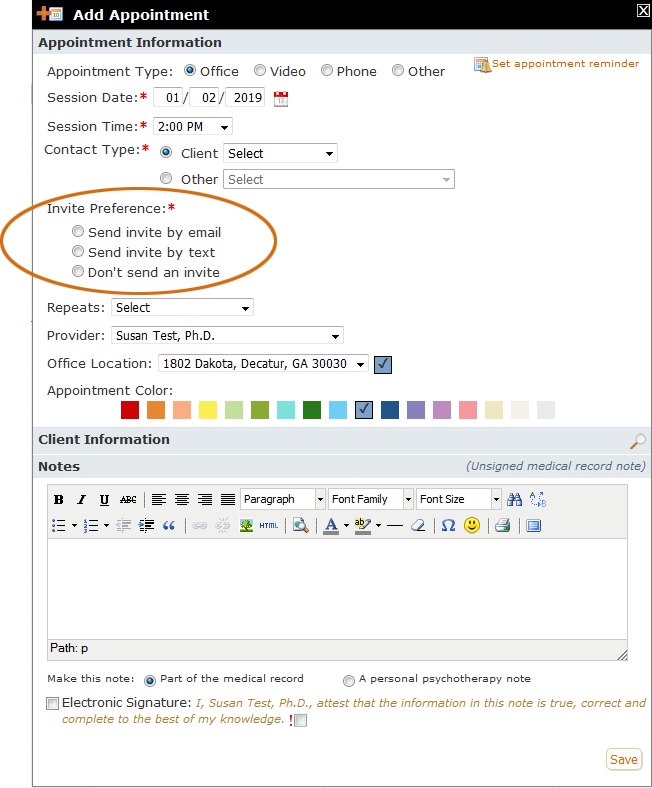
Notice that you still have access to the other features on the Add Appointment form, which means you can change the Contact Type to a non-client type or a group, you can make this a repeating appointment, add an appointment note, etc. Being able to schedule your SecureVideo appointments on your PSYBooks calendar gives you access to all of the regular features of the Add Appointment tool which gives you much more flexibility.
- Repeats (Create a Repeating Appointment)
Repeating appointments are extremely common among mental health practitioners so PSYBooks makes them easy to enter. The Repeats select box is right on the Add Appointment form as can be seen below:
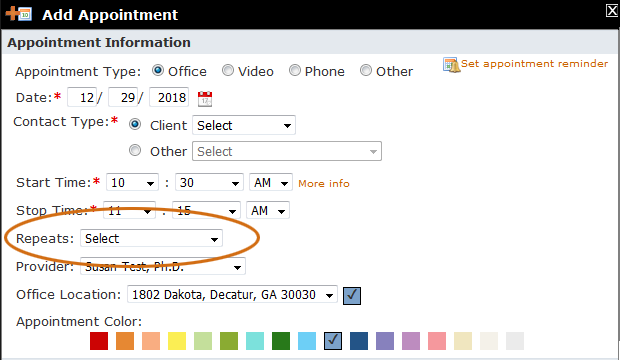
Repeating appointments will be discussed in detail in a separate section below.
- Provider Select Box
In GOI accounts (GOI = Groups of Individuals, i.e., more than one subscriber at the same address), therapists may choose to share their calendar with one or more therapists in their office and/or with their office manager. In these situations, assuming those individuals have been given both read and write permissions, they can select the calendar you need with the Provider Select Box. Individual subscribers will not have this feature. Only one name will be listed in an individual subscriber's Provider Select Box:
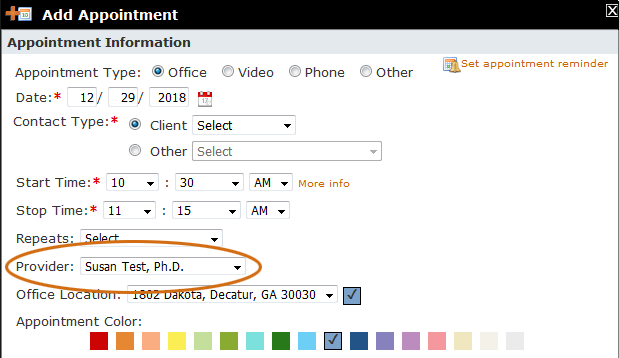
- Office Location Select Box
The Office Location select box looks like this:
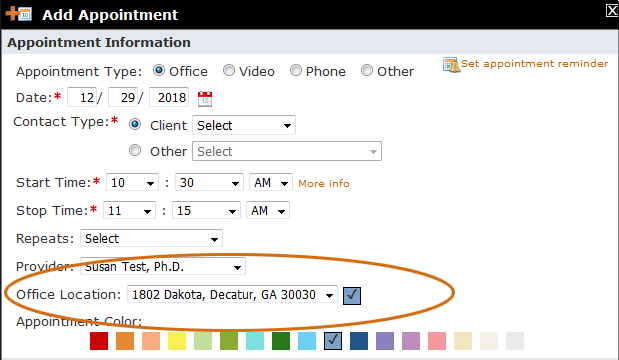
If you only have one office, you will never need this tool. However, if you entered more than one office address in PSYBooks, each one is given a different color by default to help you keep your appointments straight. (You can change your default office color(s) at any time in the Calendar Settings tool.) Assuming you have not changed the default colors, watch what happens when we change this therapist's Office Location in the Add Appointment tool:
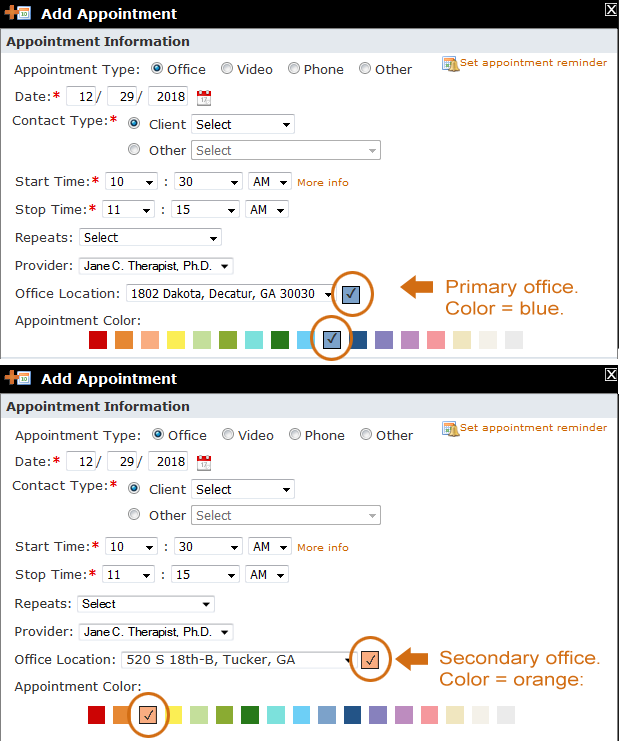
In other words, when Jane Therapist adds appointments to her first office address, they'll all be in blue (unless she changes the color for a specific appointment). If she changes the Office Location setting to her second office address, the appointments will be listed in orange. Assuming she doesn't change any specific appointment colors, her calendar for the week might end up looking like this:
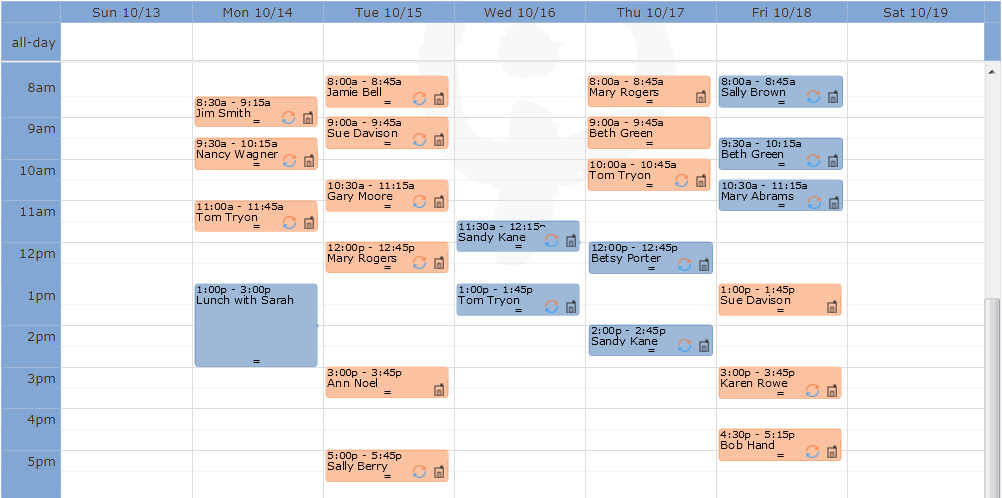
It's also possible to toggle certain office locations on or off. If you click the gold down arrow on the General Settings tool on the left nav, you'll see each of Jane's office calendars listed separately:

If you click Jane's name, all of her appointments will toggle off or on. Similarly, if you click either of the addresses, that office's appointments will toggle off or on. For example, if Jane clicked the 555 Blue St address to toggle all of those appointments off, only the orange appointments would be visible on the calendar:
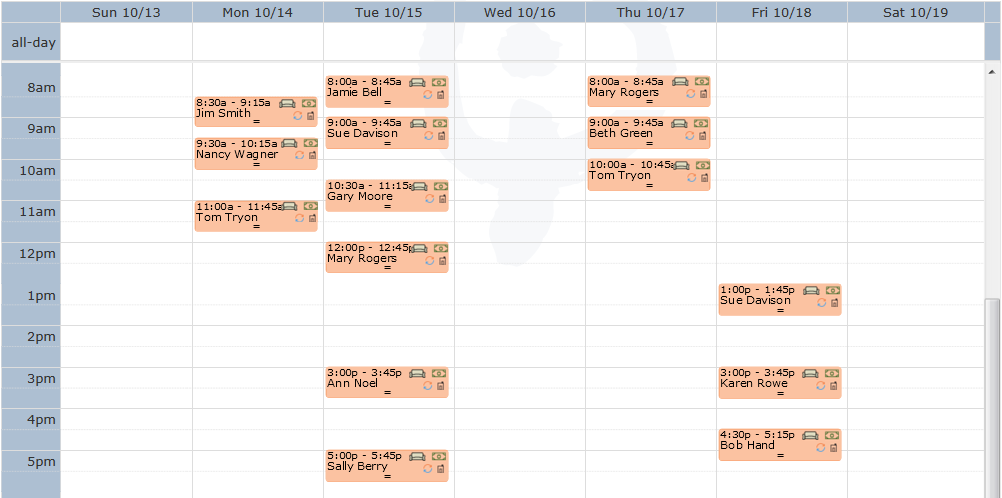
- Appointment Color Coding
Each subscriber has a default base color for their calendar appointments. Also, as discussed above, if the subscriber has more than one office, each office will be given its own default color. Although any of the default colors can be changed at any time in the General Settings on the Calendar page, all client appointments and other events added to the calendar will be created in that office's base color unless otherwise specified.
The Add Appointment form has a series of color swatches that can be used to create a different colored background for any particular appointment. This feature can be useful in making some appointments stand out from others.
In the screenshot below, you can see that Jane C. Therapist's base color is purple (the purple swatch beside her office location and also, purple is checked as the default color in the row of swatches in the Appointment Color section):
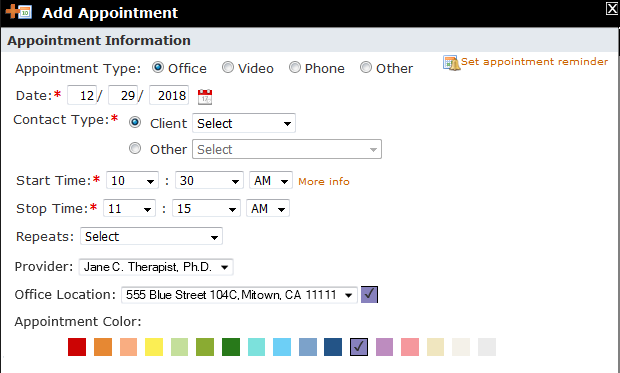
If nothing is changed, this appointment will be created with a purple background. However, Jane is free to change the color of this particular appointment by clicking a different swatch in the Appointment Color row. Changing an appointment color will NOT change the office's default color. To change the default color, you have to use the General Settings tool on the Calendar left nav. That tool is discussed elsewhere.
- Client Information Section
The Client Information Section of the Add Appointment form is just there to give you easy access to information that you may need when you're scheduling and/or changing client appointments. It's closed by default, but you can open it by clicking the magnifying glass on the right side of the gold bar that has the words "Client Information":
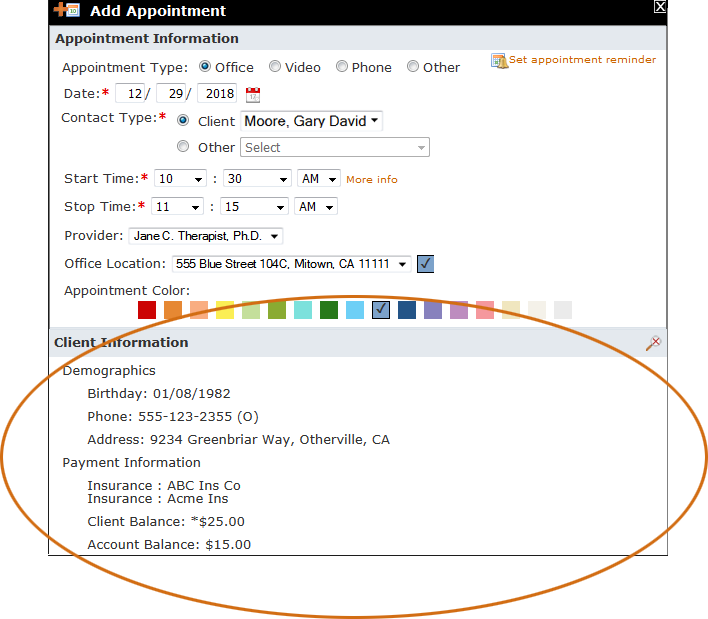
Repeating Appointments
What this isThe Repeat Appointment tool is triggered by a select box on the Add Appointment tool. It allows you to create weekly, bi-monthly, or any other type of repeated appointment that you'd like.What it looks likeThe select box that allows you to mark an appointment as a repeating appointment looks like this:  |
Where this isYou can access the Calendar from the global nav at the top of every page or from the Sitemap links at the bottom. The Repeat Appointment tool is part of the Add Appointment tool, which can be accessed on the left. |
Clicking the Repeating Appointments select box opens these options:
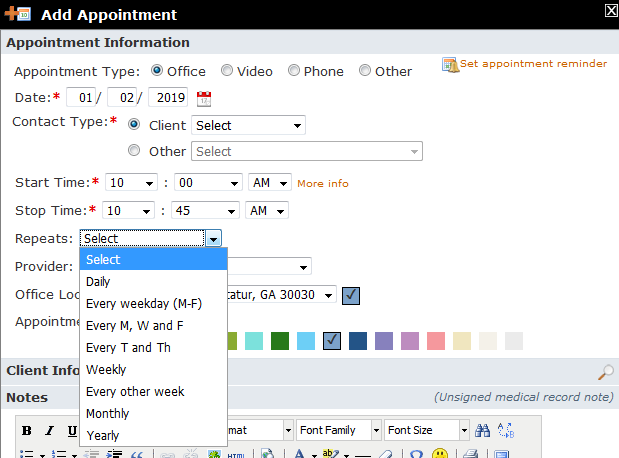
Depending on which value you select, a new section of the form will open allowing you to further refine your choice. For example, clicking "Weekly" reveals these additional options:
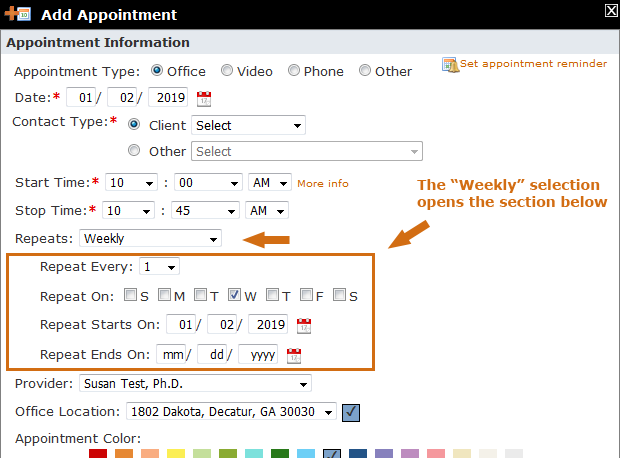
Each of the other "Repeats" selections also gives you additional filters which should allow you optimum flexibility in scheduling your repeat appointments.
Notice that you can also enter repeating video appointments. These will show up on your PSYBooks calendar like any other repeating appointment. However, on your SecureVideo dashboard, you will only see one appointment at a time. The subsequent one will not appear until the current one has passed. This is done to prevent SecureVideo from sending out reminders for more than one appointment at a time. Once one appointment in a series has come and gone, the next one will appear in your SecureVideo dashboard and the appropriate invitations and reminders will be sent. You do not need to do anything further once you've entered the repeating video appointment.
Edit Appointment
What this isThe Edit Appointment window allows you to make changes to existing appointments or events. What it looks likeThe tool to access the Edit Appointment form looks like this: 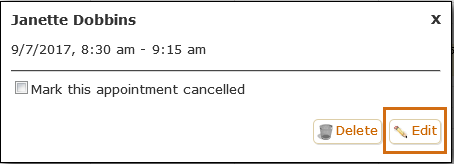 You can open this window by clicking any appointment or event on the calendar. |
Where this isYou can access the Calendar from the global nav at the top of every page or from the Sitemap links at the bottom. Clicking on any appointment or event will open a small window that allows you to edit the appointment. |
Accessing the Edit Appointment tool is a two-step process. First, you have to access the Edit Appointment Multi-Tool by clicking any appointment or event on the calendar. Once you've clicked the appointment, the Edit Appointment Multi-Tool pops open like this:
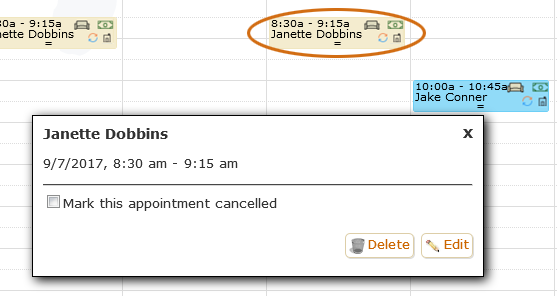
Clicking the "Edit" button on the right opens the Edit version of the Add Appointment Tool - in other words, it's the Add Appointment form but with your data already in place:
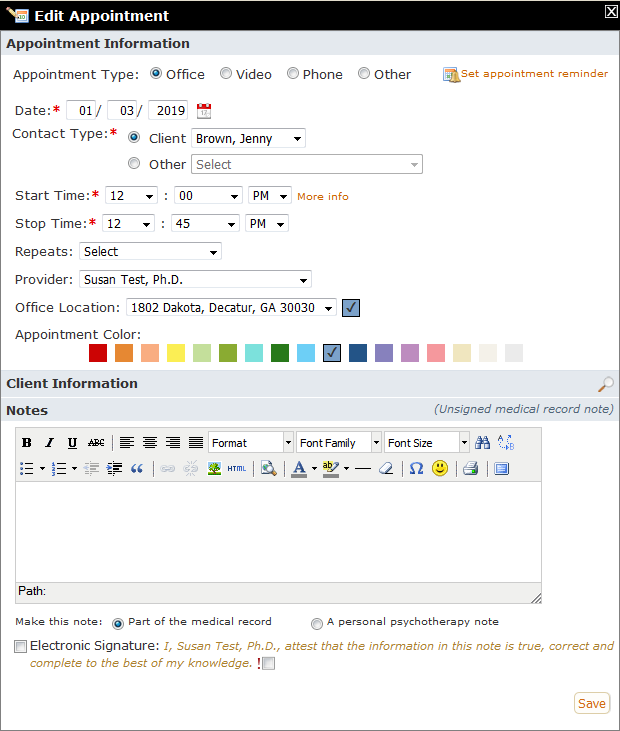
From here, you can make any changes you want to your appointment. If you change from an Office or Phone Appointment Type, you'll be asked if you intend to use PSYBooks Video, which will engage the video sync features. When you save the change, SecureVideo will send the appropriate invitation and reminder emails or texts. If the appointment is part of a series of repeated appointments, when you save it, you'll get this popup which will allow you to select which appointments you want to change:
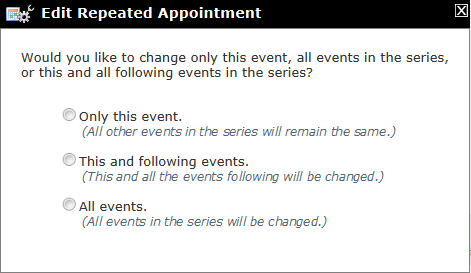
Delete Appointment
What this isThe Delete Appointment window allows you to delete an existing appointment or event. When the appointment is part of a repeating appointment series, you can delete a single appointment or a series of appointments.What it looks likeThe tool to access the Delete Appointment form looks like this: 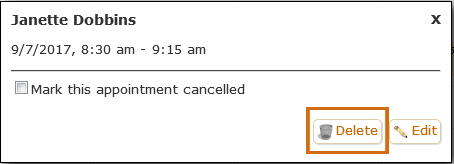 You can open this window by clicking any appointment or event on the calendar. |
Where this isYou can access the Calendar from the global nav at the top of every page or from the Sitemap links at the bottom. Clicking on any appointment or event will open a small window that allows you to delete the appointment. |
As with the Edit Appointment tool, accessing the Delete Appointment tool is a two-step process. The first step is to access the Edit Appointment Multi-Tool by clicking any appointment or event on the calendar. Once you've clicked the appointment, the Edit Appointment Multi-Tool pops open like this:

Clicking the Delete button will delete the appointment. If the appointment was a PSYBooks video session, it will also be deleted from SecureVideo and the participant will be notified of the cancellation. If the appointment is part of a series, when you click delete, you'll get this window, which allows you to choose which appointments you want to delete:
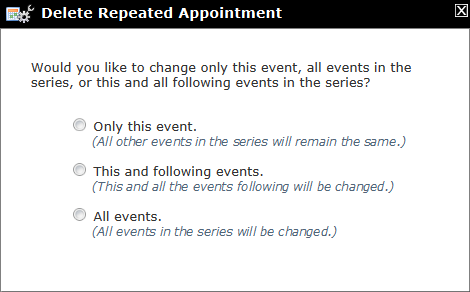
Cancel Appointment
What this isThe Cancel Appointment tool allows you to keep an appointment on your calendar, but mark it as canceled.What it looks likeThe tool to access the Cancel Appointment tool looks like this: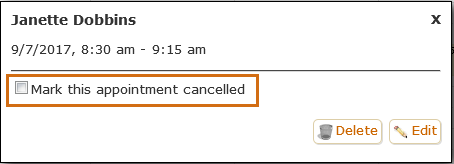 You can open this window by clicking any appointment or event on the calendar. |
Where this isYou can access the Calendar from the global nav at the top of every page or from the Sitemap links at the bottom. Clicking on any appointment or event will open a small window that allows you to cancel the appointment. |
Canceling an appointment is a way to maintain the appointment on your calendar while also visually cueing you that the appointment has been canceled. To cancel an appointment, click the appointment or event on the calendar, then check "Mark this appointment canceled." This action will expand the Edit Appointment Multi-Tool to allow you to make additional choices:
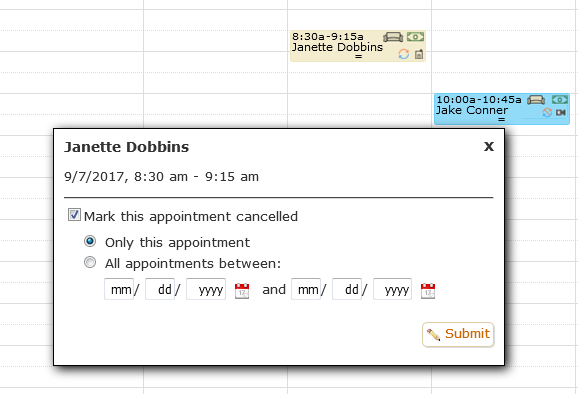
Once you've made your selection and clicked "Submit", the Edit Appointment Multi-Tool window will close and you'll notice that your appointment now has a line through it and the opacity has been reduced, making it stand out from your regular appointments:
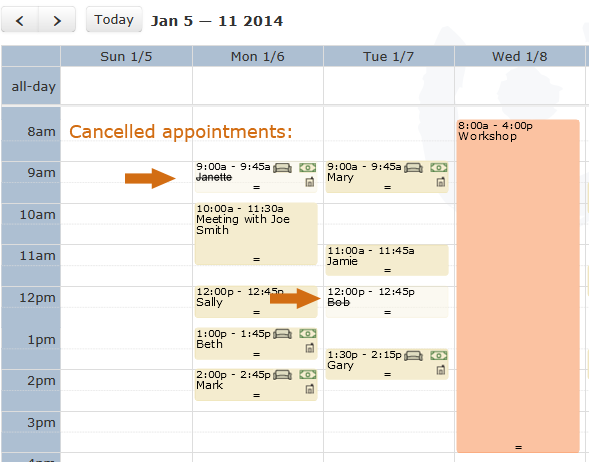
If the appointment you canceled was part of a series, only the appointment(s) you designate will be marked. If the session was a PSYBooks video session, Secure Video will get the information that the session has been canceled, will remove it from their dashboard and send the recipient a notification of the cancellation.
Print Calendar
What this isThe Print Calendar tool allows you to print out a list of the client and/or other events on your calendar.What it looks likeThe Print Calendar tool is under the Hamburger Tool on the top right side of all pages in the Calendar (Daily, Weekly and Monthly). It looks like this: 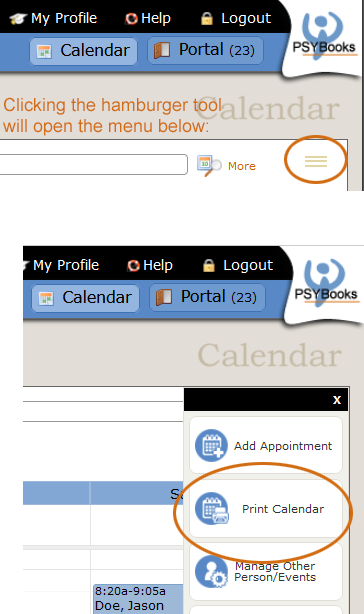 |
Where this isYou can access the Calendar from the global nav at the top of every page or from the Sitemap links at the bottom. The Print Calendar tool is in the Hamburger menu. |
When you open the Print Calendar tool, it looks like this:
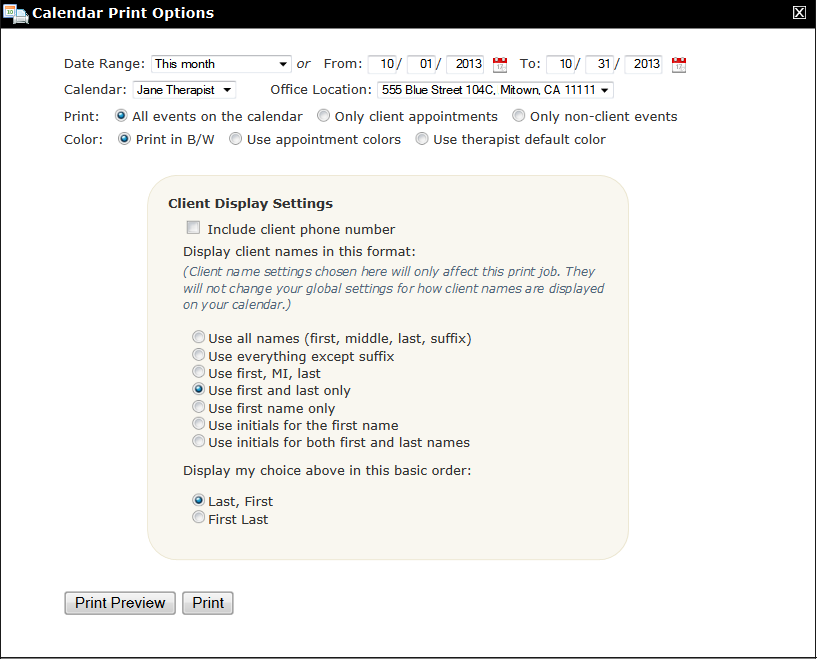
There are many filters here to allow you to select the items you want as well as the color and format you'd like them to be in. Of particular interest is the area with the gold background called Client Display Settings. This feature can be used to help keep printed copies of your schedule a little more secure by not using the full names of your clients if you feel that might be a concern.
Although it's not necessary to use the print preview function, clicking Print Preview displays an HTML version of your calendar beneath the filter like this:
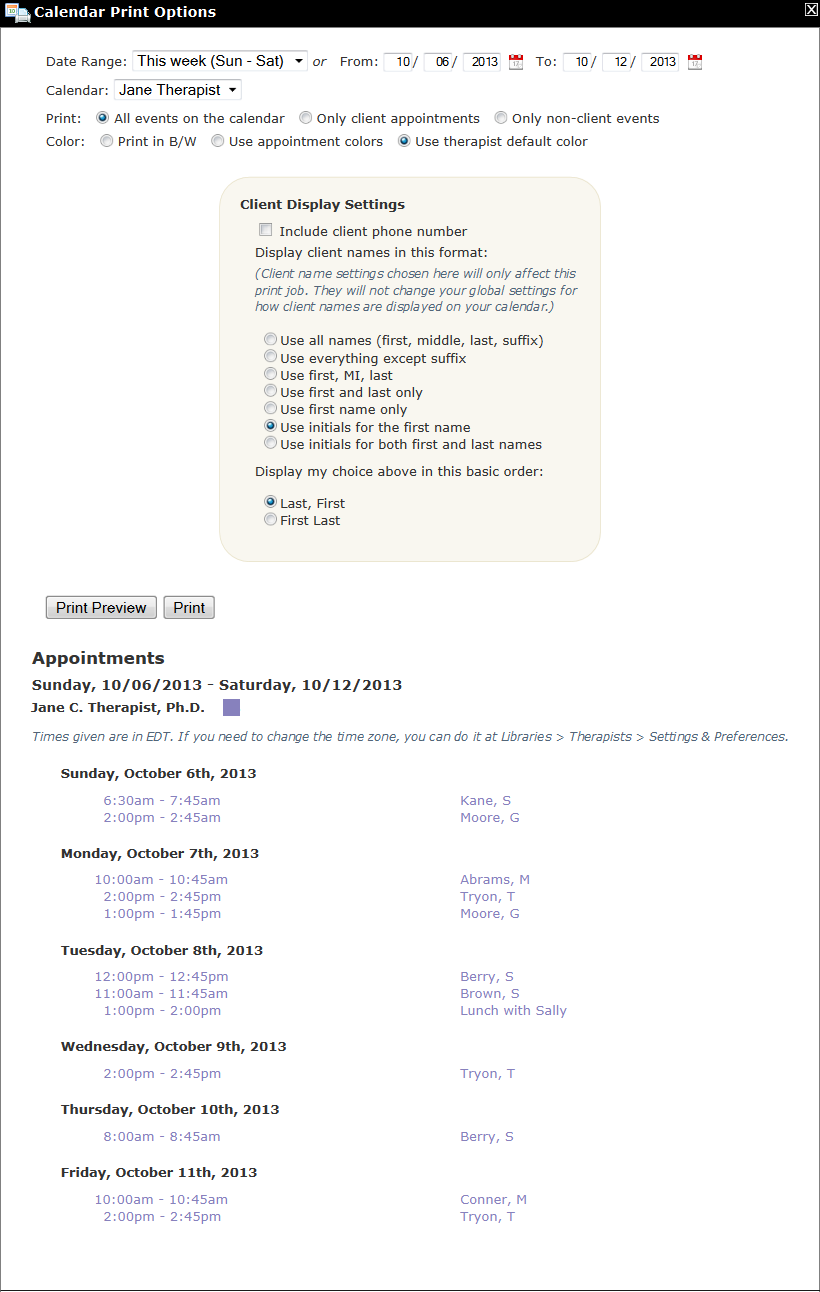
Notice that days that don't have appointments will not appear. For example, the sample above used a date range filter of Sun, Oct 6 - Sat, Oct 12. However, there were no appointments on Saturday so that day isn't listed on the calendar. Your calendar will be printed using the time zone you have listed in the Settings & Preferences section of Libraries > Therapists. On the screenshot above, it says "Times given are in EDT" because that's the time zone this particular therapist was using.
When you're ready to print, clicking the Print button will create a PDF form which you can then send to your printer.
Manage Other Person/Events
What this isThe Manage Other Person/Events tool allows you to edit and delete contacts that you've added with either the Add Appointment > Other > Add New Person tool or the Add Appointment > Other > Add New Event tool.What it looks likeThe Manage Other Person/Events tool looks like this (dropdown appears after you click the hamburger menu on the Calendar page):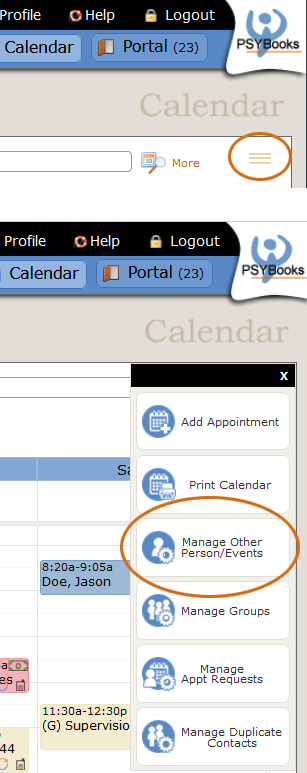 |
Where this isThe Manage Other Person/Events tool is accessed by clicking the hamburger menu at the top right corner of the Calendar page. The hamburger menu looks like this: |
When you click the Manage Other Person/Events tool, the window that opens looks something like this, depending on what Person and/or Event Contacts you've entered:
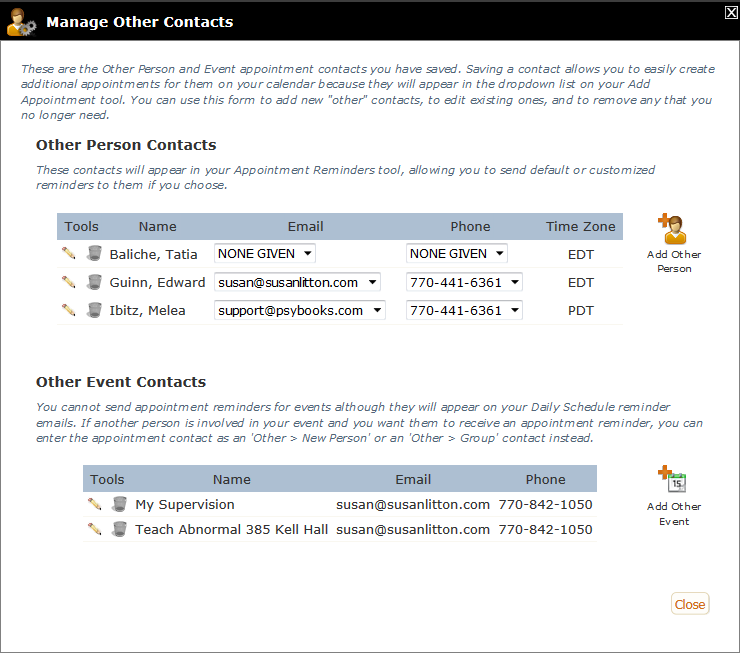
This tool allows you to add new contacts of either type, remove contacts you no longer need and edit existing contacts. Notice that Other Person Contacts can be scheduled for appointment reminders, whereas Other Event Contacts cannot. If you're scheduling an event with one or more individuals and you'd like to be able to send them appointment reminders, enter them as an Other > Person or an Other > Group contact instead.
Manage Groups
What this isThe Manage Groups tool allows you to add, edit and delete both therapy and non-therapy groups that you've added with the Add Appointment > Other > Add New Group tool.What it looks likeThe Manage Groups tool looks like this (dropdown appears after you click the hamburger menu on the top right of the Calendar page):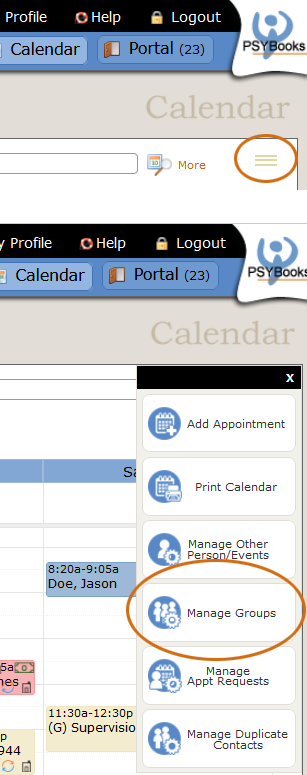 |
Where this isThe Manage Groups tool is accessed by clicking the hamburger menu at the top right corner of the Calendar page. The hamburger menu looks like this: |
When used with therapy groups, the Manage Groups tool allows you to schedule appointments for all clients at once, send appointment reminders, track group attendance, post a generic group note to each client's chart and enter sessions with individualized group notes. As you enter the session, you can also enter client payments and file insurance - all from the Manage Groups tool. You don't need to go to each client's chart separately for these tasks. Non-therapy groups are ideal for staff meetings, supervision, classes or other meetings where you might want to take notes, keep track of attendance and/or send appointment reminders to each person in the group.
When you click the Manage Groups tool, the window that opens looks like this (notice that video groups have a camera by their names so you can recognize them easily):
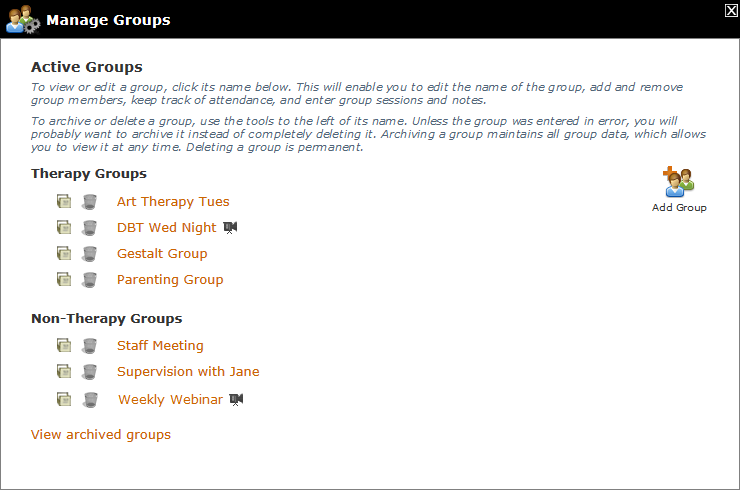
Although at first glance, this tool looks like it's primarily for archiving or deleting groups, it's actually a multi-tool for doing all tasks pertaining to your groups. Each of the separate tools will be discussed below:
- Add Group

The Add Group tool on the right of the form is another access point to the Add New Group link that's on the Add Appointment tool, i.e., Add Appointment > Other > Add New Group. No matter which access point you use, the tool looks like this:

More information on using the Add Group tool can be found above.
- Archive Group
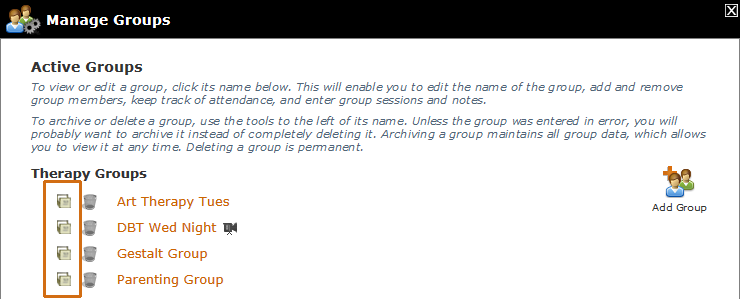
The Archive Group tool is the filing cabinet icon at the beginning of each group's row. It's used when you want to remove a group from your Active Groups list and yet keep all the records that are contained within the group. You can view or reactivate archived groups at any time.
- Delete Group
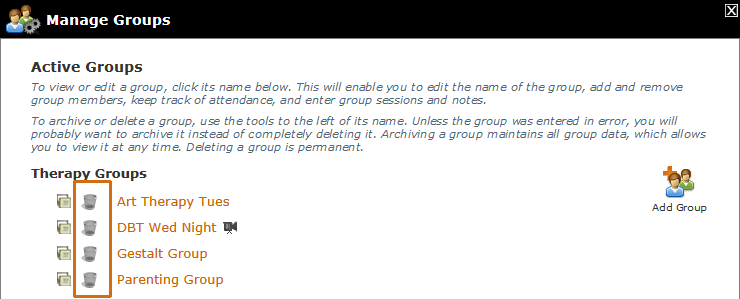
The Delete Group tool is the trash can icon next to the Archive Group tool. Delete Group should be used sparingly since deleting a group will permanently remove all records associated with the group. The Archive Group tool is often a better choice if you want to remove a group from your Active Groups page but maintain a copy of your records.
- Edit/Manage Individual Group
The Manage Individual Group tool is where you'll do most of the work for each group individually. You can access it by clicking the link of the group you want to open:

When the form opens, it looks like this - this is the tool you'll use for all functions needed for this particular group:
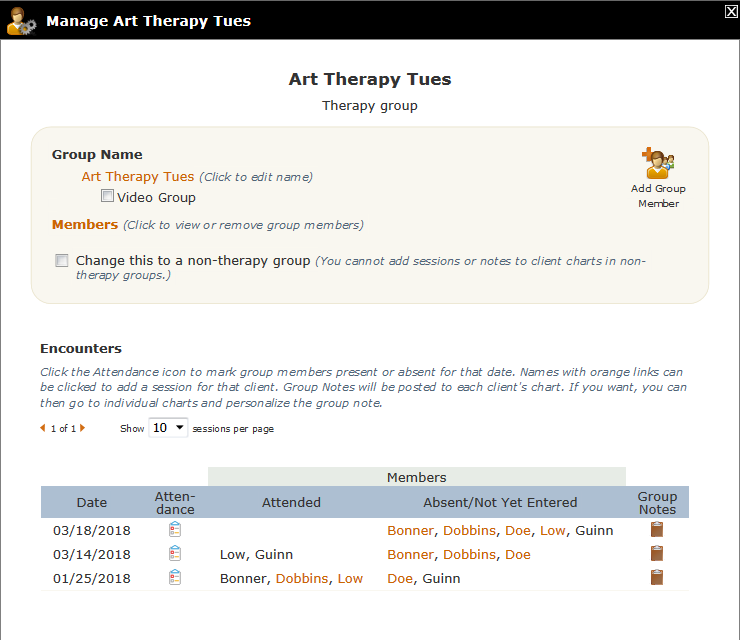
This multi-tool is comprised of several individual tools. You should be able to do most, if not all, of the tasks you need to do with your groups from this one tool. Each of the individual tools will be discussed below.
- Add Group Member
On the upper right is a tool for adding additional group members to your group:
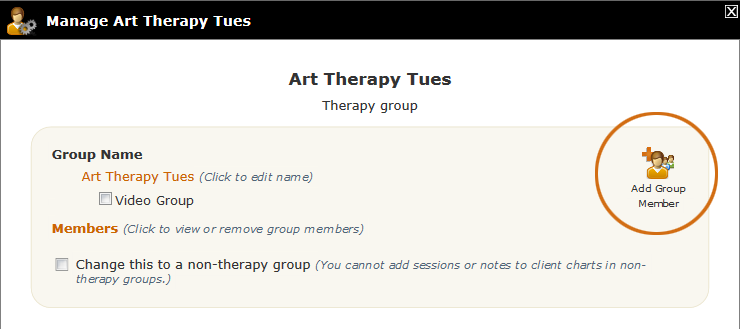
This tool differs from the tool you used when you created your group in that it adds members to this specific group. The group has already been created - you're just adding one or more new members to it. The tool looks like this:
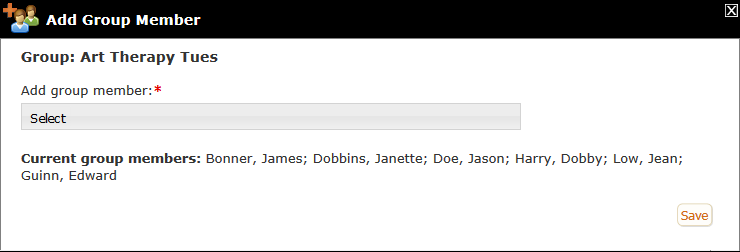
The current members of the group are listed at the bottom and are not included in the select box options.
- Edit Group Name
The name of the group can be edited by clicking the link under "Group Name":
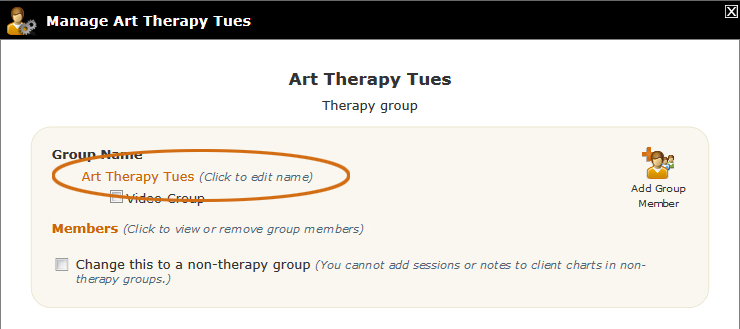
Clicking the name gives you a text input field where you can change it's name:

- Convert To/From Video
Beneath the group name is a checkbox where you can change this session to a video session. Or, if it's already designated as a video session (i.e., if the box is checked), you can uncheck the box and it will no longer be scheduled as a video session. Changes made here will sync with your SecureVideo account:
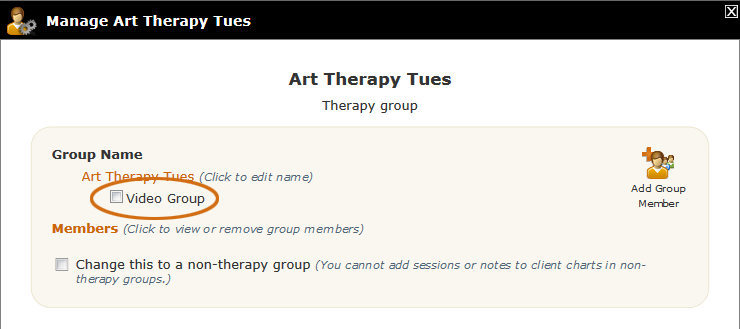
- View/Remove Group Members
You can view and remove current members of the group by clicking the "Members" link:
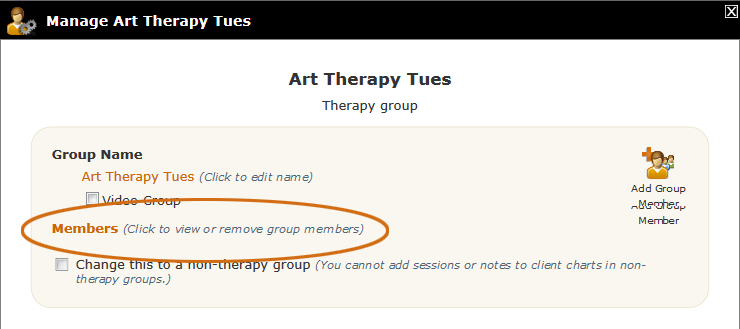
Clicking the link slides open a section that looks like this:
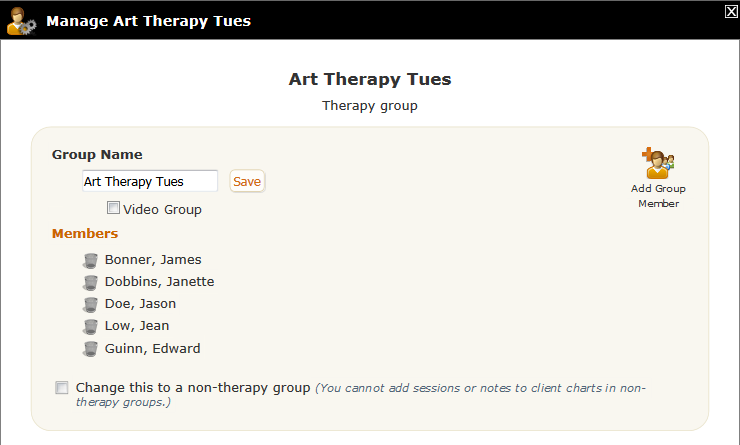
From this window, you can see all the members that are currently in your group and remove any that no longer belong. Clicking the trash can icon ONLY removes the person from your group. It does not delete them from anywhere else in the app.
- Change to Therapy/Non-therapy Group
The last tool in the shaded section of the Manage Groups tool is a checkbox that allows you to convert therapy groups to non-therapy groups and vice versa:
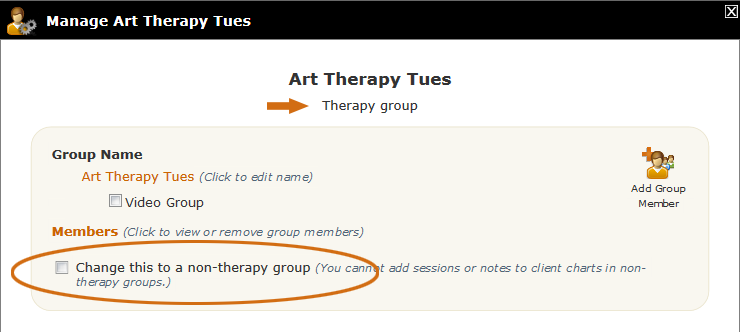
At the top of the form, right under the group's name, it will tell you whether this group is currently designated as a therapy group or a non-therapy group. You can check the checkbox and convert it to the other type. If a group doesn't have any clients, there is no difference between a therapy group and a non-therapy group. However, when one or more clients are in the group, designating it as a therapy group will allow you to enter sessions (with client payments), file insurance claims, and also add group notes to each group member's chart right from this tool.
The rest of the tools on this form pertain to the actual sessions or encounters the group may have had. Those tools are in the non-shaded section of the tool at the bottom and will be discussed below:
- Track Group Attendance
The table in the Encounters section at the bottom of the Manage Groups tool lists each scheduled group whose date has already past as well as the next upcoming group. (The upcoming group is a shaded row at the top to help you keep it separate from the others.) The first column in the green "Members" section of the table lists the group members that were marked as having attended the session. The second column in the Members section shows those who either didn't attend or who perhaps just haven't been entered yet.
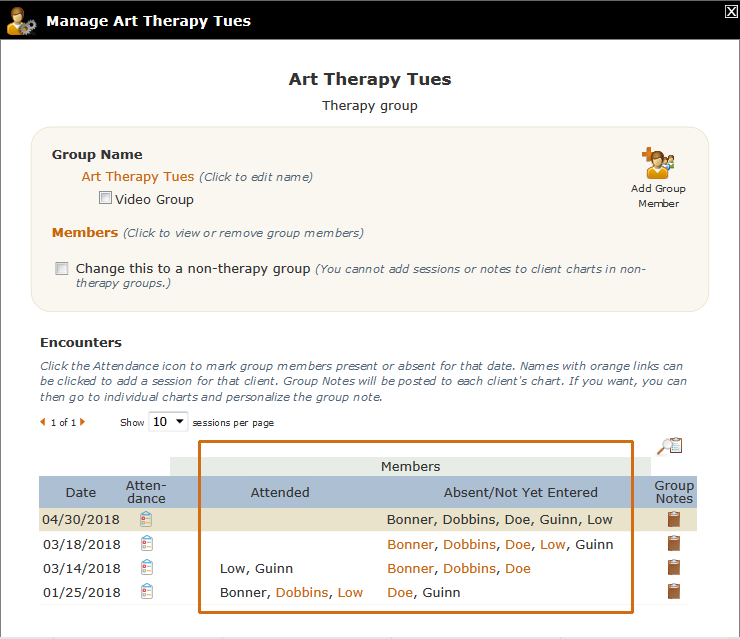
In the screenshot above, we can see that this group has met three times: 01/25/2018, 03/14/2018 and 03/18/2018. The next upcoming group, 04/30/2018, is listed in the shaded row. By looking at the two "Members" columns, we can see that Bonner, Dobbins and Low all attended the group on 1/25/2018; Low and Guinn attended on 3/14, and so far, either no one attended or no one has been entered for the 3/18 group.
To enter attendance, you use the Attendance tool, which appears on each row of the table to the left of the Members columns:
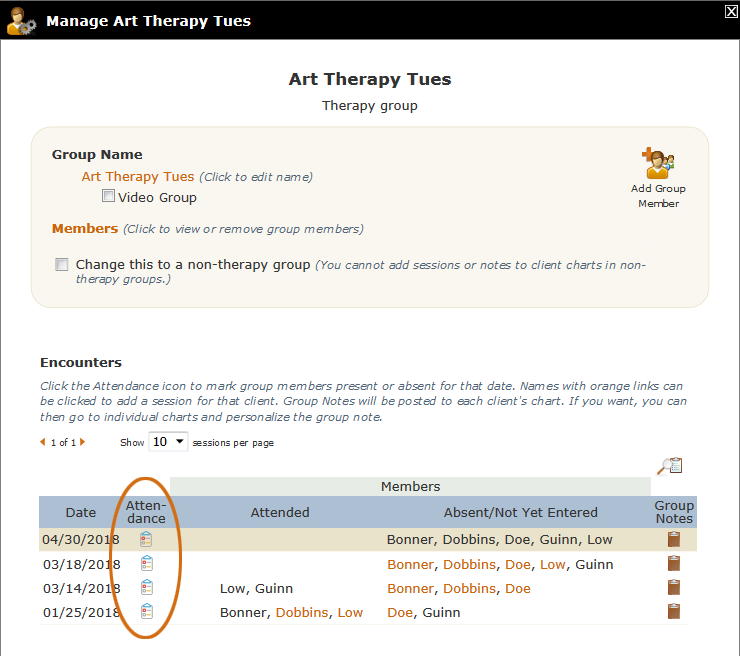
Clicking the Attendance Tool beside a session will open the attendance section for that particular date where you'll be able to see each group member's name beside a checkbox. You can mark which members were present - including using the checkbox in the blue header to select "All". The Attendance icon for the 3/18/18 group was clicked to produce the screenshot below:
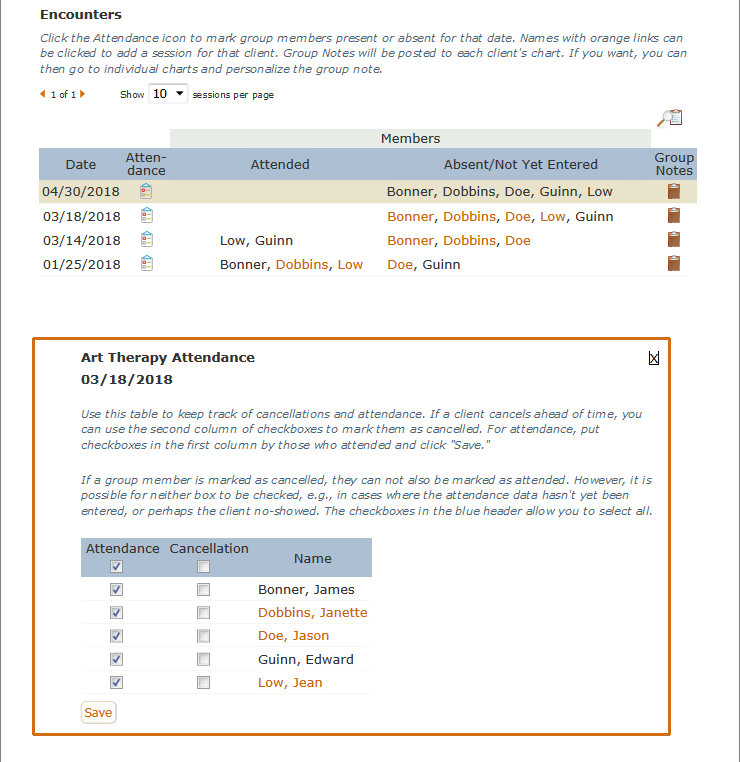
When you click "Save," names of the members who had checkboxes by their names will be moved to the "Attended" column. For example, from the screenshot above, if we had clicked the "Select All" checkbox at the top and then clicked "Save," the Encounters table would now look like this:
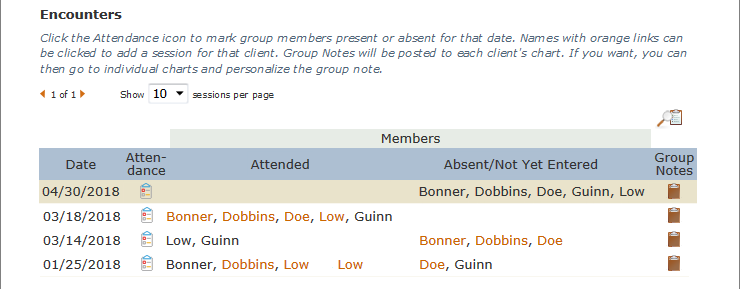
Notice that the Group Attendance form also has a way to mark cancellations for individual members with the second column of checkboxes on the form:
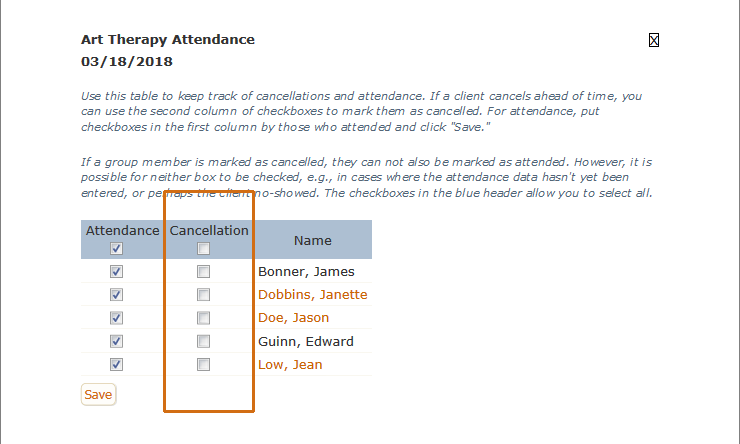
You can cancel sessions ahead of time or, if a member canceled and you forgot to mark it, you can also cancel them after the fact. When you click a checkbox in the cancel column, you get the kind of date range options you're used to seeing on a regular appointment cancel. This allows you to mark cancellations for individuals that need to miss several appointments in a row so you don't have to enter each one separately. In the screenshot below, we've marked James Bonner as canceled for the 3/18 Art Therapy group. Notice that an individual can't be marked BOTH as having attended and canceled, so by marking him canceled, the checkbox was automatically removed from the attended checkbox:
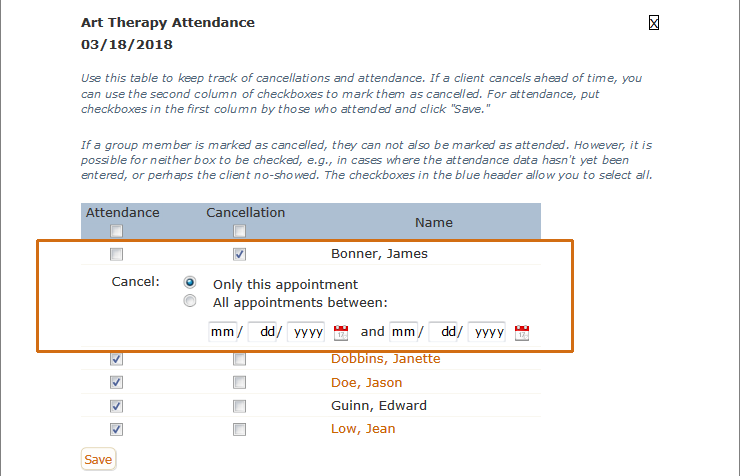
One of the values for having the upcoming group displayed is that it allows you to mark cancellations ahead of time. For example, during a group if a member tells you they'll be out of town and have to miss the next two groups, you can mark it right then so you don't forget. Because of the date range feature, you'll be able to mark the individual as canceled in both groups, even though only one group is visible in the Attendance Table.
- Add Sessions (Therapy Groups Only)
You may have noticed that some members' names in the Encounters tables use regular black fonts whereas others are orange - indicating that they are links. You will only see links in groups that have been designated as therapy groups, and only for clients - because the links are what allow you to add sessions right from the Manage Groups tool. For example, in the screenshot above, if we click Bonner's name for the 3/18 session, the Add Session form, pre-populated with his information, will open right from this tool. You don't have to leave the Manage Groups tool and go back to the Charts area to enter the client's session:
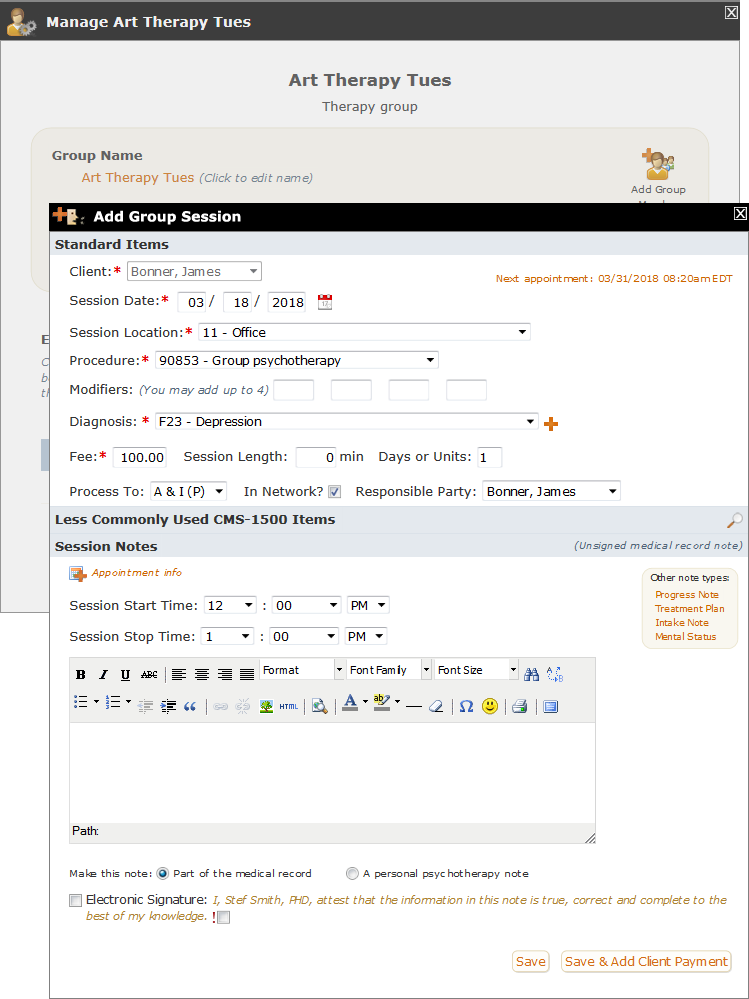
Notice in the black bar at the top, it now says "Add Group Session" instead of just "Add Session." Also, although you can add Group Notes to each client's chart (covered in the next section), if you want to add an individual group note for this client that would not be appropriate to post in everyone's chart, you can do it here as you regularly would with the Add Session tool. When added from the Manage Groups tool, a note written on the Add Group Session form will be listed in the Notes tab of the client's chart as an Individual Group Note.
Once you have saved the client's session, their name in the Encounters table for this session date will no longer be a link. This will allow you to use the Encounters table to visually keep track of which sessions you've entered and which you haven't. For example, after we save James Bonner's session above, the session form would close and the Encounters table would look like the screenshot below. Notice for the 3/18 group, the name "Bonner" is now just a regular black font, indicating that his session has already been added. However, Dobbins, Doe and Low still need to have their 3/18 sessions added.:
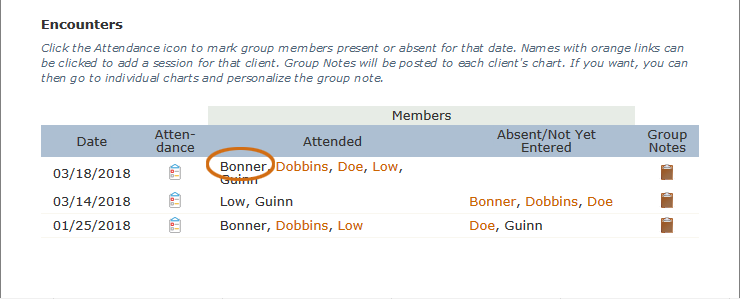
- Add Group Note
The Add Group Note feature can be found in the last column of the Encounters table:
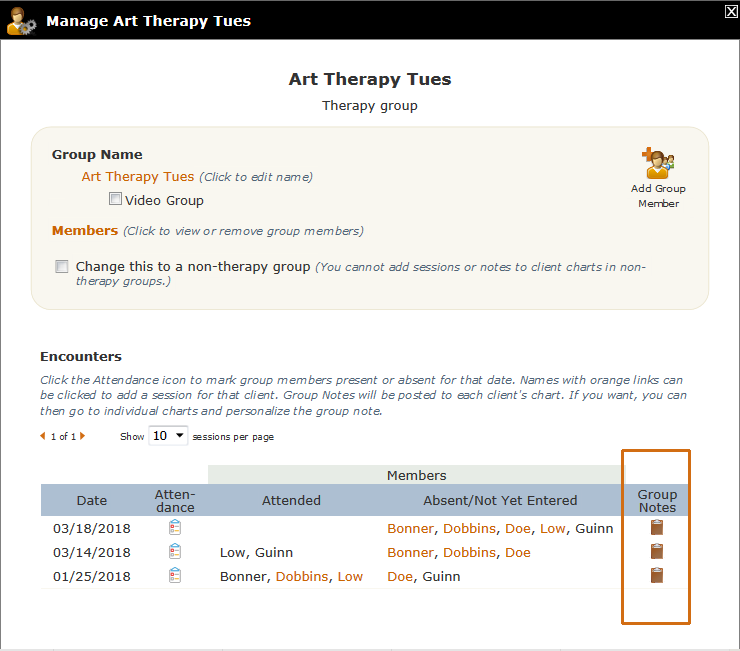
When you click a group note - let's say the one for the 3/18 group - the form that opens looks like this:
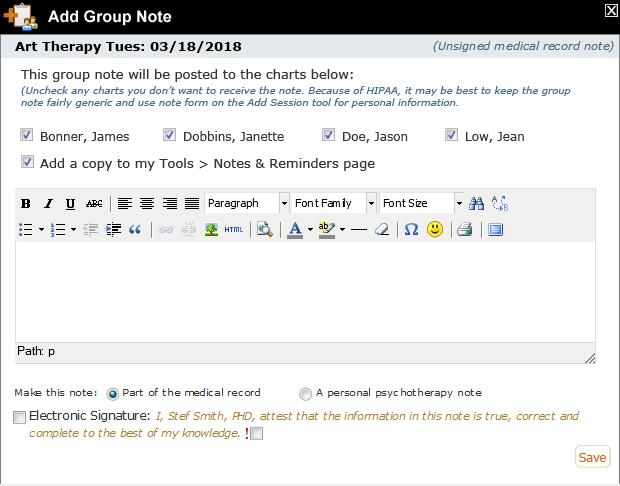
Notice at the top of the note, the four clients in this group - Bonner, Dobbins, Doe and Low - are listed, with checkboxes by each of their names. Although this group has another individual, Guinn, listed in the Encounters table, Guinn may be the facilitator or some other non-client group member, since their name is never presented as a link. Because of this, group notes cannot be posted for them so they are not included in this list. All client group member names are selected by default, but you can deselect any that didn't attend the group, or for whom you don't want to post the group note for some other reason.
Notice that there's also a checkbox that allows you to post a copy of the note to your "Tools > My Notes & Reminders" page if you wish. Doing this puts all of your notes for the group in one place so you don't have to open each group note separately to read them.
Write your note as you normally would, including any of the extras you want at the bottom (i.e, indicating whether the note is part of the medical record or your personal note, signing the note, and/or marking it as important.)
When you click "Save," the group note will post to the chart of each client whose checkbox was checked. This is unlike any other note in PSYBooks in that the same note gets posted to more than one client's chart. For this reason, although PSYBooks cannot offer legal advice, there may be HIPAA laws that govern what should and shouldn't be included in a group note. If you need to write specific information about certain individuals, you may want to write a somewhat generic group note for all, and then use the individual notes on the Add Group Session form discussed above for any more personal information you want to write. The screenshot below shows a client chart that has both a Group Note and an Individual Group Note posted. Following those, you can see a plain session note that was added with the regular Add Session tool, i.e., NOT the Add Session tool that's part of the Manage Groups tool:
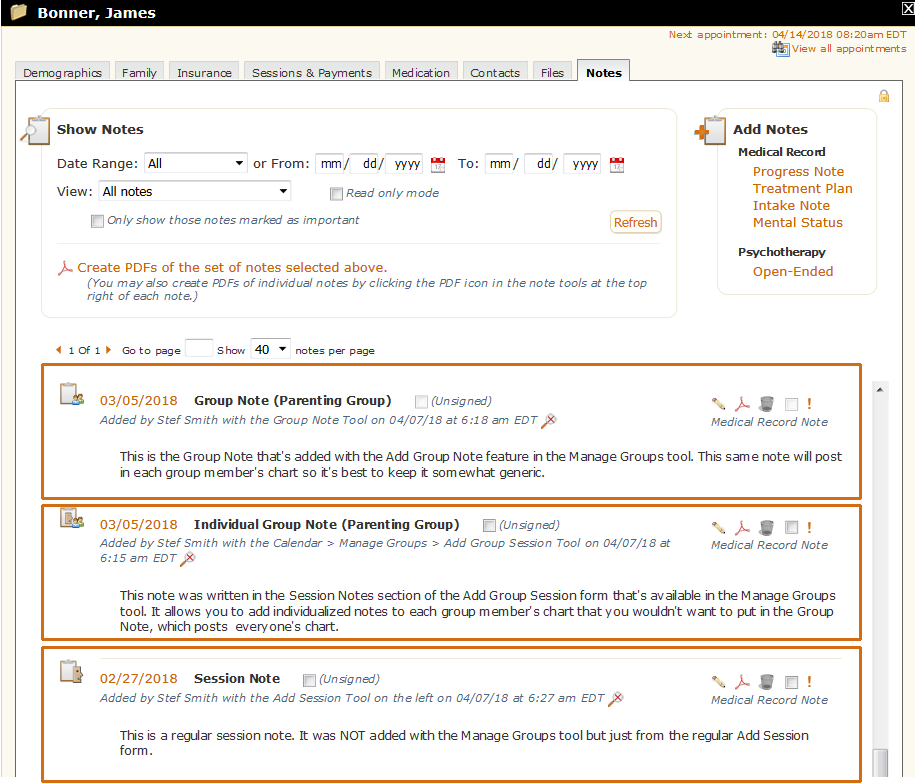
Most of what's been written so far about group notes pertains only to therapy groups. Group notes can also be useful for staff meetings, group or individual supervision appointments or other kinds of non-therapy groups where you may want or need to take notes. Group notes for non-therapy groups will only post to your Tools > My Notes & Reminders page and might look something like this:
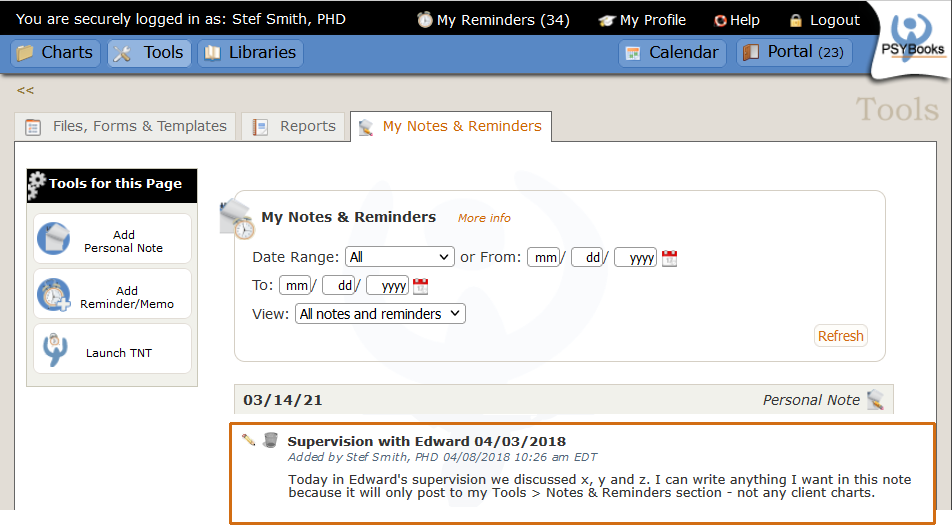
- Add Group Member
Manage Appointment Requests
What this isThe Manage Appointment Requests tool allows you to edit or delete any outstanding Appointment Requests to which the recipient has not replied.What it looks likeThe Manage Appointment Requests tool looks like this (dropdown appears after you click the hamburger menu on the top right of the Calendar page): |
Where this isThe Manage Appointment Requests tool is accessed by clicking the hamburger menu at the top right corner of the Calendar page. The hamburger menu looks like this: |
When you click the Manage Appointment Requests tool, the window that opens looks like this:
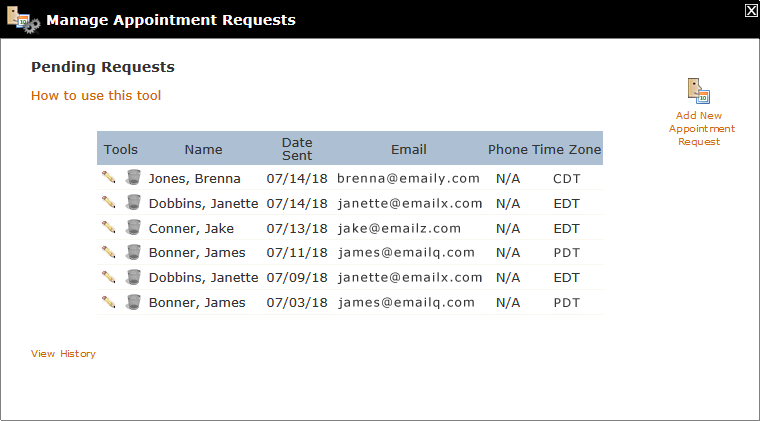
Notice that your Pending Requests are available in a table for you to see, but there's also a "View History" link at the bottom left that will allow you to see Archived Appointment Requests. For convenience, there's also a tool for adding a completely new Appointment Request at the top left. However, the more important parts of this tool are the two tables.
With the Pending Requests table, you can view, edit and delete any of your outstanding Appointment Requests. To be listed in this table, the Appointment Request must have at least one pending appointment time that the recipient would be able to choose. If the recipient has already chosen a time from that request, if the request has been canceled (by either recipient or therapist), if all times have been booked by others, or if the dates for all pending appointment times have passed, the Appointment Request will fall off of the Pending table and be moved to the Archived Requests table which can be found by clicking the "View History" link.
Each row in the Pending Requests table represents an entire request, which means it could include one time or many. If you click the Edit tool from one of the pending requests, it will open, allowing you to see exactly what was sent with that particular request. Notice that you may need to scroll forward in the calendar to find all of the times you sent:
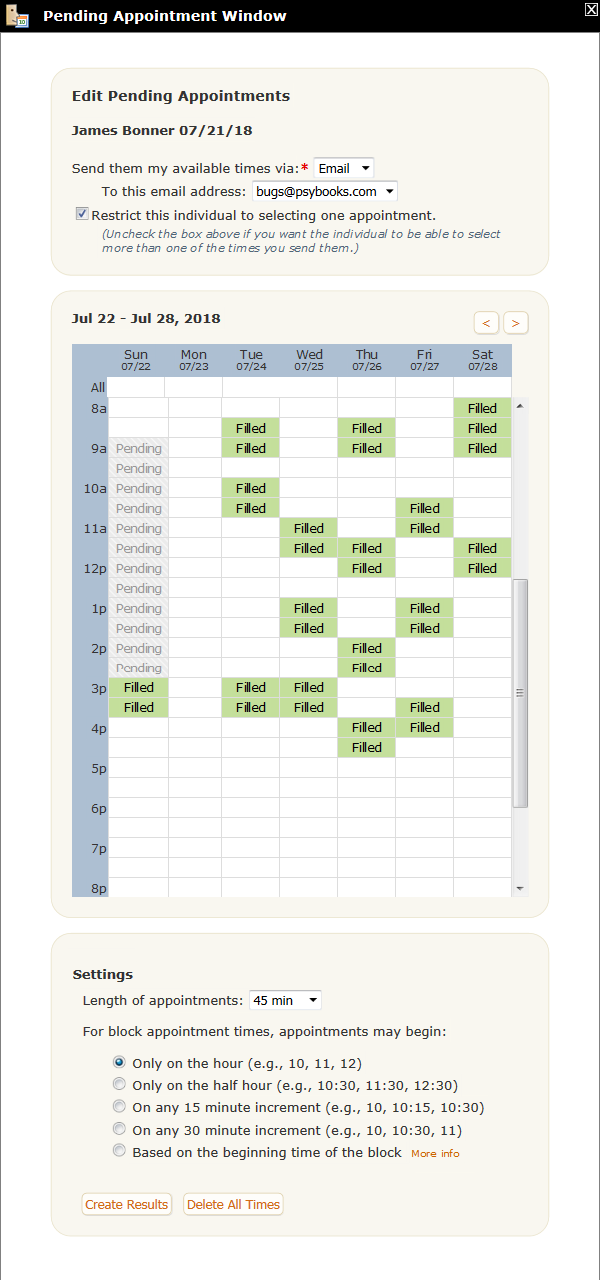
You can make any changes you want in the Edit window, then click "Create Results" to generate a new Appointment Request. Notice that by editing a Request, it will overwrite the original, not create a new one. If you'd rather send a new Appointment Request, you can use the "Add New Appointment Request" tool.
View History
All previous Appointment Requests can be found by opening the View History link. The Appointment Requests in this table allow you to view older Appointment Requests. When you click the View History link, the table that opens would look something like this:
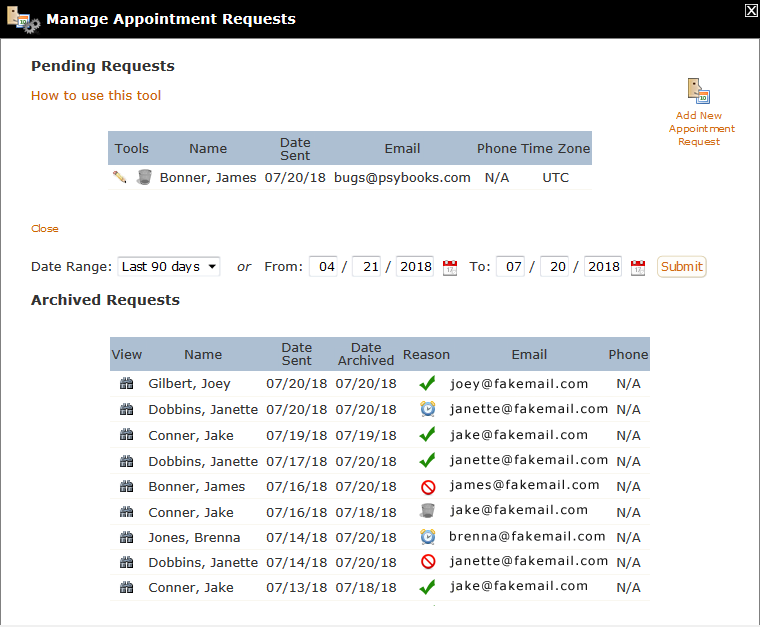
By default, archived Appointment Requests from the last 90 days are displayed. However, you can change the dates to whatever you want. You can click the binoculars to see the details of any original Request.
The Reason column lets you see at a glance the final disposition of that particular Appointment Request. The Reason column will have one of four different icons:
 A green check indicates that this Appointment Request was fulfilled, i.e., the recipient chose an appointment.
A green check indicates that this Appointment Request was fulfilled, i.e., the recipient chose an appointment. The clock icon means that the Appointment Request timed out before the recipient chose a time.
The clock icon means that the Appointment Request timed out before the recipient chose a time. The "No" icon means that all of the times sent were claimed by others before the recipient could choose one. This might mean that the therapist booked over the times and/or that other Portal Users did.
The "No" icon means that all of the times sent were claimed by others before the recipient could choose one. This might mean that the therapist booked over the times and/or that other Portal Users did. The trash icon means that the request was canceled. It could have been canceled by the therapist or the client.
The trash icon means that the request was canceled. It could have been canceled by the therapist or the client.
Manage Duplicate Contacts
What this isThe Manage Duplicates tool allows you to edit or delete duplicate contacts that may have inadvertantly been added to your account.What it looks likeThe Manage Duplicates tool looks like this (dropdown appears after you click the hamburger menu on the top right of the Calendar page): |
Where this isThe Manage Duplicates tool is accessed by clicking the hamburger menu at the top right corner of the Calendar page. The hamburger menu looks like this: |
When you click the Manage Duplicates tool, the window that opens looks like this:
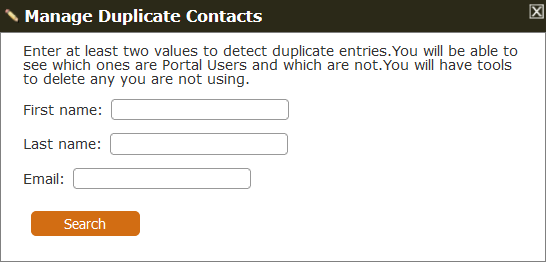
Enter at least two fields to check to see if you have more than one contact with those two values and then click "Search." Assuming you find matches, you'll get a window that looks something like this:
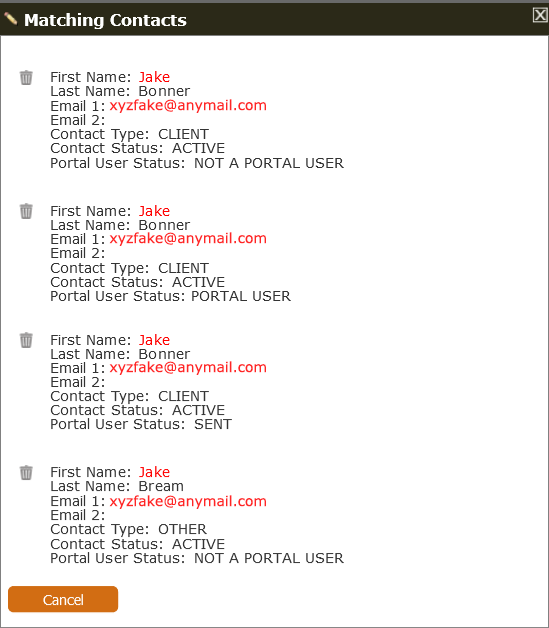
The user had entered two values - a first name of Jake and an email of xyzfake@anyemail.com. The Duplicates tool found 4 matches - 3 of them are for Jake Bonner. If the user had entered a last name of Bonner with the other two values, the tool would have provided this:
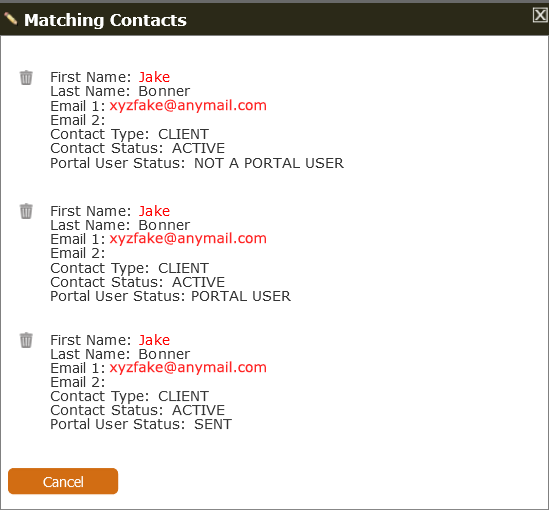
Here we can see that all 3 of these entries are for Jake Bonner and that the main difference between them is their portal user status. In one case, the client is a Portal User. In another, the invitation to join the portal has been sent, but the client has yet to respond. The remaining one has not yet received a Portal User invite. If you determine that these are all meant to be one person, you can delete the ones you don't need with this tool. If you're not sure which one you need to keep, you can go to the Charts page and change the last name a bit - like Jake Bonner1, Jake Bonner2, etc. Then, with the Duplicates tool, enter just first name and email and delete the ones you don't need.
There is a similar tool that appears if you're adding a new client or a new Person (Other > Person) and the program detects at least two fields in the new contact that matches an existing contact. You are shown the potential duplicates to ensure the duplications are intended. This tool allows you to add family members who share a last name and email address, e.g., for parents with small children who both want to be notified of all PSYBooks correspondence via a single email address.


